THE JOURNAL DEDICATED TO THE OBJECTIVES OF UNITED NATIONS SECURITY COUNCIL RESOLUTION 1540 for preventing the proliferation of weapons of mass destruction by non-state actors
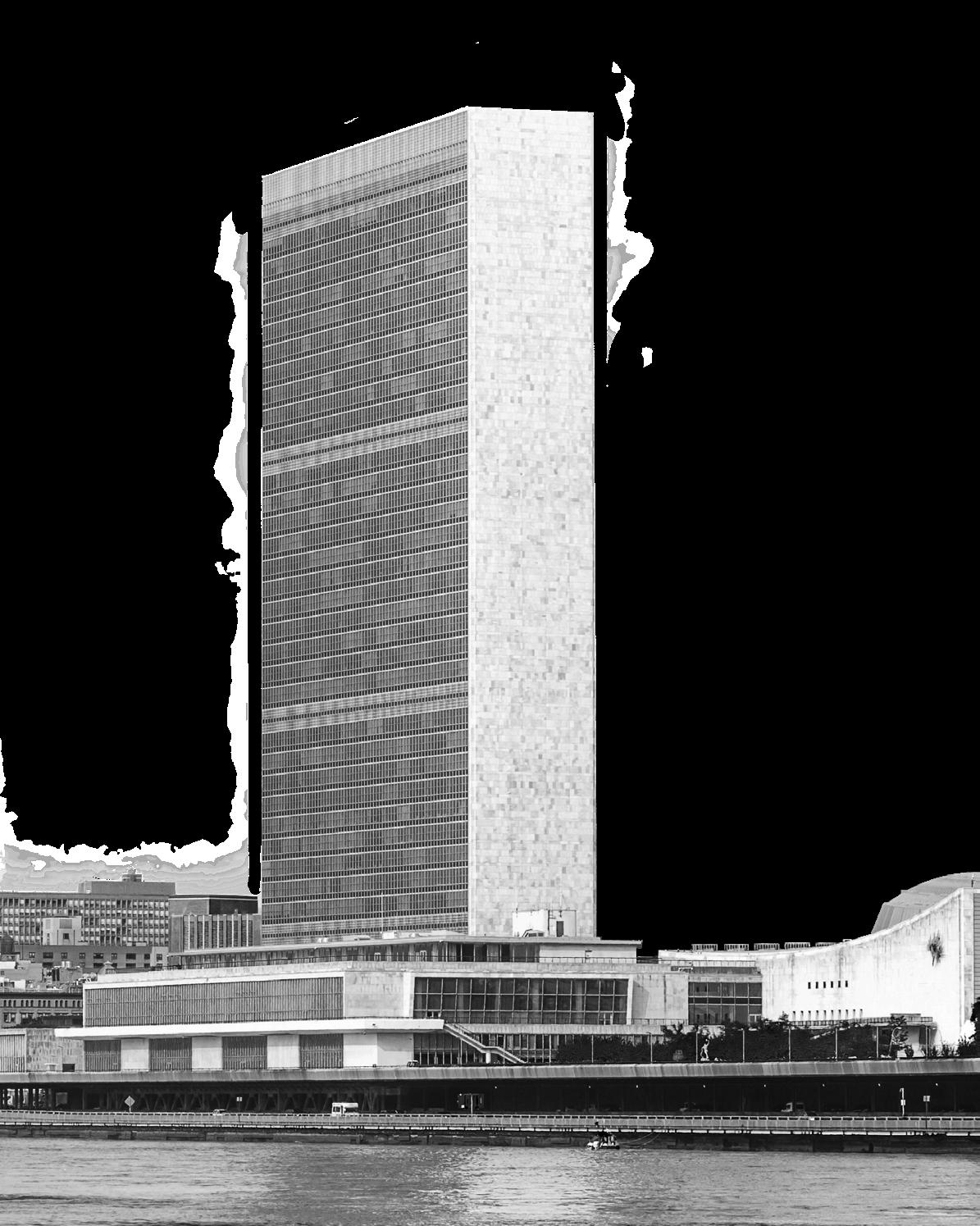
INTRO APRIL 2024 Issue
© UNICRI
2024 | April 2024
THE JOURNAL DEDICATED TO THE OBJECTIVES OF UNITED NATIONS SECURITY COUNCIL RESOLUTION 1540 for preventing the proliferation of weapons of mass destruction by non-state actors
ACKNOWLEDGEMENTS
EDITORIAL BOARD
Francesco Marelli, Editor-in-Chief | Carlotta Zenere, Programme Management Officer | Katy Carroll, Fellow
BOARD OF ADVISORS
Dr Karim Ben Ali, Director, Technological Watch and Foresight Department, Military Research Centre, Tunisia | Amanda Cowl, Regional Coordinator for Asia and the Pacific, UNODA
Nicolas Kasprzyk, European Diplomat, former 1540 Committee Expert | Dr Kiwako Tanaka, Associate Professor, Toyo Eiwa University, former 1540 Committee Expert | Dr Sarah Tzinieris, Research Fellow, Centre for Science and Security Studies, Department of War Studies, King’s College London | Dr Andrea Viski, Founder & Director, Strategic Trade Research Institute (STRI)
SPONSOR REPRESENTATIVE
Dr Todd Perry, Special Coordinator for UNSCR 1540, U.S. Department of State
If you wish to submit a letter to the Editor to be published in a future issue of the journal, or for any other enquiries, please contact: unicri-1540compass@un.org
You can find resolution 1540 in full here.
If you would like more information about the work of the 1540 Committee, please see: https://www.un.org/en/sc/1540/
Volume 1, issue 1, published 29 April 2024
Issue 1 | 20 YEARS OF RESOLUTION 1540
DISCLAIMER
The opinions, findings, conclusions, and recommendations expressed herein are those of the authors and do not necessarily reflect the views and positions of the United Nations and UNICRI, or any other national, regional or international entity involved. Contents of the publication may be quoted or reproduced, provided that the source of information is acknowledged. The designations employed and presentation of the material in this publication do not imply the expression of any opinion whatsoever on the part of the Secretariat of the United Nations concerning the legal status of any country, territory, city or area of its authorities, or concerning the delimitation of its frontiers and boundaries.
This publication was produced with the financial support of the Department of State of the United States. Its contents do not necessarily reflect the views of the Department of State. In order to ensure the sustainability of the journal, the 1540 Compass is looking for financial contributions from other Member States and international and regional organizations.
The 1540 Compass was originally launched in 2012 by the Center for International Trade and Security (CITS) at the University of Georgia in hard copy format. Under the initial direction of Dr Igor Khripunov, and in cooperation with the UN Office for Disarmament Affairs, the 1540 Compass was designed to provide an accessible forum on the effective implementation of UN Security Council resolution 1540. Back issues of the 1540 Compass can be found at: https://spia.uga.edu/ departments-centers/center-for-international-trade-and-security-cits/publications/compass/
INTRO



4 TABLE OF CONTENTS Note from the Editor: Francesco Marelli 6 Message from the Acting Director: Leif Villadsen 8 Resolution 1540 Timeline 10 INTERVIEWS Ambassador Mihnea Motoc 14 Ambassador José Javier De La Gasca 20 Dr Bilal Nsouli 30
INTRO 5 ARTICLE S The Impact of Resolution 1540 on Non-proliferation Architecture in the Past 20 Years by Kiwako Tanaka 38 UNSCR 1540: Improving Implementation to Ensure a Safer Tomorrow by Mara Zarka and Sarah Case Lackner 44 UNSCR 1540 Lessons Learned from the ‘Tending’ of the Biological Weapons Regime by Louison Mazeaud and James Revill 50 New Challenges to the 1540 Non-Proliferation Regime by Giuseppe Di Luccia 58 UN Security Council Resolution 1540 and the Chemical Weapons Convention: Challenges, Complementarities and Synergies by Rene Betancourt and Victor Calero 66 Linking CBRN and SALW Non-Proliferation: Looking Ahead at Potential Conjoined Risks by Erik Farkaš 72 Bioterrorism in National Counter-Terrorism Legislation: Developments since 2004 by Barry de Vries 78 Two Decades of UNODC’s Assistance to Member States to Meet UNSCR 1540 Obligations by Maria Lorenzo Sobrado 84 Implementing UNSCR 1540: The OSCE’s Role in Facilitating Peer Review Meetings by Adriana Volenikova and Tynchtykbek Israiilov 92 Strengthening Global Chemical Security: The Pivotal Role of the FBI’s Chemical and Biological Countermeasures Unit in Supporting Resolution 1540 by Allison Kirshner 100 E VENTS & NOTIFICATIONS 106
NOTE FROM THE EDITOR

EDITOR-IN-CHIEF | 1540 COMPASS
Francesco Marelli
UNICRI Head of Unit | CBRN Risk Mitigation and Security Governance
Dear Readers, Colleagues and Contributors,
It is with great pleasure that I welcome you to the inaugural issue of the 1540 Compass. Dedicated to advancing the objectives of United Nations Security Council resolution 1540 (UNSCR 1540) (2004) and its successor resolutions, the 1540 Compass aims to be a trusted source of knowledge, analysis, and dialogue for countering the proliferation of weapons of mass destruction (WMDs) and their means of delivery by non-State actors.
Adopted unanimously 20 years ago, on 28 April 2004, UNSCR 1540 stands as a cornerstone in global efforts to safeguard international peace and security. However, the challenges inherent in comprehending, implementing, and adapting to its provisions persist. As one of the six specialized research and training institutes of the United Nations and a member of the Global Counter-Terrorism Compact, the United Nations Interregional Crime and Justice Research Institute (UNICRI) is uniquely positioned to address this knowledge gap.
In light of this, UNICRI is proudly re-launching the 1540 Compass after an eight-year hiatus. First published in 2012 by the Center for International Trade and Security (CITS) under the direction of Dr Igor Khripunov, the 1540 Compass was designed as an accessible forum for enhancing the effective implementation of UNSCR 1540. Now, here at UNICRI, we wish to build and expand on this esteemed legacy.
Our vision for the 1540 Compass is bold and ambitious.
We aim to foster a space for robust knowledge exchange, insightful analysis, and meaningful dialogue among Member States, academic experts, policymakers, practitioners and followers of
Issue 1 | 20 YEARS OF RESOLUTION 1540 6
everything resolution 1540 related. The 1540 Compass promises to be a platform for everybody, and we encourage all stakeholders involved in non-proliferation to leverage it. The success of the 1540 Compass lies in the widest participation of us all. By sharing best practices and nurturing discussion in this collaborative manner, the 1540 Compass will contribute to global efforts to counter the grave threat of WMD proliferation and reinforce international peace and security.
We have dedicated this issue to “20 Years of UNSCR 1540”, with two timelines showcasing the resolution’s evolution over the past two decades. We also benefitted from interviews with three key stakeholders from the resolution’s past, present and future: Ambassador Motoc, the inaugural Chair of the 1540 Committee; Dr Nsouli, Director General of the Lebanese Atomic Energy Commission; and, speaking in his national capacity, Ambassador De La Gasca, the current Chair of the 1540 Committee.
A wide variety of contributors submitted articles which reflect on the past 20 years of the resolution. Many focus on the evolution of different facets of the resolution, such as the biological or chemical components and their corresponding conventions. This issue therefore features a diverse array of articles touching upon critical themes such as the impact of UNSCR 1540 – as well as the successes and challenges of its implementation – over the past 20 years, with a view to offering improvements for the future. And finally, in the spirit of collaboration, international organizations have also contributed to this issue, embodying inclusive dialogue that we strive to foster.
I would like to offer my heartfelt thanks to all the contributors who have so willingly shared their knowledge and time. I also extend my deepest gratitude to our esteemed board of advisors and our generous donor, the US Department of State, whose unwavering support has made the revival of the 1540 Compass possible.
I encourage you, our readers, to actively engage with the 1540 Compass by submitting articles, event notifications and any other tool or resources that can benefit our publication. Let us continue this strong start as we look towards the next issue, which is slated for publication in September and will focus on border, export and trans-shipment controls. We will post a renewed call for contributions in the coming weeks on our website and social media channels, with further details on the theme.
Warm regards,
Francesco Marelli
7 INTRO
MESSAGE FROM THE ACTING DIRECTOR
 ACTING DIRECTOR, UNICRI
Leif Villadsen
ACTING DIRECTOR, UNICRI
Leif Villadsen
This year marks the 20th anniversary of the adoption of United Nations Security Council resolution 1540 (2004) (UNSCR 1540), a key pillar of the international security landscape and non-proliferation architecture. When it was adopted in 2004, the resolution formed part of the collective, international response in the face of Abdul Qadeer Khan’s nuclear proliferation network and a growing number of terrorist attacks. It aimed to prevent the proliferation of weapons of mass destruction (WMDs) and their means of delivery by non-State actors.
Today, with rising political instability and global insecurities, the threat of violent non-State actors – especially terrorists and organized criminal syndicates –, acquiring and using nuclear, chemical, and biological weapons, as well as their related materials, remains of significant concern. As a result, this landmark resolution continues to play a pivotal role in safeguarding international peace and security.
UNICRI – one of the six specialized research and training institutes of the United Nations – is mandated to advance understanding of crime-related problems, foster just and efficient criminal justice systems, support respect for international standards, and facilitate international law enforcement cooperation and judicial assistance. In line with its mandate, UNICRI contributes to global efforts to reduce the risk posed by WMDs through the wide range of action-oriented research and needs-based initiatives that it implements.
It is within this context that I am delighted, as the Acting Director of UNICRI, to introduce this inaugural issue of the 1540 Compass. This new e-journal comprises one of the ways in which the Institute is committed to advancing the objectives of UNSCR 1540 and bolstering the global non-proliferation framework. The publication aims to shed light on the impact, challenges and
Issue 1 | 20 YEARS OF RESOLUTION 1540 8
opportunities of UNSCR 1540, as well as the work of the 1540 Committee. It also seeks to establish a dynamic platform for international dialogue and knowledge exchange among Member States, experts, practitioners, and organizations involved in implementing UNSCR 1540. Moreover, it will enable us to stay abreast of emerging trends, threats and risks. I trust that it will generate informed discussions and actionable insights that can help us forge better collective understanding of the field of non-proliferation as it stands today.
I extend my sincere gratitude to all contributors, readers, supporters and of course the 1540 Compass editorial team for this shared commitment to advancing the objectives of UNSCR 1540.
Leif Villadsen
Acting Director, United Nations Interregional Crime and Justice Research Institute (UNICRI)

INTRO 9
UNICRI Headquarters, Turin, Italy
RESOLUTION 1540 AND ITS SUCCESSOR RESOLUTIONS
United Nations Security Council resolution 1540 was adopted 20 years ago, on 28 April 2004. However, this unique resolution does not stand alone. It has been succeeded by several other resolutions, which have either extended or better defined its mandate. In celebration of the resolution’s 20th anniversary, you will find a summary of resolution 1540 and some of its key successor resolutions.
Resolution 2663 (2022) 30 NOVEMBER 2022
Resolution 2663 (2022) extends the mandate of the 1540 Committee until November 2032. It calls for two more comprehensive reviews of implementation status and stresses the importance of tailored dialogue and engagement with Member States.
15 DECEMBER 2016
Resolution 2325 (2016)
Resolution 2325 (2016) emphasizes the need for continued efforts at the national, regional, and international levels and stresses the importance of controlling access to technology that could be used for weapons of mass destruction.
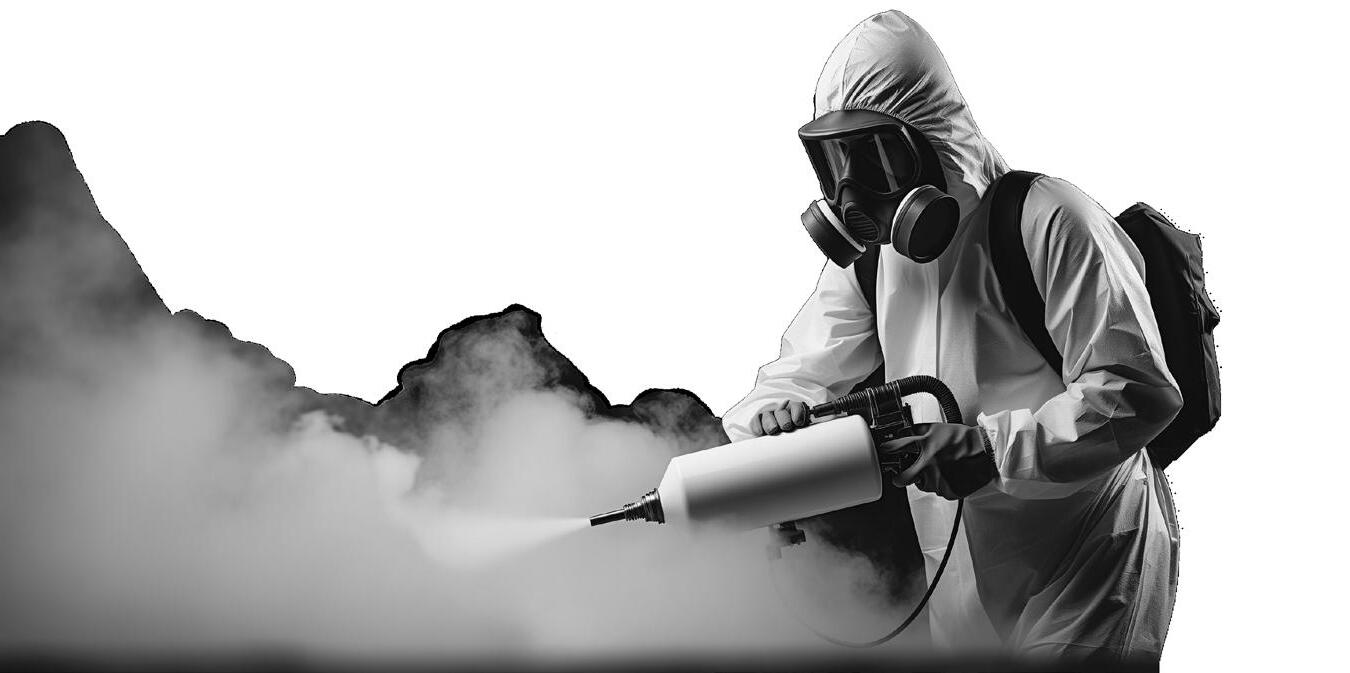
10 Issue 1 | 20 YEARS OF RESOLUTION 1540
of Resolution 1540 2023 2022 2021 2020 2019 2018 2017 2016 2015 20242004
Resolution 1540
The UN Security Council passes resolution 1540! It declares the spread of nuclear, chemical, and biological weapons and their means of delivery a threat to international peace and security and mandates States to prevent non-State actors from obtaining, developing, or using such weapons, in particular for terrorist purposes.

Resolution 1810 (2008) extends the 1540 Committee's mandate for an additional three years, with the added support of a group of experts for the first time. 28 APRIL
Resolution 1810 (2008)
(2011)
Resolution 1977 (2011) extends the mandate of the 1540 Committee for another 10 years and calling for two more comprehensive reviews of its implementation status.
11 2005
2004
Resolution
25 APRIL 2008 2006 2007 2008 2009 2010 2011 2012 2013 2 0 1 4 20242004 20 APRIL 2011 TIMELINE
1977
COMPREHENSIVE REVIEWS
As part of their obligations under operative paragraph 4 of resolution 1540 (2004), the 1540 Committee is mandated to periodically report on the implementation of the resolution to the Security Council. As a result, the Committee has so far conducted three comprehensive reviews on the status of implementation, in addition to three periodic reviews conducted in 2006, 2008 and 2011. The comprehensive reviews take place over the course of the year, and involve numerous meetings and events, including open consultations with all Member States. Towards the end of the year, a report is published which summarizes the conclusions of the review and offers recommendations for improving implementation.
CHAIRS OF THE 1540 COMMITTEE
The Chair, chosen from one of the non-permanent members of the Security Council, plays a crucial role in guiding the Committee. Once elected, the Chair usually serves for a period of two years.


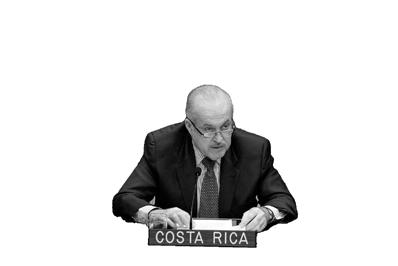





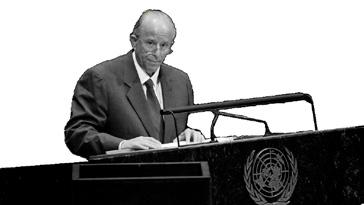


12 2004 - 2005 2006 - 2007 2008 - 2009 2011 - 2012 2013 - 2014 2010
CHAIR ROMANIA
Jorge Urbina
Peter Burian
CHAIR SLOVAKIA
Kim Sook
Oh Joon
CHAIR REPUBLIC OF KOREA
Baso Sangqu
CHAIR SOUTH AFRICA
Claude Heller
CHAIR MEXICO
CHAIR COSTA RICA
Issue 1 | 20 YEARS OF RESOLUTION 1540
2009
The 2009 Comprehensive Review highlights significant global efforts to prevent non-State actors from acquiring weapons of mass destruction, with over 160 Member States reporting measures taken since 2004.
2016
The 2016 Comprehensive Review concludes that progress has been made in implementing resolution 1540 (2004), yet achieving full implementation remains an ongoing challenge. Seventeen States have yet to submit their first national reports.
2022
The 2022 Comprehensive Review reaffirms that, despite progress, full implementation of resolution 1540 (2004) remains a long-term task, with challenges including financial and technical constraints. Only eight States have yet to submit a first national report and the notification of points of contact has increased from 94 to 137.





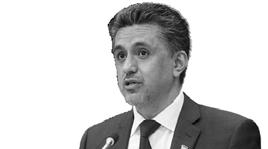




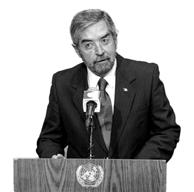

13 2019 - 2020
2014 2015 - 2016 2017 - 2018 2019 - 2020 2021 - 2022 2023 - 2024
Román Oyarzun Marchesi
CHAIR SPAIN
CHAIR INDONESIA
KOREA
Sacha Sergio Llorentty Solíz
CHAIR PLURINATIONAL STATE OF BOLIVIA
Juan Ramón de la Fuente Ramírez
CHAIR MEXICO
José Javier De La Gasca
Hernán Pérez Loose
Andrés Efren Montalvo Sosa
TIMELINE
CHAIR ECUADOR
INTERVIEW WITH:
Ambassador

Issue 1 | 20 YEARS OF RESOLUTION 1540
Shaping United Nations Security Council Resolution 1540:
Twenty years after it was first adopted, United Nations Security Council resolution 1540 (2004) stands as a cornerstone in the global security architecture. Its provisions mandate all States to adopt and enforce legislation to prevent the proliferation of weapons of mass destruction (WMDs) and their means of delivery to non-State actors. Yet, despite the crucial issues it addresses, its long-term standing and impact was not guaranteed at the outset. The resolution’s successful implementation has been carefully guided by the 1540 Committee, formed by the members of the Security Council and chaired by a different member on two-year rotating basis.
At the Committee’s helm during its first two formative years was Ambassador Mihnea Motoc of Romania, whose leadership and diplomacy laid the foundation for the Committee’s continued work to combat the proliferation of WMDs. Ambassador Motoc’s tenure as the first chair of the 1540 Committee coincided with a period of heightened global concern regarding the proliferation of WMDs. In the aftermath of the 9/11 terrorist attacks and amidst growing apprehensions about the spread of nuclear, chemical, and biological weapons, the international community recognized the urgent need for coordinated action.
Ambassador Motoc has had a distinguished diplomatic and governmental career, which – aside from his appointment as the Permanent Representative of Romania to the UN and the Chair of the 1540 Committee – has included appointments as the Permanent Representative of Romania to the EU and the Minister of Defence of Romania (2015–2017). In this interview, he offers his insights into the origins, challenges, and accomplishments of the 1540 Committee, as well as sharing other learnings from his impressive international experience.
INTERVIEW 15
THE 1540 COMMITTEE’S INAUGURAL CHAIR
Can you provide insights into the broader geopolitical context at the time of establishing UNSCR 1540?
Let me first recall the facts dating back to the early 2000s, when arguably the most salient concerns related to the serial proliferation shocks generated by non-State actors, involving illicit transfers of nuclear material and equipment to DPRK, Iran and Libya – among which the revelation of the A.Q. Khan network was probably the most far-reaching –, acts of terrorism –culminating with 9/11 – and the growing menace of nuclear terrorism.
The 2003 Proliferation Security Initiative (PSI) came as an initial and immediate response. However, it was non-binding in character and limited in scope, in the sense that the informal commitments it was based on were taken by only those States willing, capable and prepared to interdict proliferation-related shipments.
It was clear that a formal, legally binding, more inclusive and less flexible structure needed to be put in place. Additional measures to prevent the proliferation of WMDs and related materials and technologies were necessary.
The geopolitical context surrounding this growing concern with WMD proliferation to non-State actors, as reflected also in the atmospherics within the Security Council, was returning to a more cooperative and trustful matrix, as the strains around the second Iraq war were gradually subsiding. While the UN itself appealed to many as the locus for forging effective collective responses to global challenges, enlightened US leadership was once again effectively delivering.
Reflecting on the initial years of the 1540 Committee’s establishment, what were some of the prevailing attitudes among Member States and the international community towards non-proliferation efforts, and how did these attitudes influence the Committee’s early activities and strategies?
It was of paramount importance that UNSCR 1540 was adopted by unanimity, under Chapter VII – thereby affirming that the proliferation of WMDs and their means of delivery constitutes a serious threat to international peace and security. It was the second only such resolution to invoke those provisions without any tie to a specific time or place.
With resolute US leadership, the draft had received full support from France and UK, and eventually commanded buy-in from all the members of the Council at that time, thus overcoming certain concerns essentially related to the placing of the resolution under Chapter VII, and to the appropriateness of the Council taking decisive action in this sensitive area on behalf of the whole of the United Nations.
This bold attempt to ameliorate and bridge some gaps in the extant international non-proliferation regime was largely made possible by a conducive global political climate, in which there was increased awareness among States – including those which do not possess WMDs or related material and technologies – of the risks related to the spread of WMDs and related technologies. They had also grown more adept at preventing such risks from materializing, and more capable of discouraging others from engaging in nuclear proliferation.
Issue 1 | 20 YEARS OF RESOLUTION 1540 16
The considerable investment placed in the drafting and negotiating stages in securing the widest possible buy-in was followed on with a resolute emphasis at the time of the setting up of the 1540 Committee on promoting, to the greatest extent possible, transparency and inclusiveness, and conducting meaningful, ample outreach.
As the first chair of the 1540 Committee, can you share some insights into the early challenges and obstacles faced in establishing the framework of UNSCR 1540 and mobilizing international cooperation towards non-proliferation goals?
The setting up of the 1540 Committee took a couple of months, which were devoted to discussing indispensable elements for effectively launching its activity, such as the work programme, working procedures, submission of national reports and the hiring of experts.
As the establishment of Security Council committees requires agreement by all members, it was only to be expected that some of the reservations voiced in the Explanation of Vote (EOV) at the time the founding resolution was adopted would be echoed in the setting up of the 1540 Committee. More generally, it took a lot of convincing to overcome a certain reluctance which persisted on the part of States, which were required to do things they have never done before.
Reflecting on the achievements of UNSCR 1540 over the years, what do you consider to be the most significant milestones or successes in preventing the proliferation of weapons of mass destruction and their means of delivery?
The resolution filled a major gap in the international non-proliferation regime by providing legal basis to counter and prosecute non-State actors engaged in WMD-related materials and technologies. All UN Member States were asked to enact legislation for criminalizing proliferation, and to institute effective checks against WMD proliferation within their borders through international collaboration.
The 1540 Committee’s work throughout the years has led to a considerable increase in the record of State compliance with the provisions of the resolution, and a significantly higher degree of alignment of national legislations needed to prevent and combat acts of proliferation, for instance by harmonizing international and national export controls.
The two comprehensive reviews of the resolution’s implementation have both evidenced that its provisions have been widely observed by the international community and that they effectively contributed to the creation of functioning regulatory regimes.
As far as the European Union is concerned, it has taken steps to integrate, as early as 2003, a non-proliferation clause in its Common Foreign and Security Policy.
There is, however, no room for complacency here, as the number, capabilities and transnational connections of susceptible non-State actors, as well as the global availability of dual-use materials, are on the rise. The Committee needs therefore not only continue its oversight of national safeguards against WMD proliferation to non-State actors, but also ensure the proper correlation and adjustment of preventive efforts to the changing and evolving threats.
INTERVIEW 17
Could you share insights into how the experiences and lessons learned in your role as the first Chair of the 1540 Committee have informed or influenced your subsequent work in the field of international diplomacy?
Essentially, I took away two main lessons from the 1540 Committee days. First is that even in the thorniest and most sensitive of areas, international and multilateral cooperation is possible and ultimately always pays off, provided that it is carefully and persistently organized. Secondly, ever since serving as Chair of this seminal Committee, I am always poised to investigate the WMD proliferation angle of even the most conventional of security environments I am dealing with.
How do you perceive the evolving role of the 1540 Committee in adapting to the changing global landscape concerning non-proliferation efforts?
While I have not been in a position to continue to follow closely the most recent evolutions in the life of the 1540 Committee, I remain persuaded that the great value of the Committee relates to its ability to persistently foster the criminalization of proliferation acts. It has thus become a cornerstone of the overall global nonproliferation regime, enabling resolution 1540 to stay firmly on track and complementing other initiatives such as the PSI, the Convention on the Physical Protection of Nuclear Material, its Amendment and the International Convention to Supress Acts of Nuclear Terrorism.
It is precisely this role of lynchpin of the global non-proliferation regime, as well as its
universality, that should be safeguarded as extremely valuable in a global climate that is radically different from that prevailing at the time of its launch, given that we are now confronted with a multi-front situation, a mushrooming of conflicts and crises spanning most of the globe, great power contestation (fuelled by the race to achieve advanced technological superiority), unprecedented disruptions of the global order as we have known it for over seven decades, and – what is most relevant to the point here – the progressive erosion of arms control and the loss of strategic stability at the macro level.
Considering the complexities of emerging threats and risks related to WMD proliferation, what strategies do you believe the international community should prioritize to enhance the effectiveness of UNSCR 1540 and related non-proliferation initiatives?
UNSCR 1540 is an invaluable connecting dot in the web of UNSCRs, bridging those dealing with counter-terrorism and non-proliferation. It is of particular benefit in curbing the proliferation of biological weapons/agents, as the relevant Convention (the BWC – Biological Weapons Convention) lacks any implementation and verification body.
Ultimately, there are two conceivable strategies that would help preserve the unique value of the regime and discipline put in place by UNSCR 1540: on the one hand, provide a basis for strengthening States’ reporting on actual enforcement compliance with a view to getting a more realistic picture of the implementation progress; on the other, generate global consensus to insulate the 1540 ecosystem from the impact
Issue 1 | 20 YEARS OF RESOLUTION 1540 18
of the current challenges to the global rulesbased order and the narrowing down of the space for international cooperation and understanding, since it is undoubtedly playing to the benefit of most, if not all, governments.
Drawing from your experience as the inaugural Chair of the 1540 Committee, what advice would you offer to future chairs in effectively advancing the objectives of UNSCR 1540 amidst evolving global challenges?
The global security environment has considerably deteriorated since the adoption of UNSCR 1540. While the painful memories of the terrorist attacks in Paris, Istanbul, Mogadishu, Brussels and London, as well as the series of “lone wolf” strikes, are still vivid, we need to remain alert to the fact that presently the potential for major such attacks is even further magnified by the proliferation of wars and conflicts. Complex security dynamics in different regions of the world – which generate at the same time increased fragmentation and polarization in our societies – multiply the opportunities for malicious intervention by non-State actors.
This increasingly more precarious background (including the fragilization of arms control, along with the considerable assault on the rules-based global order), combined with the ever-greater accessibility, equipment- and knowledge-wise, of nuclear, biological and chemical components, as well as the ever-greater possibilities of cyber/ AI-enabling of any kind of weaponry, is likely to severely increase the risks of WMD proliferation.
Against this backdrop, future chairs of the 1540 Committees can only double down on stimulating
the collaborative efforts among States, and relevant international, regional and sub-regional organizations, which have made the progressive implementation of resolution 1540 possible.
Distinguished representatives who will serve in this demanding position will need to constantly engage in a full horizon-scanning of ever faster geopolitical, political and technological changes to make optimal use of the potential that the 1540 Committee has been given to serve as a bulwark against WMD proliferation.
Even in the thorniest and most sensitive of areas, international and multilateral cooperation is possible and ultimately always pays off.
INTERVIEW 19
INTERVIEW WITH:
Ambassador José Javier De La Gasca

Issue 1 | 20 YEARS OF RESOLUTION 1540
Charting the Path to Non-Proliferation: Ambassador De La Gasca’s Insights on UNSCR 1540
To celebrate the relaunch of the 1540 Compass and the 20th anniversary of United Nations Security Council resolution 1540 (2004) (UNSCR 1540), the 1540 Compass is honoured to present a two-part interview series with the current Chair of the 1540 Committee, H.E. José Javier De La Gasca, speaking in his national capacity as Permanent Representative of Ecuador to the United Nations. With a nuanced understanding of the complexities of global security thanks to his extensive professional experience, Ambassador De La Gasca offers invaluable insights into the achievements of UNSCR 1540 and the immediate priorities of the Committee under his stewardship in this first instalment.
Ambassador De La Gasca holds a master’s degree in Criminalistics and Forensic Sciences, as well as having diplomas in legal argumentation from academic institutions in the United States and Spain. He is also a former fellow of the Leadership for Global Competitiveness Program from Georgetown University.
Prior to his appointment as the Permanent Representative of Ecuador to the United Nations and the Chair of the 1540 Committee on 1 December 2023, Ambassador De La Gasca held various roles in both public and private entities, including serving as Anti-Corruption Secretary in 2020 for the Ecuadorian government. His experience includes teaching law at the Santiago de Guayaquil Catholic University, running his own law firm and acting as a respected political columnist for various Ecuadorian newspapers.
Be sure to anticipate the forthcoming issue of the 1540 Compass, slated for publication in September 2024, for the next instalment of the interview, in which Ambassador De La Gasca will discuss the challenges of implementing non-proliferation measures and contemplate the future prospects of this seminal resolution.
CHAIR OF THE 1540 COMMITTEE, SPEAKING IN HIS NATIONAL CAPACITY
INTERVIEW 21
To start, would you be able to give us a brief overview of the role of the 1540 Committee and resolution 1540?
I would like to start by expressing my gratitude to UNICRI for its invitation to participate in this interview, particularly in the context of the 20th anniversary of resolution 1540 on 28 April 2004. The longevity of the resolution demonstrates that it continues to be an important pillar of the international non-proliferation architecture, but that its implementation remains a long-term task.
The Security Council Committee established pursuant to resolution 1540 (2004) affirms that the proliferation of nuclear, chemical and biological weapons, as well as their means of delivery to and by non-State actors continues to constitute a threat to international peace and security. Follow-up resolutions to UNSCR 1540 (2004) also underscore the continued need for all Member States, in accordance with their national procedures, to prohibit any non-State actor from acquiring, developing, trafficking in or using nuclear, chemical and biological weapons and their means of delivery, as well as related materials, equipment and technology, particularly for terrorist purposes.
These follow up resolutions, namely resolutions 1673 (2006), 1810 (2008), 1977 (2011), 2325 (2016), 2572 (2021), 2622 (2022) and the most recent resolution 2663 (2022) reaffirm and strengthen resolution 1540 (2004), which remains the core focus of the Committee. The Committee’s focus is on the monitoring of national implementation, matchmaking for States seeking assistance, cooperation with international,
regional and subregional organizations, and transparency and outreach activities.
Having assumed the role of Chair recently1, what immediate priorities have you identified for advancing the objectives of the 1540 Committee, and how do you plan to pursue these priorities during your tenure?
While steady progress has been recorded by the Committee in the resolution’s implementation, the Committee has also acknowledged the complexities of implementation across the resolution’s obligations, weapons categories and regions, and that the full implementation of resolution 1540 (2004) remains a long-term task. Thus, the Committee continues to have a key role in supporting its implementation.
The progress recorded during the 2022 Comprehensive Review demonstrates the commitment of Member States and the effectiveness of the Committee in the promotion of full implementation of the resolution. While taking into consideration that there are variations among Member States in terms of their resources and capacities, overall, the number of measures taken by States to implement the resolution has increased. We hope, in fact, under our Chairmanship to slightly expand the number of measures in the 1540 Matrices so that it fully reflects the diversity of measures as voluntarily reported by States.
Given this context, the 1540 Committee has adopted a Programme of Work for 1 February 2024 to 31 January 2025, which defines the
1 Ambassador De La Gasca assumed the post on 1 December 2023.
Issue 1 | 20 YEARS OF RESOLUTION 1540 22
priorities of the Committee for that period. The Committee will intensify its efforts to promote the full implementation by all States of resolution 1540. The Programme of Work includes the compilation and general examination of information on the status of States’ implementation of UNSCR 1540 and addresses all aspects of operative paragraphs 1, 2 and 3 of that resolution. In implementing its Programme of Work, the Committee will continue to work with States and will be guided in its approach by the principles of transparency, equal treatment, cooperation, and consistency.
Among activities within this Programme of Work, the Committee will deploy a number of different approaches.
On its implementation purview, the Committee will facilitate the voluntary sharing by Member States of experiences, lessons learned and best practices in relation to the implementation of resolution 1540 (2004), notably at the occasion of the UNSCR 1540 open briefing of States, mandated by UNSCR 2663, being organized by the Committee this year.
Moreover, by written correspondence, the Committee will continue to offer its expertise to the remaining States that have not yet presented a first report on steps that they have taken or intend to take to implement the resolution, as appropriate, to facilitate the submission of such reports.
The Committee will also encourage all States that have already submitted such national reports to provide, when appropriate or at its request, additional information on their implementation of resolution 1540 (2004), including, voluntarily, on their laws and regulations and on their
effective practices. Again, as called for in UNSCR 2663, the Committee will continue to consider the format, scope and topics of voluntary technical guides, including implementation guidelines or other appropriate documents, which Member States could take into consideration in their implementation of the resolution.
On its assistance purview, the Committee will facilitate technical assistance to support the implementation of resolution 1540 (2004), in particular by using its expertise to assist Member States with the preparation of voluntary requests for assistance and to follow up on assistance requests, and by matching offers and requests for assistance.
The Committee is considering further ideas to review the efficiency of the assistance mechanism and will take steps to update its list of assistance providers and their offers by writing to potential new providers, and by writing to existing providers to encourage them to update their offers. This is a vital activity, since a streamlined approach to updating the 1540 Committee’s website will provide Member States with information on assistance and capacitybuilding programmes in relation to the language of resolution 1540 itself, thus strengthening the Committee’s ability to undertake follow-up matchmaking.
Finally, the Committee will promote the facilitation of technical assistance to support States in implementing resolution 1540 (2004), including, as appropriate, by organizing, participating in or supporting assistance conferences, in collaboration with international, regional, and subregional organizations.
INTERVIEW 23
On cooperation, the Committee will continue and further enhance its activities with the Security Council Committee established pursuant to resolutions 1267 (1999), 1989 (2011) and 2253 (2015) concerning the Islamic State in Iraq and the Levant (Da’esh), Al-Qaida and associated individuals, groups, undertakings and entities, and the Security Council Committee established pursuant to resolution 1373 (2001) concerning counter-terrorism. The Chairs of the three Committees will jointly brief the Council on their cooperation. This cooperation will include, as appropriate, enhanced information-sharing; coordination on visits to States, in accordance with the Committee’s mandate; and technical assistance.
Moreover, the Committee will convene regular meetings with relevant international, regional, and subregional organizations to strengthen cooperation and encourage such organizations to share information and experiences related to their efforts to facilitate implementation of resolution 1540 (2004). Summaries of meetings with these organizations and any materials that they provide to the Committee that explain their outreach strategies will be distributed within the Committee and will subsequently be made available on the Committee’s website.
On transparency and outreach, the Committee will continue to discuss the development of a multi-year programme of outreach to Member States, in agreement with relevant Member States. It will also continue to update its pointof-contact database for States and international, regional, and subregional organizations. The Committee will organize and participate in outreach events on the implementation of resolution 1540 (2004) at the international, regional, subregional and as appropriate,
national levels, including on specific thematic and regional issues, and will invite, as appropriate, parliamentarians, as well as representatives of civil society, industry and academia. It will draw on the expertise of representatives of industry and scientific and academic communities, including through outreach activities and by inviting such representatives to participate in its meetings and activities, with their States’ consent if appropriate, to assist States in implementing resolution 1540 (2004).
Reflecting on the achievements of UNSCR 1540 over the years, what do you consider to be the most significant milestones or successes in preventing the proliferation of weapons of mass destruction and their means of delivery?
As the Committee stated in the 2022 Comprehensive Review report, since the conclusion of the 2016 Comprehensive Review, further progress has been made towards the implementation of resolution 1540 (2004). The latest data and rate of progress reaffirm the Committee’s view that the full and effective implementation of the resolution by Member States is a long-term task, which will require continuous efforts by States, with the support of the Committee, as well as in close cooperation with other components of the United Nations and relevant international and regional organizations.
The data in the Committee matrices, updated during the period 2019–2020, cover a total of 44,004 possible measures across all data fields (228 fields for each of the 193 Committee matrices). Of the total possible measures, the Committee identified 24,841, which is roughly 56 per cent, or an increase of around 6 per cent, compared with the data for the same matrix fields
Issue 1 | 20 YEARS OF RESOLUTION 1540 24
in 2016. The increase recorded in 2016 compared with 2011 was 7 per cent. The data also indicate that, overall, a higher number of measures are in place related to national legal frameworks (59 per cent) compared with enforcement and civil or criminal penalty measures (54 per cent).
Per the report, most States strengthened their implementation of resolution 1540 (2004), in particular, measures to prohibit non-State actors from manufacturing, acquiring, possessing, developing, transporting, transferring or using nuclear, chemical or biological weapons and their means of delivery. Overall, implementation increased globally by about 6 per cent since 2016, but the measures enacted differed with regard to the key obligations, weapon categories and the five United Nations regional groups.
The matrices showed that 79 per cent of possible measures were recorded for paragraph 1 of resolution 1540 (2004) on the obligation to refrain from providing support to non-State actors, 77 per cent for paragraph 2 on prohibitions, 51 per cent for paragraph 3 (c) and (d) on border and export controls, and 40 per cent for paragraph 3 (a) and (b) on measures to account for, secure and physically protect related materials.
The data also show that among the different weapon categories, on a global basis, 61 per cent of the possible measures were recorded in relation to nuclear weapons, compared with 58 per cent for chemical weapons and 50 per cent for biological weapons and their related materials.
Among the United Nations regional groups, the Group of Western European and Other States registered the highest overall recorded measures with 86 per cent, followed by the
Eastern European Group with 85 per cent, the Asia-Pacific Group with 53 per cent, the Latin American and Caribbean Group with 47 per cent and the African Group with 38 per cent. The largest increases were again, as in 2016, evident in regions with lower implementation rates. Compared with 2016, the Asia-Pacific Group and the African Group registered the highest increases with around 10 per cent and 8 per cent, respectively. The Eastern European Group and the Latin American and Caribbean Group both registered increases of around 4 per cent.
What actions can international organizations, both within and outside the UN system, take to contribute to the implementation of resolution 1540 (2004)?
In addition to the actions that I mentioned earlier when discussing the immediate priorities within the Committee, there are several steps international organizations, both within and outside the UN system, can take to contribute to the implementation of resolution 1540 (2004).
Resolution 2663 (2022), in its operative paragraph 21, urges the 1540 Committee, using its full expertise, to promote the facilitation of technical assistance through, as appropriate, organizing, co-organizing, participating in or supporting international and regional assistance conferences, which bring together Member States that request assistance with those offering assistance, and further encourages Member States, including those in the region with relevant expertise, and relevant international, regional and subregional organizations, in a position to do so, to support such efforts.
INTERVIEW 25
In its operative paragraph 23, resolution 2663 (2022) continues to call upon relevant international, regional and subregional organizations to designate, provide and update, as appropriate, the 1540 Committee with a Point of Contact or Coordinator for Resolution 1540 (2004); and encourages them to enhance cooperation and information sharing with the 1540 Committee and Member States on technical assistance and all other issues of relevance for the implementation of resolution 1540 (2004).
In its operative paragraph 25, resolution 2663 (2022) requests that the 1540 Committee continuesto organize and participate in outreach events on the implementation of resolution 1540 (2004) at the international, regional, subregional, and, as appropriate, national levels, including by, as appropriate, inviting parliamentarians, as well as representatives of civil society, such as industry and academia, and by promoting the refinement of these outreach efforts to focus on specific thematic and regional issues related to implementation.
Finally, in its operative paragraph 26, it directs the 1540 Committee to convene regular open briefings, at least once a year or as needed, for Member States and international, regional and subregional organizations, inter alia, on the margins of the relevant sessions of the General Assembly, to, among other things, provide an opportunity to present their offers of assistance.
In your opinion, what role could the 1540 Compass play in improving the visibility of UNSCR 1540 (2004)? How can this platform be best leveraged for optimal impact?
In the current Programme of Work, referring to resolution 2663 (2022) in its operative paragraph
27, the Committee will consider possible improvements to make information relevant to the implementation of resolution 1540 (2004) and assistance related programmes, as well as information related to paragraphs 14, 18 and 23 of resolution 2663 (2022), widely available and easily accessible to Member States, including through its website and other agreed means of communication.
Paragraph 14 calls upon States to take into account developments on the evolving nature of risk of proliferation and rapid advances in science and technology in their implementation of resolution 1540 (2004). Paragraph 18 requests that the Committee maintai an updated comprehensive list of assistance providers. It also requests that such assistance and capacitybuilding programmes which might facilitate the implementation of resolution 1540 (2004) are made available to Member States. On its side, paragraph 23 encourages elevant international, regional and subregional organizations to enhance cooperation and information sharing with the 1540 Committee and Member States on technical assistance and all other issues of relevance for the implementation of resolution 1540 (2004).
The Committee welcomes the 1540 Compass’s contribution to these goals by raising awareness and ensuring the sharing of relevant information among stakeholders, mostly centrally between Member States and international, regional and sub-regional organizations, but also by ensuring that States have access to relevant information about non-State actors, like industry and academia, and that they have access to implementation expertise generated by these non-State actors, including non-governmental organizations that focus on non-proliferation challenges.
Issue 1 | 20 YEARS OF RESOLUTION 1540 26
Given Ecuador’s unique perspective and experience, how do you envision integrating regional perspectives and expertise into the Committee’s efforts to prevent the proliferation of weapons of mass destruction?
Overall, in the conclusions part of the 2022 Comprehensive Review report, the Committee recognized that there are variations in the implementation of the resolution by Member States and their industrial bases. Taking this into account enables the Committee to better support Member States in their implementation of the resolution in line with national priorities and specific needs, in particular those of developing countries and least developed countries. In that vein, the Committee recognized the importance of improving the cooperation of the Committee with relevant international, regional and subregional organizations and United Nations bodies and the role of relevant international organizations that provide technical support in the full implementation of resolution 1540 (2004), as well as the role of other international bodies with technical capacity and unique expertise in different aspects of non-proliferation of weapons of mass destruction. Concretely, the Committee noted that some international, regional and subregional organizations and multilateral arrangements have developed optional guidance documents relevant to the provisions of resolution 1540 (2004) that could serve as a potential source of information for Member States, where relevant, in strengthening their own implementation of the resolution.
It is clear for me that regional organizations are in a privileged position to, first of all, understand local security contexts in their complexities and related risks, and, second of all, to address these
specificities in implementing resolution 1540 (2004), through a common cultural approach, taking into consideration Member States’ geographical and size features, industrial and technological assets, commercial flows and other interactions through their borders. As Representative of my country, Ecuador, I think that the Organization of American States (OAS) and the United Nations Regional Centre for Peace, Disarmament and Development in Latin America and the Caribbean (UNLIREC) have been playing a useful and fruitful role of facilitator in the interaction of Member States with the Committee, including by maintaining a continuous initiative of outreach and support on implementation activities.
I am then satisfied that resolution 2663 (2022), in its preamble, acknowledged the importance of improving the 1540 Committee’s outreach, dialogue and collaboration with regional and subregional organizations, and recognized the role they can play in facilitating the implementation of resolution 1540 (2004) by Member States in their respective regions and in supporting them to formulate tailored assistance requests. In its operative paragraph 10, it stresses the importance of tailored dialogue and the engagement of the 1540 Committee with Member States, which recognizes the specificity of States with regard to implementation and reporting, to also improve the development of customized assistance for effective implementation of resolution 1540 (2004).
And the Committee should go further ahead. As recommended in the 2022 Comprehensive Review report, the Committee, within its mandate, should continue enhancing and strengthening coordination with international and regional organizations through information-sharing, cross-
INTERVIEW 27
participation in events and the co-organization of projects, to ensure complementarity, and encourage more effective participation in matchmaking between offers and requests. The expertise and practical experience of relevant organizations, institutions and multilateral arrangements should be taken into account.
The Committee, in the conclusion part of this report, also noted that peer reviews, which may include the engagement of a variety of relevant stakeholders as determined by the participating Member States, have been useful in addressing areas of opportunity in terms of implementation, as well as in sharing knowledge and experience at bilateral, regional and international levels. I think that the Committee should continue to strengthen its promotion of peer review exercises between neighbouring countries that share some common challenges in the framework of their interaction.
I also support that the Committee should resume its practice of holding annual regular meetings in New York with relevant organizations and bodies, or otherwise request further information on avenues for cooperation. Such meetings could be undertaken as open briefings of the Committee as well as internal briefings for Committee members. As Chair, I run a continuous proactive engagement to support the Committee’s consideration for holding such an open briefing later this year.
In addition, as you know, resolution 1540 (2004), in its preamble, affirms that he prevention of the proliferation of nuclear, chemical and biological weapons should not hamper international cooperation in materials, equipment and technology for peaceful purposes, while goals of peaceful utilization should not be used as a cover
for proliferation. Nevertheless, I suspect that the implementation of resolution 1540 (2004) is considered by many States as an additional constraint in commercial trade, for example, in imposing extra delays with regard to controls management.
What lessons or insights from your previous roles do you believe will be most valuable in guiding your leadership of the 1540 Committee, and how do you plan to apply them to achieve tangible progress in preventing the proliferation of WMDs?
As you may know, my country is facing a threat in the purview of narco-trafficking and related criminality and terrorism poses a problem, in addition and among others, with small arms proliferation.
We are all concerned that non-State actors may acquire and use weapons of mass destruction, this becomes a growing risk because these actors may take advantage of emerging technologies such as artificial intelligence, 3D printing or other means of delivery, like drones that are today commonly used in agriculture, for example. Also, crypto-currencies may be diverted to finance proliferation, with new challenges for detecting such activities.
I think the Committee must strengthen its engagement with other UN Committees dedicated to countering terrorism. I am pleased to refer, in that context, to the recommendation in the 2022 Comprehensive Review report stipulating that the Committee should consider, on a caseby-case basis, continuing to participate in joint visits to States, at their invitation, to better assist them in their implementation and assistance needs pertaining to resolution 1540 (2004). The
Issue 1 | 20 YEARS OF RESOLUTION 1540 28
Committee should work closely with the ISIL (Da’esh) and Al-Qaida Sanctions Committee and the Counter-Terrorism Committee to ensure, also on a case-by-case basis, that any such visits address the different mandates of all three Committees and that the participation of the Committee is understood to be in the context of non-proliferation.
Nevertheless, as you know, resolution 1540 (2004) is not a sanctions resolution, and it instead promotes international cooperation in the implementation of requirements that aim to prevent and combat the proliferation of nuclear, chemical, and biological weapons and their means of delivery to and by non-State actors. I think that the continuous progress on implementation of resolution 1540 (2004) demonstrates that it is a good approach.
In that context, I would like to draw the attention of readers to the fact that 1540-approved matrices validate a requirement when at least one relevant measure has been taken by a Member State. This means that resolution 1540 (2004) is not necessarily implemented in full for such requirements and that Member States should continue to strengthen their legislative assets where needed, in accordance with their assessment of domestic risks.
The prevention of the proliferation of nuclear, chemical and biological weapons should not hamper international cooperation in materials, equipment and technology for peaceful purposes, while goals of peaceful utilization should not be used as a cover for proliferation.
INTERVIEW 29

Issue 1 | 20 YEARS OF RESOLUTION
Emphasizing the Unique Importance of Resolution 1540: A Call for Clear Vision
Concerning the implementation of United Nations Security Council resolution 1540 (2004) (UNSCR 1540), Dr Bilal Nsouli is a uniquely influential figure in Lebanon’s past and present. Twelve years ago, he was appointed by the Prime Minister’s Office as the National Focal Point for chemical, biological, radiological and nuclear (CBRN) safety and security. Since then, he has ascended to become the Director General of the Lebanese Atomic Energy Commission, as well as the Head of the recently established National Commission for Implementing Lebanon’s International Obligations related to Weapons of Mass Destruction (WMDs) and CBRN.
Under Dr Nsouli’s guidance, Lebanon remains committed to advancing the comprehensive implementation of UNSCR 1540. In this interview, he emphasizes the pivotal role of effective border controls and accountancy systems, stressing their significance at both the national and regional levels. Additionally, he highlights the imperative of developing a tailored national action plan for resolution 1540, emphasizing the importance of conducting a thorough gap analysis to inform its content.
Dr Nsouli also shares some key learnings from Lebanon’s experience with implementing resolution 1540, which may prove valuable to other Member States. Namely, he underscores the crucial role of high-level political support in the successful implementation of any international instrument. In Lebanon, the National Commission has greatly benefitted from the Prime Minister’s backing, ensuring that it has a clear mandate to implement the resolution. Linked to this, comprehensive awareness of the resolution and its purpose among different political and governmental stakeholders is also mentioned as a crucial factor for effective implementation.
Looking ahead, in addition to fulfilling its UNSCR 1540 obligations, the Lebanese Government is actively preparing to finalize an Additional Protocol with the International Atomic Energy Agency (IAEA). This proactive step further underscores Lebanon’s commitment to global efforts aimed at preventing WMD terrorism. Dr Nsouli’s insights and experiences, shared in this interview, offer valuable guidance for Lebanon’s continued adherence to UNSCR 1540 and serve as a source of inspiration for other nations pursuing similar objectives.
INTERVIEW HEAD OF LEBANON’S CBRN-WMD NATIONAL COMMISSION 31
Dr Nsouli, thank you so much for agreeing to speak to the 1540 Compass. Before we begin, could you give our readers a brief overview of your work in Lebanon, particularly with regard to how it links to UNSCR 1540?
Certainly. At the national level, I have a dual role. Firstly, I serve as the Director of Lebanon’s Atomic Energy Commission, where my responsibilities encompass direct engagement with the IAEA on matters of safety, security, and safeguards. Safeguarding, in particular, is directly intertwined with WMD affairs.
My second role began 12 years ago when I was positioned in the Prime Minister’s Office during our participation in the European Union’s (EU) CBRN Centres of Excellence. In 2012, the Prime Minister appointed me as the National Focal Point, marking the inception of our national CBRN team.
In 2015, Lebanon had two separate structures related to WMDs: the National Authority for implementing the Chemical Weapons Convention and the CBRN National Team. The latter was tasked with establishing the technical and legal infrastructure necessary for Lebanon’s compliance with international obligations regarding CBRN.
However, by the end of 2018, recognizing the potential for duplication and seeking to improve effectiveness, the Prime Minister dissolved these two structures and established the National Commission for Implementing Lebanon’s International Obligations related to WMDs and CBRN. Comprising representatives from 24 directorates, institutions, and ministries, this
Commission is responsible for implementing Lebanon’s international obligations regarding CBRN and WMDs from both legal and technical perspectives. It is specifically mandated to implement resolution 1540 and to provide necessary reporting on its implementation.
We initiated a process of convening all relevant stakeholders to engage in discussions centred on a unified understanding of our objectives, priorities, and the path forward. This collective effort aimed to establish a common vision, ensuring alignment on key priorities and objectives for the years ahead. Recognizing the diverse roles and responsibilities across different directorates, the formation of this Commission was prompted by the need to improve interagency coordination and cooperation. WMDrelated obligations span multiple ministries with distinct mandates, ranging from defence to safety and technical matters.
In my capacity as the Head of the CBRN and WMD Commission in Lebanon, our direct reporting line to the Prime Minister’s Office greatly facilitates our operations, providing the crucial political support necessary for our endeavours. Notably, in 2022, the Prime Minister’s endorsement of guidelines and operating procedures for the Commission represented a significant step towards institutionalizing our role and functions within the national framework.
Considering Lebanon’s context, which elements of resolution 1540 do you believe hold the most significance for your country?
For now, our foremost priorities, as outlined in the CBRN National Action Plan, revolve around
Issue 1 | 20 YEARS OF RESOLUTION 1540 32
bolstering border controls and enhancing the accountability of materials associated with WMDs. Let me elaborate: when we discuss border control, it’s imperative to strengthen the capabilities of Customs to establish a robust control framework, not only for dualuse chemicals but also for dual-use items and materials. Industrial oversight, inspection, and awareness within the industrial sector also rank among the top three priorities.
Efficiency demands that the primary pillar be the establishment of a sound legal and regulatory framework, enabling any concerned entity in Lebanon to implement resolution 1540 effectively and without hindrance, ensuring enforcement. Our Commission, tasked with implementing resolution 1540, has initiated an exercise to compile an inventory of our existing regulatory and legal framework to conduct a gap analysis. While we may have commendable legal frameworks in certain aspects of CBRN and WMD risk mitigation, shortcomings in implementation at the technical level pose challenges. Neglecting the need to train Customs personnel, integrate dual-use chemicals and materials into their control systems, and raise their awareness about import and export control and reporting to our Commission could exacerbate these challenges.
Complementary to border control is the implementation of an inventory scheme. This is crucial as it provides a starting point. Historically, numerous potentially dual-use items were inadequately accounted for and controlled. Establishing a comprehensive list of traders and industries dealing with these items is essential to develop our inventory. Once the inventory is complete, coupled with a robust border control framework for these items, I believe we will be on the right path.
It certainly seems that establishing an inventory scheme is paramount for Lebanon in its efforts to implement UNSCR 1540 effectively in the coming years. Would you agree with this assessment?
Absolutely. And here’s why: While industries typically receive a lot of attention, my experience has taught me that traders are equally crucial. They import large quantities of materials, storing them in various locations and managing these stocks over extended periods, sometimes up to a couple of years. This means that even if there are no immediate operations involving a particular item within a year, it could still be in circulation due to the stock imported six months prior, covering the country’s needs for the next two years. This underscores the critical importance of the inventory process and the necessity of focusing on traders in our efforts.
And what would you say are the other critical priorities for the implementation of resolution 1540 in Lebanon in the coming years?
From my perspective, it’s crucial for us to develop a dedicated national action plan for the implementation of UNSCR 1540. Currently, we’re collaborating with the Organisation for the Prohibition of Chemical Weapons (OPCW) to establish a national action plan for complying with the Chemical Weapons Convention (CWC). I believe we should extend this approach to resolution 1540 as well.
Looking ahead, I’ll emphasize later in the interview the necessity of having a dedicated project for this purpose. UNSCR 1540 stands apart from other instruments issued by organizations like the IAEA and OPCW, requiring a clear vision based
INTERVIEW 33
on our current capabilities, what we’ve already achieved, and what future actions are necessary for effective implementation. Conducting a comprehensive gap analysis will allow us to develop a national action plan, and then we’ll require assistance to execute these activities through a dedicated project.
What do you consider to be the most significant milestones or successes in preventing the proliferation of WMDs to and by non-State actors in Lebanon in the past 20 years?
I believe that the establishment of the Commission is a significant step towards the implementation of resolution 1540, because, for the first time, it is written that resolution 1540 needs to be implemented by this structure. It is a starting point.
Another success is the increased awareness concerning WMD affairs and, especially, resolution 1540 over the past two or three years. You know, when we started, some ministries lacked a comprehensive understanding of their obligations under 1540. While they were familiar with general WMD issues and international obligations, resolution 1540 was less recognized. However, through concerted efforts, we have successfully raised awareness about resolution 1540.
Lastly, assigning the Commission the task to work on resolution 1540 is also a notable achievement. It provides a tangible platform to initiate concrete actions for its implementation. Previously, discussions about resolution 1540
could linger for months, often getting lost among various ministries’ and directorates’ responsibilities. Now, with the inclusion of resolution 1540 implementation in the Prime Minister’s decision establishing the CBRN-WMD Commission, we have a clear starting point for action. This represents a significant step forward in the journey towards proper implementation.
Given the continually evolving security landscape in the Middle East, what do you consider to be the most pressing concerns or threats regarding the proliferation of WMDs by non-state actors?
Since Lebanon does not have nuclear materials – and there are no nuclear facilities – I consider the chemical threat to be significant. In my view, enhancing border control, inspection, and inventory, particularly in various chemical industries, should be a priority aligned with the current security situation in our region. The production of mustard gas by the Islamic State in Iraq, using unconventional methods1, serves as a poignant example. The accessibility of such information on the Internet underscores the urgency of strengthening border control and accounting for dual-use materials.
Unlike radioactive materials, which are subject to comprehensive regulatory oversight, with a registry of all items entering the country, their usage, and licensing, chemicals pose a greater challenge. Responsibilities are fragmented among different ministries, such as the Minister of Industry and the Ministry of Trade, lacking a cohesive approach for effective control. Therefore, I believe it is imperative to intensify
1 Note from the Editor: The UN and other news outlets have reported that between 2014–2017, the Islamic State in Iraq and the Levant, produced and used chemical weapons. For more information: https://news.un.org/en/story/2023/06/1137492
Issue 1 | 20 YEARS OF RESOLUTION 1540 34
efforts toward border control and the oversight of dual-use chemicals, given the current circumstances.
When it comes to the chemical risk you highlighted, do you believe that the resources provided to Member States by the 1540 Committee are adequate to effectively address this ongoing threat?
Yes, I believe we have two different dimensions for this question. Firstly, the existence of a permanent Committee dedicated to reporting on the implementation of resolution 1540 to the UN Security Council provides assurance to Lebanon and other countries that this resolution carries significant weight and demands proper execution. This underscores the international community’s keen interest in ensuring its effective implementation.
Secondly, the 1540 Committee serves as a platform for fostering mentorship or partnerships between countries, particularly between those more advanced in implementation and those less so. This enables the exchange of experiences and expertise, allowing less advanced countries to benefit from the knowledge of their more experienced counterparts. Additionally, the 1540 Committee can provide assistance to Member States, tailored to their specific capabilities, to enhance their understanding and implementation of the resolution.
This dual dimension is crucial as it ensures continuous attention and importance is attributed to the implementation of resolution 1540 within the international community. Without such follow-up mechanisms, international obligations may risk being sidelined amidst competing priorities. Therefore, the presence
of the 1540 Committee serves to reassure States of the ongoing significance of this issue and encourages concerted efforts towards its implementation.
So, what actions can international and regional organizations take to contribute to the implementation of UNSCR 1540 in Lebanon?
We need to have a dedicated project for the implementation of resolution 1540, not just at the national level, but also regionally. Regional cooperation is essential, particularly for border and export control, which are integral aspects of resolution 1540.
And I believe it is an added value if we start to convince, for example, the EU CBRN Centres of Excellence to have a set of projects for different regions. For the Middle East, I am pretty sure that Iraq, Jordan and Lebanon can have the same language in requesting such kind of projects. This approach yields tangible outcomes: a national action plan for implementation and associated projects to kickstart activities outlined in the action plan. This, I believe, is pivotal for effectively implementing any international legally binding instrument.
Our final question focuses on an important aspect we aim to highlight in the 1540 Compass: How can regional perspectives and expertise be more effectively integrated into efforts to prevent the proliferation of WMDs by non-state actors?
Developed countries play a crucial role in raising awareness and aiding developing states in enhancing their security, intelligence, border control, accounting, and detection capabilities.
INTERVIEW 35
Visiting developed nations to observe how resolution 1540 is implemented firsthand can greatly benefit developing countries.
In our region, we have various structures such as the Gulf Cooperation Council and the League of Arab States, encompassing all 22 Arab states. Additionally, organizations like the Arab Atomic Energy Agency and the Council of Ministries of the Interior and Foreign Affairs wield significant influence. To bolster awareness of resolution 1540 in our region, effective dissemination of information is imperative.
Moreover, countries with efficient structures in our region should share their experiences. Regional cooperation is vital, given our shared language and culture. Facilitating exchanges of experts among regional countries will enhance expertise and strengthen regional capacities in preventing the spread of WMDs by non-state actors. This collaborative approach is key to addressing the challenges effectively.
The establishment of the Commission is a significant step towards the implementation of resolution 1540, because, for the first time, it is written that resolution 1540 needs to be implemented by this structure. It is a starting point.
Issue 1 | 20 YEARS OF RESOLUTION 1540 36
 Under the leadership of Dr Nsouli, and funded by the Service for Foreign Policy Instruments of the European Commission, ARZ 2023 (pictured) was a field exercise co-organized by UNICRI and the On-Site Assistance Expert for the Middle East Regional Secretariat; Credit: EU/ Joe Saliba
Under the leadership of Dr Nsouli, and funded by the Service for Foreign Policy Instruments of the European Commission, ARZ 2023 (pictured) was a field exercise co-organized by UNICRI and the On-Site Assistance Expert for the Middle East Regional Secretariat; Credit: EU/ Joe Saliba
THE IMPACT OF RESOLUTION 1540 ON NON-PROLIFERATION ARCHITECTURE IN THE PAST 20 YEARS
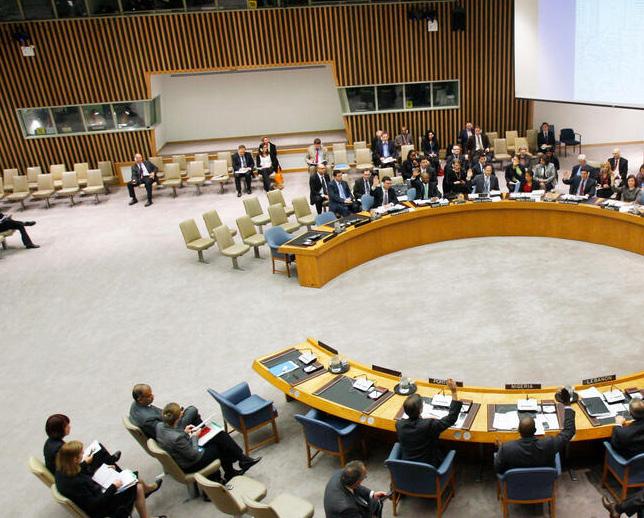
ABSTRACT
This article analyses the impact of resolution 1540 (2004) on national non-proliferation measures based on the 2022 Comprehensive Review. The analysis reveals that many UN Member States use domestic application of existing multilateral treaties to which they are parties as support for national implementation of resolution 1540. This indicates that, in many cases, the supplementary elements intended by the resolution, such as securing related materials or export controls, may not be sufficiently implemented. It concludes that in order to continue to promote national implementation, there will need to be some incentive to demonstrate that full and effective implementation of resolution 1540 is meaningful to all States. It also emphasizes that collaboration among Member States, civil society, industry, and academia is crucial to staying updated on scientific and technological advancements in the field.
38
The Security Council extends the mandate of 1540 Committee by unanimously adopting resolution 1977 (2011); Credit: UN Photo/Devra Berkowitz

This April marks the 20th anniversary of the adoption of United Nations Security Council resolution 1540 (2004). Resolution 1540 was adopted in 2004 as a precautionary measure in response to growing concerns that terrorists and other non-State actors might acquire and use weapons of mass destruction (WMDs) in the wake of the September 11 terrorist attacks in the United States. At the end of November 2022, the 1540 Committee conducted a com-
prehensive review of the implementation of resolution 1540, which led to the adoption of the successor resolution 2663 and extended the mandate of the 1540 Committee for another 10 years. This article examines, through this 2022 Comprehensive Review, what impact resolution 1540 has had on the national non-proliferation measures of UN Member States.
The adoption of resolution 1540, alongside resolution
THE AUTHOR: Kiwako Tanaka

Dr Kiwako Tanaka is an associate professor at Toyo Eiwa University, Japan. She has over 20 years of experience in WMD non-proliferation. From April 2018 to March 2023, she served as a member of the Group of Experts supporting the work of the UN 1540 Committee.
1373 (2001) on counter-terrorism, marked a rather controversial legislative move by the Security Council, responding to the post-9/11 recognition of the dangerous connection between WMDs and non-State actors, as exemplified by the covert nuclear proliferation activities of the “A. Q. Khan Network.” Instead of identifying a specific situation as a threat to international peace and security and taking action in response to it, the Security Council identified a possible
ARTICLE 39
link between non-State actors and WMDs as a general threat to international peace and security. As a response, it required all UN Member States to establish national legislation aimed at preventing the proliferation of WMDs to and by non-State actors. Unlike international treaties, non-Council Member States do not have the right to participate in the negotiation of drafting resolutions, nor do they have the right to choose not to accept the resolution. The adoption of resolution 1540 in 2004 raised controversial debates among the UN Member States as well as within academia. During the adoption process, there was a divide between those
States emphasizing non-proliferation and those viewing the resolution as an extension of resolution 1373 (2001) with a heightened focus on counter-terrorism. Despite varying positions and divergent interpretations by the UN Member States, the Council ultimately unanimously adopted resolution 1540.
Since the adoption of resolution 1540 in 2004, the 1540 Committee has conducted periodic reviews of national implementation in 2006, 2008, 2011, as well as comprehensive reviews of national implementation in 2009, 2016, and most recently in 2022. These reviews summarized
the status of national implementation by all UN Member States for each of the key obligations of resolution 1540, using a table called the “1540 Matrix,” which the 1540 Committee formulates for each UN Member State. Due in part to criticism of legislative measures taken by the Security Council at the time of adoption, the 1540 Committee does not have the authority to verify or evaluate national implementation by Member States, and the 1540 Matrix is merely a compilation of information based on national reports submitted by Member States.
The updated 1540 Matrix in 2021 recorded one or more
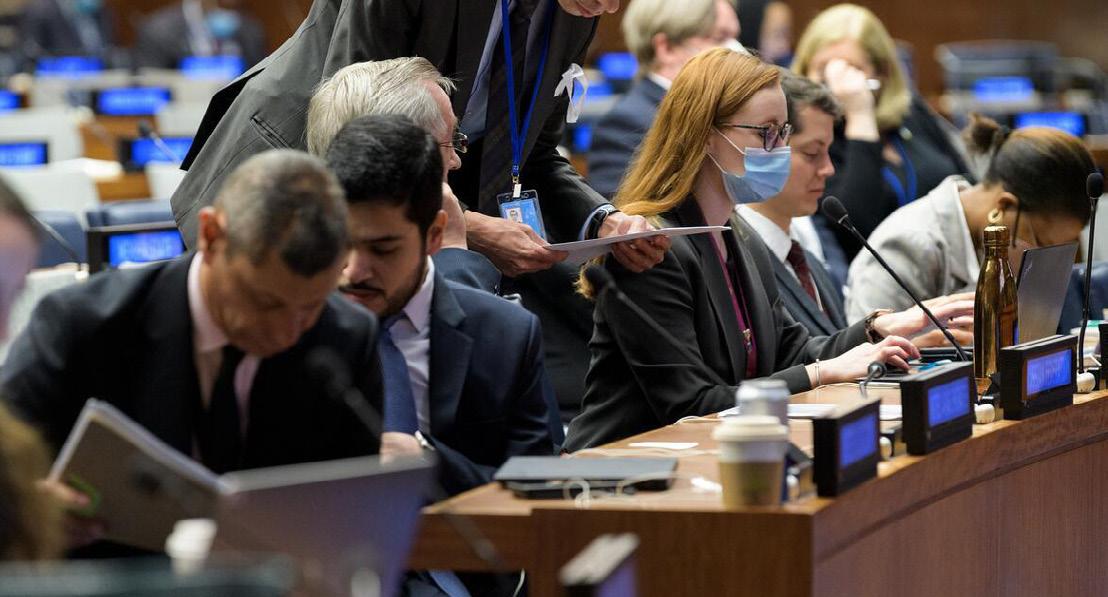
Issue 1 | 20 YEARS OF RESOLUTION 1540 40
Participants during the open consultations of the 1540 Committee on the 2022 Comprehensive Review; Credit: UN Photo/Manuel Elías
measures in 24,841 of the 44,004 data fields for all 193 countries, covering approximately 56% of the total. This represents an increase of about 6% compared to the same data from 2016. Looking at the operative paragraphs (OP) 1 to 3 separately, in OP1 on political commitment, some kind of measure or statement was recorded in 79% of the relevant data fields, 77% for OP2 concerning the obligation to establish national legislation, while 40% for OP3(a) and (b) on accounting for and securing related materials, and 51% for OP3(c) and (d) on border and export controls (see Table 1).
Concerning OP1, 153 of the 193 UN Member States have explicitly expressed some form of political commitment not to provide any support that would lead to activities related to WMDs by non-State actors. One of the objectives of resolution 1540 is to supplement existing international treaties aimed at disarmament and the non-proliferation of WMDs by adding non-State actors to the scope of those treaties. However, as a result of the adoption of the resolution amidst varying opinions, the implementation status in 2022 revealed that the majority of States

Table 1: Key obligations in the 1540 Matrix (2021), as stated in operative paragraphs 1 to 3 (OP1–OP3). Source: 1540 Committee Comprehensive Review Report (2021), p. 7.
use domestic application of existing multilateral treaties to which they are parties as support for national implementation of resolution 1540. This indicates that, in many cases, the supplementary elements intended by the resolution may not be fully implemented.
Two particularly important complementary elements of resolution 1540 with other international treaties are the “non-proliferation for non-State actors” and “export control measures.” With regard to the former, the status of implementation of OP2 indicated that many States take the national implementation of the Treaty on the Non-Proliferation of Nuclear Weapons (NPT), the
Chemical Weapons Convention (CWC), and the Biological Weapons Convention (BWC) and/or counter-terrorism conventions as the main legal framework for their implementation of resolution 1540. In such cases, while the CWC and BWC stipulate the prohibition of the means of delivery for the respective weapons, the NPT does not include the means of delivery of nuclear weapons within the scope of the treaty. Consequently the implementation status of prohibiting means of delivery relevant to nuclear weapons is significantly lower than those of chemical and biological weapons. Likewise, in countries where the counter-terrorism laws are used as the primary source
ARTICLE 41
of national implementation, the definition of “non-State actors” may be limited to terrorists or organized crime. The definition of “terrorist” also varies from State to State, and a number of countries restrict this definition to the lists established by the Counter-Terrorism Committee under the mandate of resolution 1373 (2001).
Similarly, with regard to OP3, the implementation status of accounting for and securing related materials shows that many States who rely on the national implementation of existing treaties for
the national implementation of resolution 1540 have not been able to adequately cover all obligations. Looking at the implementation status by weapon category, for nuclear weapon-related materials, “production,” “use,” and “storage” are controlled higher than “transportation.” One reason for this is that non-nuclear weapon States under the NPT are obliged to make a safeguards agreement with the International Atomic Energy Agency (IAEA), and for this purpose, States establish domestic control over “production,” “use,” and “storage” but not “transportation,” which is not included in the agreement. Likewise, the CWC States Parties are subject to verification under the CWC and thus are fulfilling the obligation of accounting for the “production,” “use,” and “storage” of chemical weapon-related materials, but not “transportation.” In contrast, the BWC does not explicitly provide for biosecurity obligations, and therefore, for many States, unless a separate biosecurity control system is established outside of the national application of the BWC, the domestic control obligation under resolution 1540 is not fulfilled.
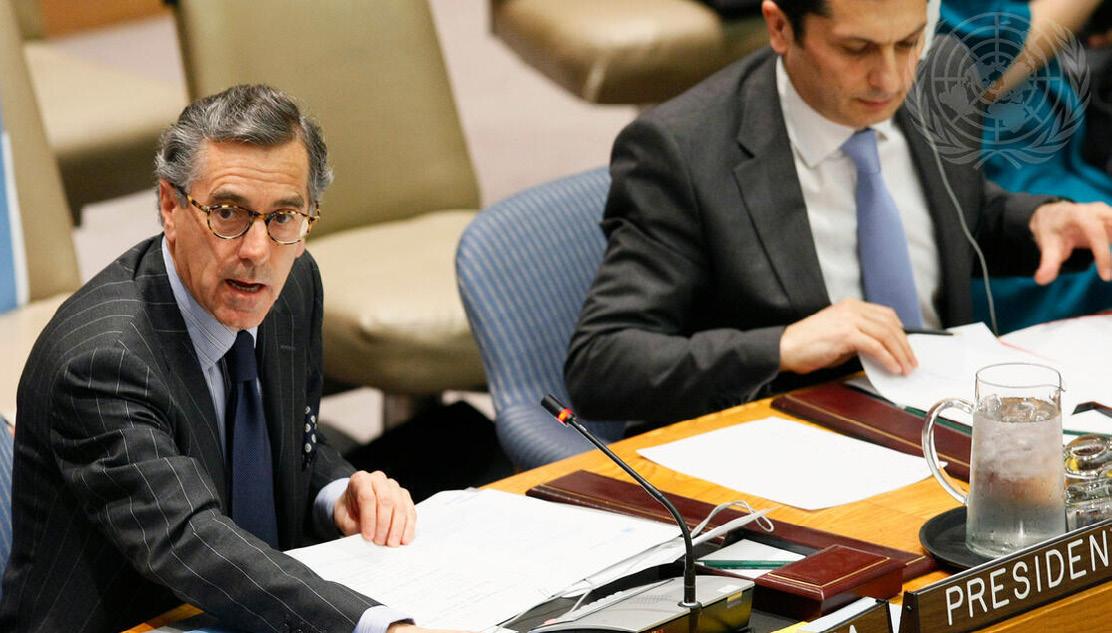
Issue 1 | 20 YEARS OF RESOLUTION 1540 42
Néstor Osorio (left) chairs a meeting of the Security Council extending the mandate of the 1540 Committee; Credit: UN Photo/JC McIlwaine
Similar to OP3(a) and (b) on domestic control over accounting for and securing related materials, the status of implementation of OP3(c) and (d) on border and export control is also low. This could also be attributed to the absence of internationally agreed-upon treaties regulating export control. Instead of legally binding treaties, the main framework for export control are the so-called multilateral regimes that are comprised of the Nuclear Suppliers Group (NSG), Missile Technology Control Regime (MTCR), the Australia Group (AG), and the Wassenaar Arrangement (WA). These export control regimes are voluntary coordination frameworks among interested countries and are not legally binding. Each regime has a limited number of participating countries: 48 for NSG, 35 for MTCR, 42 for AG, and 42 for WA. Most UN Member States are not participants in these export control regimes, which are sometimes perceived as export barriers by non-member countries. Due to the absence of an internationally agreed upon framework for export control, many countries that do not participate in the existing export control regimes have not established domestic export control measures.
Based on the 2022 Comprehensive Review, it appears that many UN Member States have not made special efforts to fulfil the legal obligations imposed by the Security Council, except for implementing the existing treaties. However, resolution 1540 is the only universal legally binding framework that obliges all 193 UN Member States to establish domestic control measures over WMD-related materials, equipment, and technologies. In particular, securing related materials and export control are complementary elements to the existing treaties, which are crucial for WMD non-proliferation purposes. There can be no doubt that it is now an essential tool in the international WMD non-proliferation architecture. In order to continue to promote the national implementation of resolution 1540 in the years ahead, there will need to be some incentive to demonstrate that full and effective implementation aimed at the non-proliferation of WMDs by non-State actors is meaningful to all States.
Fortunately, the Security Council unanimously adopted successor resolution 2663 on 30 November 2022, and extended the 1540 Committee’s mandate for another 10
years until 2032. Resolution 2663 (2022) provides ample scope for the 1540 Committee’s activities, which include intensifying its efforts to promote the full implementation of resolution 1540, particularly noting the need for more attention on accounting for and securing related materials, as well as national export and transhipment controls, among others. It also encourages the 1540 Committee to develop and review voluntary technical reference guides, which could assist States’ implementation. Furthermore, resolution 2663 (2022) continues calling upon Member States to take into account developments in the evolving nature of the risk of WMD proliferation and rapid advances in science and technology in their implementation of the resolution. Twenty years have passed since the adoption of resolution 1540 and the global security environment has changed. It is inevitable that all Member States work together, in partnership with representatives of civil society, including industry and academia, to keep abreast of scientific and technological development.
ARTICLE 43
UNSCR 1540: IMPROVING IMPLEMENTATION TO ENSURE A SAFER TOMORROW

ABSTRACT
Since the adoption of UN Security Council resolution 1540 (UNSCR 1540) in 2004, implementation by States has improved. However, there are still shortcomings in the implementation of the resolution that should be addressed. The article offers some recommendations to strengthen the implementation of UNSCR 1540. Noting changes in the threat environment, especially due to rapid advancements in technologies such as artificial intelligence, the article argues that a robust and universal implementation of UNSCR 1540 is important and needed to ensure a safer future for humanity.
UN Security Council resolution (UNSCR) 1540, adopted unanimously in 2004, provides a comprehensive framework for combating the proliferation of nuclear, chemical, and biological weapons and their delivery systems by non-State
actors. The adoption of UNSCR 1540 was triggered by the aftermath of the 9/11 attacks and the unveiling of the A.Q. Khan proliferation network, which led to calls to ensure that non-State actors do not obtain weapons of mass destruction (WMD) nor the materials and technologies to manufacture them.
Over the last twenty years of implementation, the number of States submitting their initial report on the implementation
44
View of a uncrewed aerial vehicleor drone in flight; Credit: Jordan Cormack

of UNSCR 1540 has increased. However, there still remain eight States that have yet to submit a report at all.1 In the 2022 Comprehensive Review on the status of implementation of UNSCR 1540 (the third Comprehensive Review conducted to date and mandated under UNSCR 1810 (2008) and UNSCR 1977 (2011))2, this shortcoming was highlighted: “the Committee [noted] that some Member States have indicated that they
Mara Zarka & Sarah Case Lackner


have experienced difficulties in the full implementation of the resolution due to, inter alia , the lack of adequate financial resources, technical expertise, legal frameworks and enforcement capabilities and recognizes the particular needs of support for developing countries and, in particular, least developed countries.”3
While UNSCR 1540 was adopted under Chapter VII of the UN Charter, binding all UN
Member States to its implementation, the lack of consideration of States’ capacity to meet their obligations under the resolution exacerbates gaps in implementation. On the one hand, UNSCR 1540’s key strength lies in its agility and breadth, as its provisions remain broadly applicable even when the threat environment changes. The resolution encompasses the entirety of a non-State actor’s attempts to “develop, acquire, manufacture,
1 Security Council, “2022 comprehensive review of the status of implementation of Security Council resolution 1540 (2004),” (November 2022), p. 8.
2 Security Council Resolution 1810 (2008), OP8 and Security Council Resolution 1977 (2011), OP3.
3 Security Council, “2022 comprehensive review of the status of implementation of Security Council resolution 1540 (2004),” (November 2022), p. 22.
ARTICLE 45
THE AUTHORS:
Mara Zarka is a Research Associate and Project Manager and Dr Sarah Case Lackner is a Senior Fellow at the Vienna Center for Disarmament and Non-Proliferation (VCDNP) in Vienna, Austria.
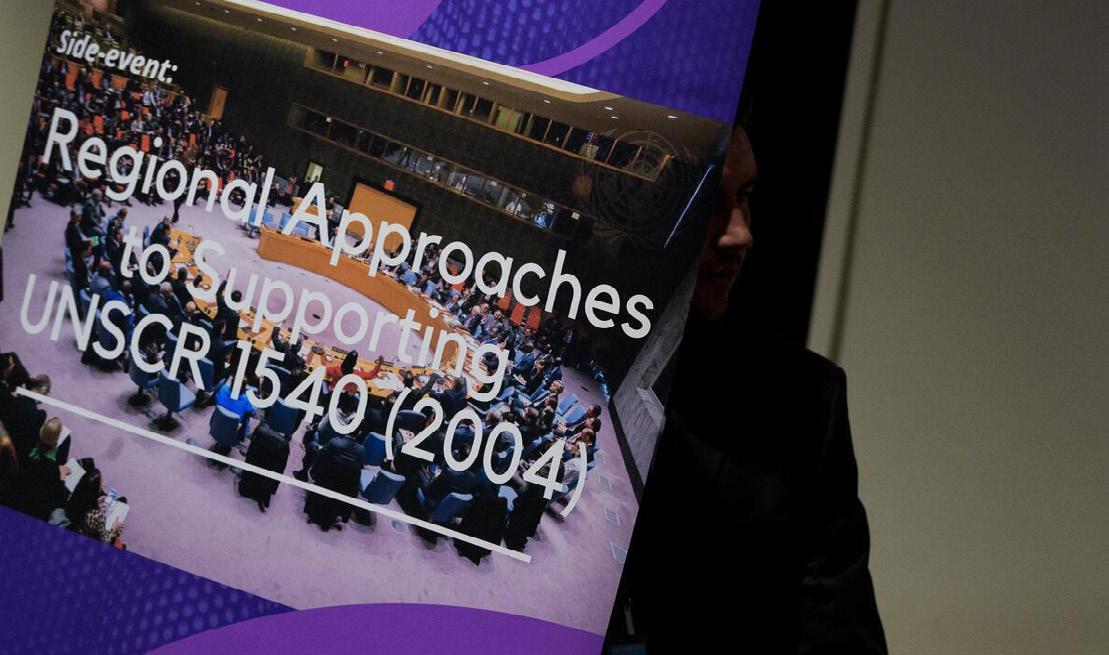
possess, transport, transfer or use nuclear, chemical or biological weapons and their means of delivery.”4 Further, the nonprescriptive language of the provisions, especially related to the “effective measures to establish domestic controls,”5 enables it to adapt to changes in the security landscape. On the other hand, the general nature of its provisions can also be seen as a weakness, as it provides little guidance to States on its implementation. The gaps in implementation are visible in the varying
percentages of overall implemented measures recorded to date, the quality of the reports submitted and the enforcement of the measures put in place.
These shortcomings in the implementation of UNSCR 1540 over the last two decades demonstrate that States need additional support to meet their obligations under the resolution, both presently and in the future. One key step to further support States is ensuring their access to reliable information on how
4 Security Council Resolution 1540 (2004), OP 1, 2 and 3.
5 Security Council Resolution 1540 (2004), OP3.
to implement the resolution’s provisions. Such international guidance is already available for the nuclear and radiological aspects of UNSCR 1540 through the International Atomic Energy Agency’s (IAEA) Nuclear Security Series, which “are consistent with, and complement, international nuclear security instruments, such as (…) United Nations Security Council Resolutions 1373 and 1540.”6
However, equivalent tools are lacking for the chemical
6 International Atomic Energy Agency, “Nuclear security fundamentals, objective and essential elements of a State’s nuclear security regime,” IAEA Nuclear Security Series, No. 20 (2013), Preface.
Issue 1 | 20 YEARS OF RESOLUTION 1540 46
Side-event during the 2022 open consultations of the 1540 Committee; Credit: UN Photo/Manuel Elías
and biological security aspects. There are dozens of expert and good practice documents on different areas of the resolution, yet no single document comprehensively covers the chemical or biological security components in full. For example, while the Organisation for the Prohibition of Chemical Weapons (OPCW) offers capacity building opportunities to States experiencing challenges in implementation and there is some guidance available on its website for implementing legislation and providing assistance and protection, consensus guidance from States Parties to the Chemical Weapons Convention is not available. The OPCW could be well suited to pursue the development of consensus guidance on chemical security. However, an international body would need to be identified to carry out the same endeavour for the biological side, and in both cases, it could take significant time for such guidance to be developed.
Although more effective if developed as a consensus among many States, such as
the IAEA’s Nuclear Security Guidance, an expert document could also provide useful information on good practices and require less time to assemble. For example, the 1540 Committee could compile typical measures States have introduced to fulfil their obligations under the resolution. Such a guide establishing good practices for implementation could be invaluable to all States, and particularly those experiencing challenges in implementation. Such an effort would, however, require significant resources from the 1540 Committee. For this reason, it could be productive for the 1540 Committee to seek partnerships with Member States and regional or subregional organizations for its development.
A second, parallel effort could see the 1540 Committee strengthening and streamlining its matchmaking role. The 1540 Committee’s matchmaking role was established under UNSCR 1810 (2008) in which all States and assistance providers were encouraged to inform the 1540 Committee of their requests and areas where assistance could be provided.7
7 Security Council Resolution 1810 (2008), OP5.
However, the 2022 Comprehensive Review indicates that more can be done to improve tailored assistance to States in a more efficient and timely manner, and it provides several recommendations regarding how to aid the 1540 Committee in this regard.8 One path forward to better facilitate tailored assistance could be for the 1540 Committee to provide a mechanism through which States seeking advice on completing their assistance requests could consult either directly with the Group of Experts or with international, subregional and regional organizations. Such engagement while States are preparing their requests would allow for the specific needs of States to be clearly defined and thus better met through the matchmaking process. Additionally, to further refine the matchmaking process, the 1540 Committee should prompt providers of assistance to also be more specific regarding their offers of assistance. For example, as recommended in the 2022 Comprehensive Review, this could be done via a template developed for this purpose. However, to carry
8 Security Council, “2022 comprehensive review of the status of implementation of Security Council resolution 1540 (2004),” (November 2022), pp. 27.
ARTICLE 47
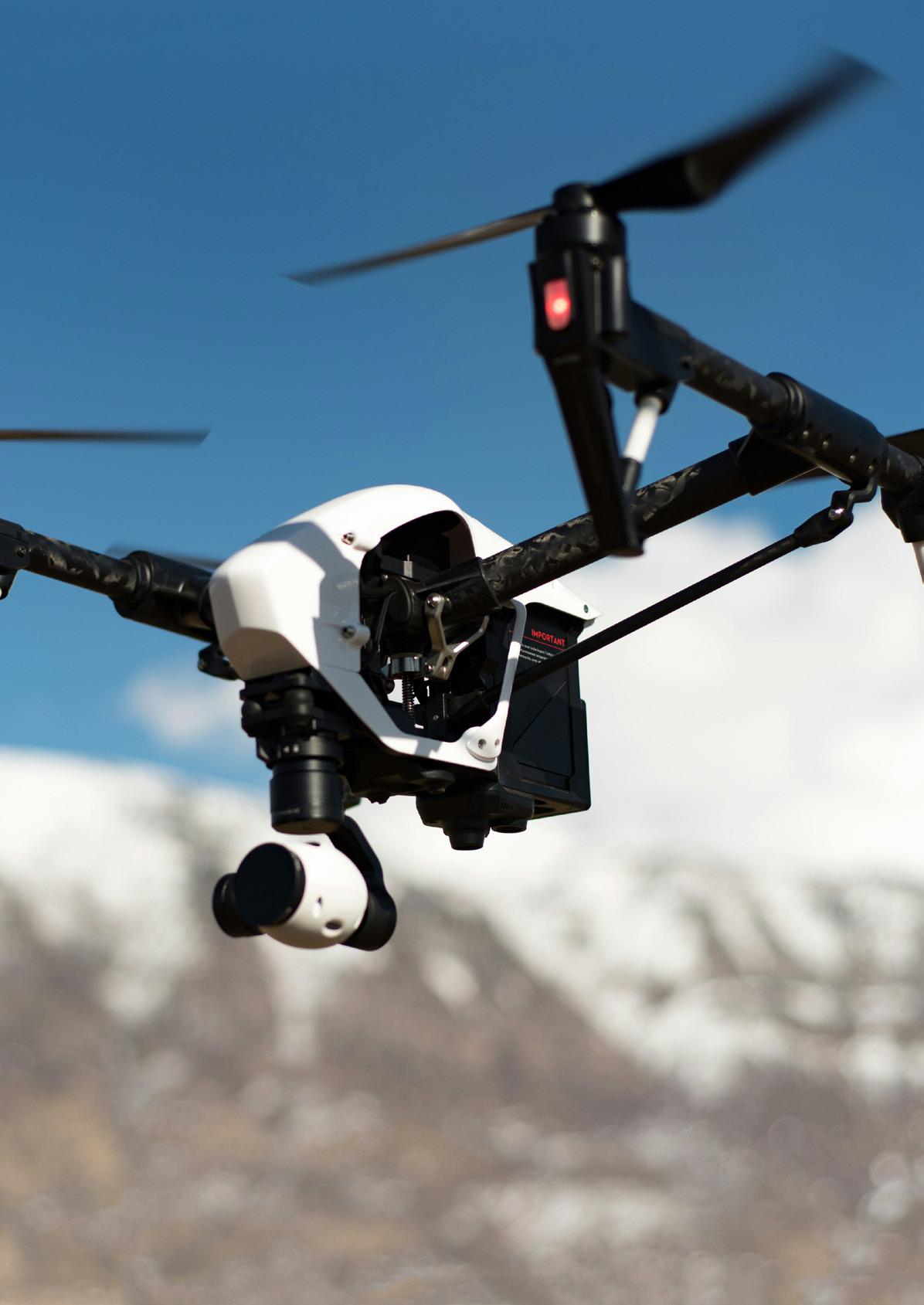 An uncrewed aerial vehicle (drone) in flight; Credit: Mitch Nielsen
An uncrewed aerial vehicle (drone) in flight; Credit: Mitch Nielsen
out these recommendations, the 1540 Committee may require additional capacity and resources or, alternatively, could seek partnerships with other organizations.
Further outreach may also be needed to States that are still in the process of implementing the provisions of UNSCR 1540. Better utilization of the national points of contact to increase awareness and strengthen institutional capacity on UNSCR 1540 could help States better align the goals of the resolution with their national priorities. Also, national points of contact could help identify more senior individuals with strong connections within government to provide more visibility and offer a stronger voice to the importance and significance of a robust implementation of the resolution.
Now, more than ever, is the time to strengthen the mechanisms that support States in implementing UNSCR 1540.
The threat environment is changing rapidly, and advancements in technologies are emerging at an unprecedented
rate. Many of these technologies have potential to provide non-State actors with capabilities that, in some ways, begin to approach those available to State actors. In particular, technologies like artificial intelligence (AI), can reduce the resources needed to commit malicious acts, while potentially increasing the speed and scale of attacks. Non-State actors are already using AI and emerging technologies in their offensives, via weaponized uncrewed aerial vehicles, denial-of-service attacks, enhancing existing malware to bypass security in place, and using open-source intelligence to plan and map out attacks.9 Advancements in AI, anticipated every six months, may allow for attacks to become “more accurate, more targeted, more automated and more convincing”10 and at a scale that could be hard to control.
The potential risk posed by advanced technologies in the hands of malicious non-State actors increases the urgency of ensuring that all States can effectively implement UNSCR 1540’s provisions. This means that an adaptable and strong
implementation of UNSCR 1540 worldwide is essential to protect against malicious non-State actors seeking WMD capabilities. Every State differs in its capacity to meet its obligations under UNSCR 1540, and assistance is needed to reach a robust and universal implementation of this vital resolution. However, it must be done, for the security of us all.
The threat environment is changing rapidly, and advancements in technologies are emerging at an unprecedented rate.
9 Sarah Kreps, “Democratizing harm: Artificial intelligence in the hands of nonstate actors,” Foreign Policy at Brookings, November 2021.
10 Sarah Kreps, “Democratizing harm: Artificial intelligence in the hands of nonstate actors,” Foreign Policy at Brookings, November 2021, p. 9.
ARTICLE 49
UNSCR 1540 LESSONS LEARNED FROM THE ‘TENDING’ OF THE BIOLOGICAL WEAPONS REGIME

ABSTRACT
‘Tending’1 United Nations Security Council resolution 1540 (2004) (UNSCR 1540) and expanding its outreach requires several activities and sustained resources. These activities have principally been directed by the 1540 Committee, with the support of a wide range of entities within the United Nations system. Focusing on the regime against biological weapons, this paper will examine changes in implementation measures since the passage of UNSCR 1540 and illustrate how documenting such changes may facilitate States’ national implementation. For illustrative purposes, the paper will also look at the evolution of what is required to implement the Biological Weapons Convention (BWC) at the national level, drawing on experience with developing a BWC national implementation measures database to explore evolving requirements related to emerging technologies more specifically.
1 In this context, ‘tending’ implies giving sustained attention to and proactively ensuring the resolution’s implementation.
50
Kofi Annan (third from left) delivers his remarks at the opening of the Sixth Review Conference of the Biological and Toxic Weapons Convention; Credit: UN Photo/ Eskinder Debebe
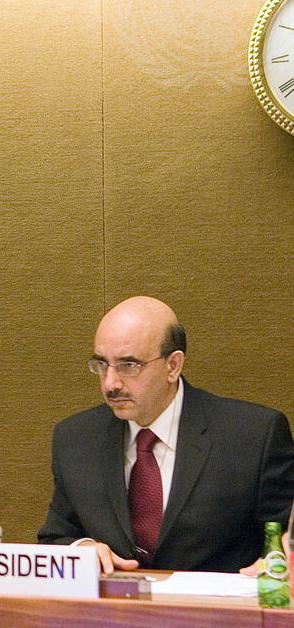
*
INTRODUCTION
Adopted in 2004, United Nations Security Council resolution 1540 (UNSCR 1540) identifies the proliferation of biological weapons and their means of delivery as a threat to international peace and security. Among other obligations, it encourages States to promote the adoption and implementation of the Biological
2 S/RES/1540
3 S/RES/1540
THE AUTHORS:
Louison Mazeaud & James Revill


Weapons of Mass Destruction Programme, UNIDIR*
The United Nations Institute for Disarmament Research (UNIDIR) is an autonomous institution within the United Nations that conducts independent research on pressing global challenges related to disarmament, arms control and international security. James Revill is Head of the WMD programme at UNIDIR. He holds a PhD on the Biological Weapons Convention (BWC) and has published extensively on related issues. Louison Mazeaud in an Associate Researcher at UNIDIR where she supports activities in relation to the BWC. She holds degrees from King’s College London and the Graduate Institute Geneva.
Weapons Convention (BWC) and foster cooperation within this multilateral framework.2
UNSCR 1540 also ‘calls upon all States to adopt national rules and regulations (…) to ensure compliance’ with international conventions including the BWC. In particular, the resolution stresses the need to adopt domestic measures to establish, among other
things, physical protection, border controls and criminal offenses.3
The fulfilment of obligations under disarmament treaties and related resolutions is neither automatic nor guaranteed. Rather, such processes require sustained attention and ‘tending’. As Charles Flowerree, former US Ambassador for Disarma-
ARTICLE 51
Please note that the opinions expressed in this article are the authors’ own, and do not necessarily reflect the views of UNIDIR or the United Nations.
ment, remarked: ‘The means by which these agreements survive and adapt to changing conditions after they enter into force deserve as much attention as the negotiations that produced them in the first place. They cannot simply be left to fend for themselves.’4
Tending to the implementation of UNSCR 1540 requires several activities and sustained resources. These activities have principally been directed by the 1540 Committee, which has led work in this area over nearly two decades. At the same time, there are a wide range of entities within the United Nations system that have also contributed to the implementation of resolution 1540 using various tools and strategies.
Focusing on the regime against biological weapons, this paper will examine changes in implementation measures since the passage of UNSCR 1540 and illustrate collecting and collating data on national activities can facilitate the im-
plementation of such measures to prohibit and prevent such weapons. The paper will also explore the evolution of what is required to implement the BWC at the national level, drawing on experience with developing a BWC national implementation measures database to explore evolving requirements related to emerging and converging technologies.
UNSCR 1540 AND THE BWC
UNSCR 1540 and the BWC are complementary instruments that collectively form the foundations of the global regime against biological weapons. Indeed, UNSCR 1540 ‘calls upon all States to adopt national rules and regulations (…) to ensure compliance’ 5 with international conventions including the BWC. In particular, the resolution stresses the need to adopt domestic measures to establish physical protection of related materials, border controls and criminal offenses.6 These actions are primarily focused on preventing
the development of biological weapons by non-State actors.
The 1972 BWC was negotiated by and for States. Nonetheless, Article IV of the BWC states:
‘Each State Party to this Convention shall, in accordance with its constitutional processes, take any necessary measures to prohibit and prevent the development, production, stockpiling, acquisition or retention of the agents, toxins, weapons, equipment and means of delivery specified in Article I of the Convention, within the territory of such State, under its jurisdiction or under its control anywhere’.7
Ahead of the Ninth BWC Review Conference in 2022, the BWC Implementation Support Unit (ISU) prepared a document compiling additional understandings and agreements from past Review Conferences.8 This document
4 Charles C. Flowerree, ‘On Tending Arms Control Agreements’ in The Washington Quarterly, Volume 13, 1990, Issue 1, 199-214.
5 S/RES/1540
6 S/RES/1540
7 Biological Weapons Convention, 10 April 1972, available at : https://front.un-arm.org/wp-content/uploads/2020/12/BWCtext-English-1.pdf.
8 BWC/CONF.IX/PC/5
Issue 1 | 20 YEARS OF RESOLUTION 1540 52
provides insights into the evolution of States Parties’ perspectives on national implementation of the BWC
and illustrates how, over time, new expectations under Article IV have emerged, 9 including, for example, the establishment of national focal points and the growing interest around biosafety and biosecurity measures.
Table 1 Additional understandings agreed at BWC Review Conferences under Article IV as reflected in BWC/CONF.IX/PC/5
Penal legislation, designed to (…) ensure safety and security
National measures to strengthen methods and capacities for surveillance and detection of outbreaks of disease
Information provided to the United Nations by States in accordance with resolution 1540 (2004) may provide a useful resource
10 No additional understandings were agreed at the Fifth BWC Review Conference
11 No additional understandings were agreed at the Ninth BWC Review Conference
ARTICLE 53
9 BWC/CONF.IX/PC/5
Theme Review Conference 1 2 3 4 510 6 7 8 911 National focal points - X X XExtraterritorial application X X - X X XPhysical
X X X - -
protection
- X X X -
- X XPromote awareness of BWC - X XPromotion of a culture of responsibility - X XInclusion in educational materials of
on the BWC X X X - XTraining and education programmes - X X XPromote awareness
relevant professionals - X XCodes of Conduct - X -
- X X X -
Voluntary management standards on biosafety and biosecurity
(…) information
among
- X X X -
Furthermore, the document points to additional understandings reached on the need for voluntary management standards on biosafety and biosecurity, as well as codes of conduct, education, and awareness raising activities among the scientific community. 12 Following the enactment of UNSCR 1540 in 2004, the Sixth (2006), Seventh (2011) and Eighth (2016) BWC Review Conferences explicitly recognized the interconnections between the BWC and
UNSCR 1540, which BWC States Parties recognized as ‘a useful resource for States Parties’ in the implementation of Article IV.13
UNSCR 1540 and the BWC thus inform each other on key aspects of implementation. This has significant positive implications for the evolution of common understanding on best practices and relevant measures to reinforce the global regime against biological weapons.
THE KEY ROLE OF OUTREACH FOR NATIONAL IMPLEMENTATION
Member States are asked to share information on these measures with the 1540 Committee, and the information received is then summarized by the Committee in a matrix. Since the adoption of UNSCR 1540, there is evidence of considerable progress in the implementation of the biological dimension of
12 BWC/CONF.IX/PC/5
13 BWC/CONF.IX/PC/5
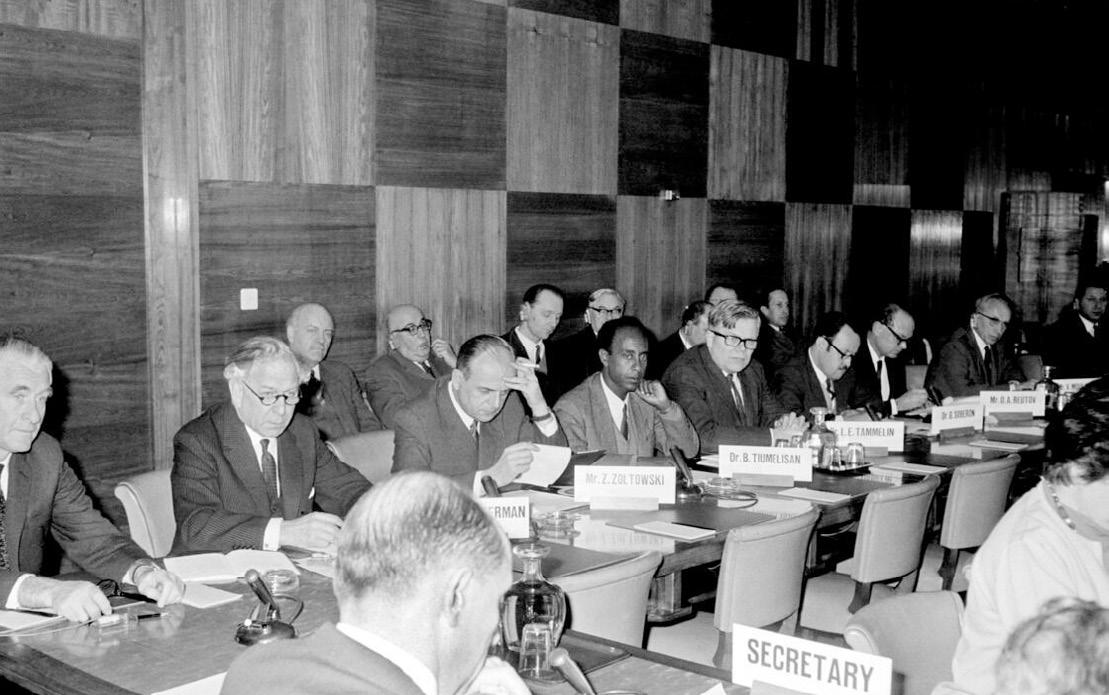
Issue 1 | 20 YEARS OF RESOLUTION 1540 54
Consultant Experts on Chemical and Bacteriological (Biological) Weapons Holds Session in January 1969; Credit: UN Photo
the resolution. For example, the latest 2022 Comprehensive Review on the status of implementation of Security Council resolution 1540 notes that “74 per cent of the laws and enforcement measures required under paragraph 2 in relation to biological weapons were recorded. This represents an increase of around 9 per cent compared with 2016”.14
Beyond the quantitative growth in the number of States implementing UNSCR 1540, the last two decades have seen a qualitative expansion of the types of measures undertaken by States. The current matrix includes information on, inter alia , national legislation prohibiting the possession of biological weapons, measures to secure the storage of related materials, the registration of facilities, end-user controls and points of contact.15 This was not the case in the early days of the resolution when reports contained uneven and partial information on implementation.
Different factors may explain this shift, including national
concerns over bioterrorism resulting from the advance and diffusion of technologies. However, outreach strategies undertaken by the 1540 Committee and other UN entities have also played an important role. In the case of the global regime against biological weapons, UNSCR 1540 and BWC related outreach activities have been critical in shaping thinking around best practices and implementation measures. Trainings and other awareness-raising events have encouraged States to be more transparent and adopt relevant national legislation by using matrices and fostering information sharing.
The spectrum of biological risks has, however, evolved over the course of the last two decades and so has the scope of ‘necessary measures to prohibit and prevent’ biological weapons at the national level and reinforce the international regime. For example, the digitization of DNA data and the increasing convergence of biological and cyber systems is leading to emerging
interest in cyber-biosecurity and the prevention of digital ‘information hazards’. This is compounded by an increase in the number of actors and facilities working with biological agents and toxins over this period.
Implementation measures have evolved to address elements of this challenge, as reflected in the growth of additional understandings under Article IV reached by States Parties to the BWC. However, the pace of evolution of implementation measures is at risk of being outpaced by technological advancements. For instance, there is growing concern over cyber-biosecurity risks emerging from the growing reliance on cyber tools and cyber-physical systems in various infrastructures, such as laboratories, hospitals and biological product production facilities.16 Yet, very few countries have implemented cyber-biosecurity measures and they do not form part of the measures considered in the 1540 matrices or the BWC Article IV Additional Understandings.
14 S/2022/899
15 United Nations, 1540 Committee, ‘1540 Matrices’, available at : https://www.un.org/en/sc/1540/national-implementation/1540-matrices.shtml.
16 Siguna Mueller, ‘Facing the 2020 pandemic : What does cyberbiosecurity want us to know to safeguard the future ?’ in Biosafety and Health, Volume 3, Issue 1, February 2021, 11-21.
ARTICLE 55
Moreover, the 1540 Committee and the BWC ISU have limited resources and lack the mandate to push forward major additions to the areas of implementation.
OUTREACH EXPANSION
The implementation of UNSCR 1540 and the BWC does not operate in a vacuum, but is supported by a number of tools and activities undertaken
The World Health Organization (WHO), for example, has advanced work on dual-use research governance, including through the publication of a Global Guidance Framework for the Responsible Use of the Life Sciences; 17 the United Nations Interregional Crime and Justice Research Institute (UNICRI) has “taken steps to enhance biosafety and biosecurity” through its Chemical, Biological, Radiological and Nuclear (CBRN) Risk Mitigation and Security Governance Programme;18 the United Nations Office for Disarmament Affairs (UNODA) has launched several initiatives designed to promote effective
17 World Health Organization, Global guidance framework for the responsible use of the life sciences: mitigating biorisks and governing dual-use research, 13 September 2022.
18 James Revill, Vivienne Zhang and María Garzón Maceda, ‘Stakeholders perspectives on the Biological Weapons Convention’, UNIDIR, 2022. by other entities. The work of such actors can be useful in sustaining the resolution and reinforcing the broader international regime against biological weapons.

Issue 1 | 20 YEARS OF RESOLUTION 1540 56
Secretary-General meets with President-designate of Ninth Review Conference of Biological Weapons Convention; Credit: UN
Photo/Ariana Lindquist
implementation of the BWC, including a four-year initiative supporting universalization and effective implementation of the BWC in Africa; 19 and in 2023, the United Nations Institute for Disarmament Research (UNIDIR) and the Verification Research, Training and Information Centre (VERTIC) launched the BWC National Implementation Measures Database, which collects information on measures adopted by States Parties to the BWC and makes it available in the six official UN languages. 20 Drawing from open-source material, this database includes country summaries of, inter alia, prohibitions, export and transfer controls, biosafety and biosecurity measures, as well as measures on international cooperation along with links to official sources from government websites.
Cybersecurity measures are defined, for the purpose of the database as: ‘measures aimed at preventing harmful or intrusive activities related to information and communication technologies against
facilities where activities involving biological agents and toxins are conducted.’21 While the database is not a ranking or enforcing tool, the availability of open source information can help States to broaden and deepen national measures to prohibit and prevent biological weapon proliferation.
CONCLUSION
There has been considerable progress in the implementation of national measures since the passage of UNSCR 1540, which has taken place at the same time as broader activities by a range of UN entities to strengthen the global regime against biological weapons. In view of the expansion of biological risks, notably those related to the development of emerging technologies, UNSCR 1540’s general call for the prevention of proliferation to and by non-State actors remains enduringly pertinent for States seeking to prevent the spread of biological weapons-related capabilities. Equally, risk reduction measures recommended by
the BWC and other international instruments continue to build upon the foundations laid by UNSCR 1540. In this context, ‘tending’ the resolution and sustaining outreach through the work of other UN entities remains critical.
The spectrum of biological risks has [...] evolved over the course of the last two decades
19 UNODA, Global Partnership Support, available at https://disarmament.unoda.org/global-partnership-support/ (accessed on 20 February 2024).
20 UNIDIR and VERTIC, Biological Weapons Convention National Implementation Measures Database, available at: https://bwcimplementation.org/ (accessed on 20 February 2024).
21 UNIDIR and VERTIC, ‘Glossary’, Biological Weapons Convention National Implementation Measures Database, available at: https://bwcimplementation.org/ (accessed on 20 February 2024).
ARTICLE 57
NEW CHALLENGES TO THE 1540 NON-PROLIFERATION REGIME

ABSTRACT
At the dawn of the new millennium, the Security Council adopted United Nations Security Council resolution 1540 (2004) (UNSCR 1540), thus launching a long-term global effort in the fight against weapon of mass destruction (WMD) proliferation by non-State actors. After twenty years, the effort to achieve the 1540 non-proliferation regime is presented with new challenges, including a shift in the balance of power triggering competition and confrontation, emerging non-State actors gaining access to critical technology and a world economy with new opportunities for proliferators.
The upcoming years will see the implementation of countermeasures following the directives decided by the Security Council in successor resolution UNSCR 2663 (2022). Although the resolution failed to adequately empower the Group of Experts of the 1540 Committee to enable them to steer this process, there are the margins, with the support of the Committee, to promote an effective and harmonized implementation at national level.
58
Transhipment and export controls are vital for the full implementation of UNSCR 1540; Credit: Venti Views

As the global arms control regime weakens under the blows of a changing balance of power and tensions,1 the international community finds in United Nations Security Council resolution 1540 (2004) (UNSCR 1540) a resilient instrument in the fight against the proliferation of weapons of mass destruction (WMDs) and their means of delivery. On 30
November 2022, the Security Council unanimously passed UNSCR 2663 (2022), which renewed the 1540 Committee and Group of Experts’ mandate until 30 November 2032. Even when rifts within the UN body are jeopardizing the ability to take decisions on other critical WMD proliferation issues, 2 resolution 1540 gathers, albeit not without controversies, the

Giuseppe Di Luccia is a Research Associate at the Centre for Science and Security Studies (King’s College London) where he focuses on WMD non-proliferation and countering its financing. He has developed his expertise working in research centres, in international organizations, as well as in the private sector.
unanimous approval of the Security Council members.
However, since its adoption, the international system has evolved and so has the risk of WMD proliferation. Although not comprehensively, the risk perspective presented aims to raise awareness of some key developments related to current threats and vulnera -
1 Arms control treaties falling victim to international tensions in the last five years include the Intermediate-Range Nuclear Forces (INF) in 2019, the Open Skies Treaty in 2020, the Comprehensive Test Ban Treaty (CTBT) in 2023, the New Strategic Arms Reduction Treaty (New START) in 2023, the Conventional Arms Forces Control in Europe (CFE) in 2023.
2 For example, on 26 May 2022, at the 9048th meeting, the Security Council failed to adopt a resolution tightening the sanctions regime on the Democratic People’s Republic of Korea (SC/14911) and, on 28 March 2024, the extension of the mandate for the expert panel assisting the sanctions committee on the DPRK was vetoed (SC/15648).
ARTICLE 59 THE AUTHOR:
Giuseppe Di Luccia
bilities affecting the non-proliferation regime established by UNSCR 1540. Both today’s threat of non-State actors, coupled with the ease of access to strategic items, and the opportunities created by the developments in global trade and in financial technology aggravate the WMD proliferation risk. Therefore, adaptive measures are required to strengthen the UNSCR 1540 non-proliferation regime and an internationally coordinated effort supported by subject matter experts is necessary to guarantee its effectiveness.
THE THREAT FROM NONSTATE ACTORS3
Twenty years later, the raison d’être of UNSCR 1540 persists. Violent non-State actors, generically identified with terrorist individuals and entities, continue to threaten international
security and stability, 4 while non-violent non-State actors, such as private businesses and smugglers, continue to develop sophisticated tactics to traffic strategic goods,5 which include items involved in the development, production, or use of WMDs and their delivery systems.
Counter-terrorism efforts in the wake of the 9/11 attacks were one of the main drivers 6 for the adoption of UNSCR 1540. The use of the threat to use nuclear, biological or chemical weapons could have very well served terrorists’ ambitions. Therefore, the resolution shifted the attention from States to non-State actors.
Today’s growing political, economic or military weight on the international stage of, for instance, politically, ethnically or religiously motivated extremists,
paramilitary groups or transnational criminal syndicates threatens the WMD non-proliferation regime more than ever. Far from a negligible risk, there have been several cases where non-State actors either demonstrated interest in, acquired or contributed to the acquisition or development of WMDs and their means of delivery. The Organisation for the Prohibition of Chemical Weapons (OPCW)-UN Joint Investigative Mechanism’s reports on the use of chlorine and sulphur mustard gas by the Islamic State of Iraq and the Levant (ISIL, also known as Da’esh) 7 proved the capacity of the terrorist group to produce and employ chemical weapons combined with projectile delivery systems. Similarly, certain transnational criminal organizations have contributed to advance North Korea’s WMDs and means of delivery programmes by
3 UNSCR 1540 (2004) provides an ad hoc definition of non-State actor: “individual or entity, not acting under the lawful authority of any State in conducting activities which come within the scope of this resolution.”
4 See, for example, the conflicts tracked by the CrisisWatch, https://www.crisisgroup.org/crisiswatch
5 See, for example, the press releases of the U.S. Department of Commerce, Bureau of Industry and Security https://www.bis. doc.gov/index.php/about-bis/newsroom/press-releases
6 The other main driver was the uncovering of the Pakistani scientist Abdul Qadeer Khan’s network engaging in the smuggling of nuclear weapons related materials.
7 For the 21 August 2015 attack in Marea, Syria, see Third report of the Organization for the Prohibition of Chemical Weapons-United Nations Joint Investigative Mechanism (S/2016/738/Rev.1). For the 15 and 16 September 2016 attack in Umm Hawsh, Syria, see Seventh report of the Organisation for the Prohibition of Chemical Weapons-United Nations Joint Investigative Mechanism (S/2017/904).
Issue 1 | 20 YEARS OF RESOLUTION 1540 60
generating revenues, evading sanctions and providing financial services through offshore networks.8
ACCESS TO WEAPONS OF MASS DESTRUCTION
Even more concerning is the increasing risk of misuse of rapid scientific advancements for proliferation purposes.
Access to dual-use technology that could be used for the design, development, or manufacture of WMDs or their means of delivery adds to the risk of their use. The information revolution and low costs allow, for instance, the assembly of lethal devices, such as smart drones, simply by using a 3D printer and a mobile phone equipped with a camera and a GPS.9
Moreover, the risk of strategic technology transfer to non-State actors has become more serious. The shift in the geopolitical landscape has featured the emergence of global and regional tensions, in some cases turning into conflicts where non-State belligerents are sponsored by other States. 10 While the levels of support to non-State actors may vary from political
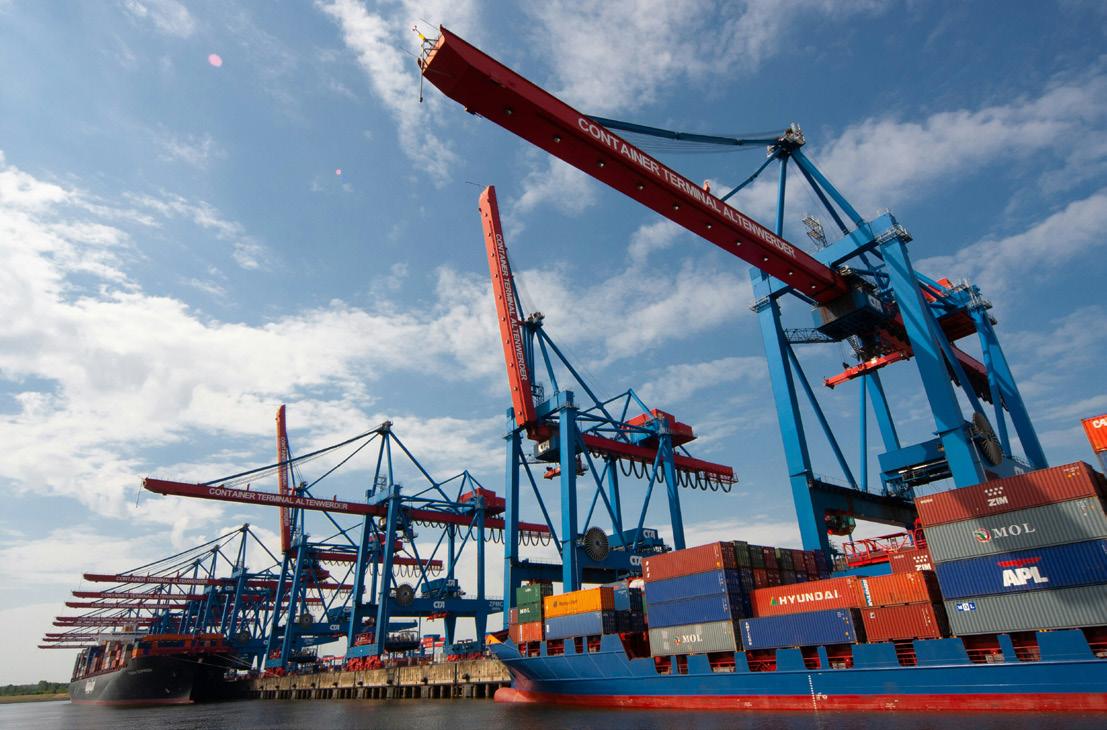
8 See, for example, Christian Davies, Primrose Riorden and Chan Ho-Min, “Inside North Korea’s oil smuggling: triads, ghost ships and underground banks”, Financial Times, 29 March 2023.
9 Andrea Beccaro, “Non-State actors and modern technology” in Small Wars & Insurgencies, 34:4, 791 (August 2022).
10 See, for example, Hafsa Halawa, “Nonstate Actors, Geopolitics, and Conflict in the Middle East”, Carnegie Europe, 30 November 2022.
ARTICLE 61
The delocalization of production processes have fragmented supply chains across multiple jurisdictions, making detection more challenging; Credit: Kurt Cotoaga
to financial or material, resolution 1540 draws a clear line, in so far as its operative paragraph 1 prohibits all Member States from providing any form of support to those attempting to engage in the proliferation of WMDs or their means of delivery.
However, current conflicts in the Middle East suggest that armed non-State actors can acquire and use means of deliveries, despite being armed, at least hitherto, with conventional weapons.
Most recently, the Houthis’ attacks on commercial and military vessels confirmed the significant risk of advanced missile technology proliferation as these non-State actors were the first to deploy anti-ship ballistic missiles in conflict, in addition to the use of anti-ship cruise missiles.11
VULNERABILITIES IN THE GLOBAL ECONOMIC SYSTEM
UNSCR 1540 aims to curb the proliferation of nuclear, biological and chemical
weapons and their means of delivery from their conception to their use. However, this objective is challenged by the unparalleled opportunities offered by the global economy. Nowadays, WMD proliferators can exploit extended global trade networks and different channels to procure WMD–related materials.12
The globalized economy and the delocalization of production processes have fragmented supply chains across multiple jurisdictions. Thus, the difficulties in
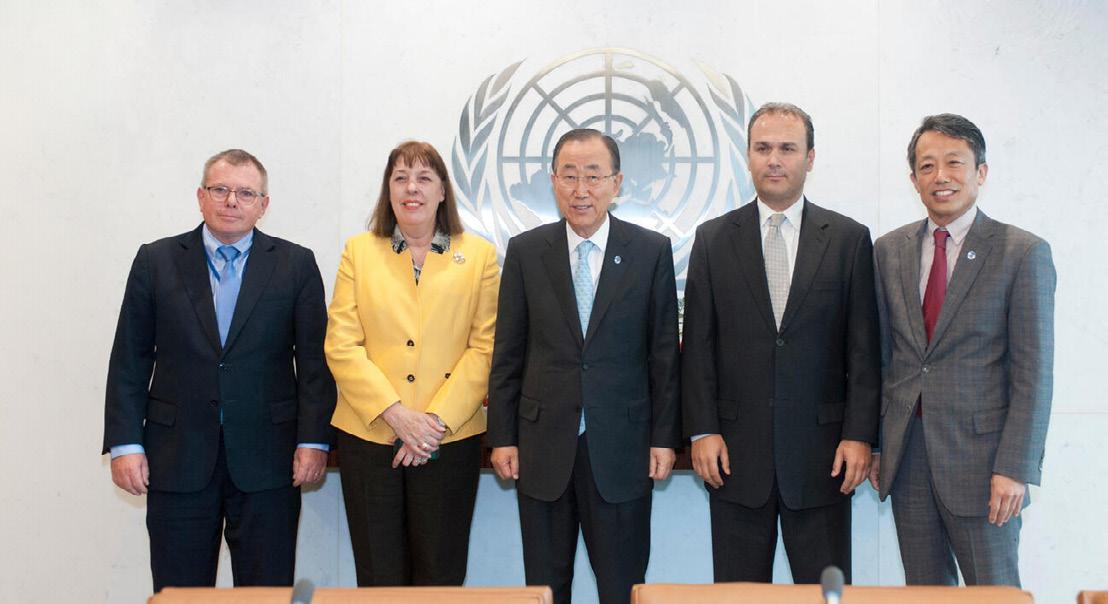
11 James Brady, “Houthi attacks from Yemen show need for controls on advanced missile technology proliferation”, Bulletin of the Atomic Scientists, (January 2024).
12 UNSCR 1540 (2004) defines related materials as ‘materials, equipment and technology covered by relevant multilateral treaties and arrangements, or included on national control lists, which could be used for the design, development, production or use of nuclear, chemical and biological weapons and their means of delivery.’
Issue 1 | 20 YEARS OF RESOLUTION 1540 62
Ban Ki-moon, former Secretary-General, meets Head of the OPCW-UN Joint Investigative Mechanism; Credit: UN Photo/Kim Haughton
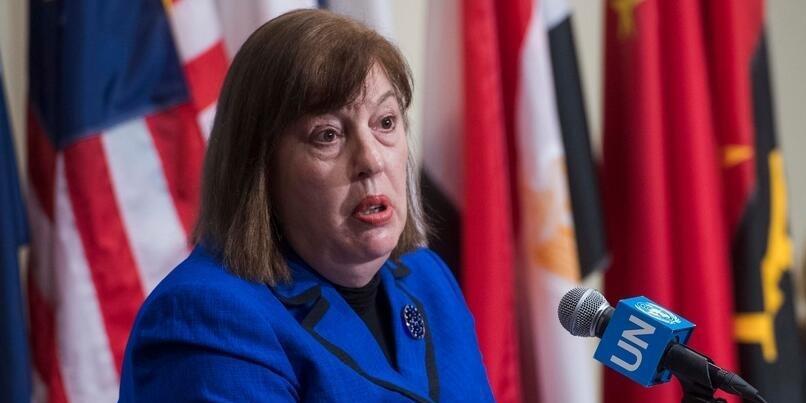
detecting malign actors behind apparently legitimate commercial transactions involving dual-use goods, materials or technologies are compounded by the need to trace the products from the origin to the destination to prevent a potential diversion. Moreover, the score of operators involved, including manufacturers, distributors, freight forwarders, brokers and other intermediaries, exacerbate the complexity of the supply chain, as due diligence efforts have to assess the risk associated with multiple parties involved in transactions, potentially based in different jurisdictions.
In parallel, the revolution in financial technology has reshaped the approach to financial services, bringing about, among other advantages, the enhancement of national authorities’ capabilities in detecting illicit financial flows. Real-time monitoring and analysis of large volumes of financial transactions enable competent agencies to identify patterns that may indicate financial crimes. At the same time, however, the decentralization and the pseudonymity of transactions through blockchains can circumvent the controls of the traditional international financial system. Furthermore, digital
money and virtual assets have become easier targets for cyber criminals, including WMD proliferators, who have stolen, laundered and used them to fund their weapons programmes.13
Against this complex background, the preventive measures mandated by the operative paragraphs 2 and 3 of UNSCR 1540 have never been so pivotal in countering WMD proliferation activities. By embedding the idea that non-State actors may be motivated by interests other than terrorism, such as personal gains, the implementation of prohibitions and
13 See, for example, Department of the Treasury, 2024 National Proliferation Financing Risk Assessment, Washington D.C., U.S.A., February 2024, p. 18.
ARTICLE 63
Virginia Gamba, Head of the OPCW-UN Joint Investigative Mechanism, speaks to thr press; Credit: UN Photo/Amanda Voisard
controls on economic operators potentially exposed to the risk of WMD proliferation will increase the likelihood of detecting and disrupting illicit trafficking.
ADAPTIVE MEASURES
In light of the above-mentioned threats and vulnerabilities, successor resolution 2663 (2022) requests that the 1540 Committee consider the evolution of the proliferation risk in the context of the implementation of the resolution.14
The Security Council prioritizes some measures, emphasizing the need ‘to strengthen export controls, controls on intangible transfers of technology and on information that could be used for WMDs and their means of delivery, proliferation financing and shipments prevention, and securing sensitive materials’.15
While, overall, Member States are gradually progressing towards the full implementation of the different mandated measures, 16 the pace appears slow and the
regulations adopted do not always reflect the “appropriateness” of the measures vis-à-vis the new threats. The lack of technical expertise is one of the key challenges faced by countries in the implementation process.17 Achieving full compliance with the obligations requires a sound understanding of the risk they aim to mitigate, as well as of the measures mandated by the resolution.
Because of their knowledge and expertise, the Group of Experts for the 1540 Committee should steer Member States’ efforts towards compliance and cooperate with the network of technical assistance providers to accelerate the process of a consistent implementation. A harmonized and complete implementation of the preventive measures mandated by the resolution would limit the margins of actions for non-State actors currently exploiting loopholes or uneven implementation of the obligations.
14 United Nations Security Council res. 2663 (30 November 2022) UN Doc S/RES/2663.
15 Ibid.
Although UNSCR 2663 (2022) renewed the 1540 Committee’s mandate for 10 years, it missed an opportunity to empower the Group of Experts with the resources and the operative independence that technical bodies need to fulfil their missions. Notwithstanding, a more proactive role supported by the 1540 Committee, within the current limited mandate, would allow the Experts to guide technical assistance by leading in the coordination of assistance providers’ efforts to optimize the matchmaking between demand and supply.
Of great interest and great support would be the publication of the best practices, templates and guidance, which were produced by the Experts, but not approved by the 1540 Committee 18 The Group of Experts could address misconceptions related to definitions and scope of the provisions, referring to partially compliant implementation measures or cases showing the conse -
16 2022 comprehensive review of the status of implementation of Security Council resolution 1540 (2004)
17 See 2022 comprehensive review of the status of implementation of Security Council resolution 1540 (2004) (S/2022/899), p. 2.
18 Scott Spence, “The 1540 Nonproliferation Regime and United Nations Security Council Resolution 2663 (2022): What’s Been Achieved and What Lies Ahead”, Strategic Trade Review, Volume 9, Issue 10, Winter/Spring 2023, p. 33.
Issue 1 | 20 YEARS OF RESOLUTION 1540 64
quences of the lack of implementation.
Twenty years ago, the prohibitions targeting non-State actors and controls over
commercial and financial flows were ground-breaking as new mandatory measures to address the threats to WMD non-proliferation. It is high time for the 1540 Committee
and the Group of Experts to strengthen the 1540 non-proliferation regime by guiding Member States in mitigating the current risk and boosting the implementation efforts.

ARTICLE 65
The risk of non-State actors misusing emerging technologies presents a serious threat; Credit: Opt Laser
UN SECURITY COUNCIL
RESOLUTION 1540 AND THE CHEMICAL WEAPONS
CONVENTION: CHALLENGES,
COMPLEMENTARITIES AND SYNERGIES
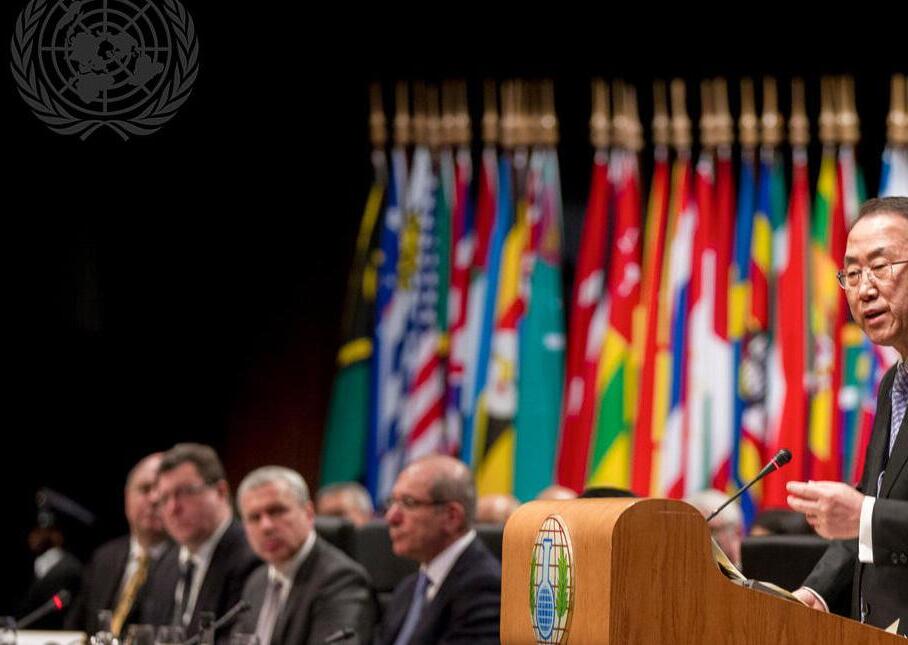
ABSTRACT
This article examines the collaborative potential of UN Security Council resolution 1540 (2004) and the Chemical Weapons Convention (CWC). It delves into implementation obstacles and the interplay between the two instruments, advocating for their inherent synergy to strengthen the international non-proliferation legal framework. Highlighting the complementarity between the CWC and resolution 1540, particularly in preventing nonState actors’ access to chemical weapons and enhancing verification measures, this paper underscores the potential of collaboration for a more comprehensive chemical, biological, and nuclear non-proliferation approach, relying on international cooperation.
66
Opening of the Third Review Conference of the Chemical Weapons Convention; Credit: UN Photo/Rick Bajornas
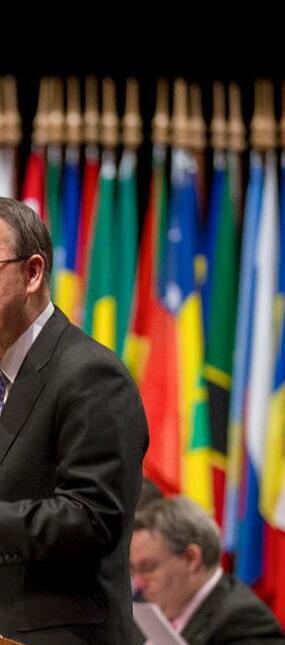
This analysis is presented in commemoration of the 20 year anniversary of the adoption of United Nations Security Council resolution 1540 (2004) (UNSCR 1540). It delves into the interconnection and collaborative potential between UNSCR 1540 and the Chemical Weapons Convention (CWC) in the vital realm of preventing the proliferation of weapons of mass destruction (WMDs), with a particular focus on chemical weapons. By shedding light on the hurdles in implementing the resolution, it meticulously examines the intricate
Rene Betancourt & Victor Calero


Rene Betancourt is an international lawyer, an expert in non-proliferation and counter-terrorism, with extensive experience working within the United Nations system. He currently serves as a Senior Officer at the Organisation for the Prohibition of Chemical Weapons. Additionally, he holds positions as professor of International Criminal Law, Public International Law, and Criminal Policy at universities in Ecuador.
Victor Calero is a lawyer focused on public international law. He has experience working at international organizations in the fields of international criminal law and disarmament.
dynamic between the CWC and resolution 1540. The argument put forward posits that these two instruments can synergize to bolster the overall efficacy of the global non-proliferation regime.
UNSCR 1540
UNSCR 1540 underscores the Security Council’s concern over the proliferation of nuclear, chemical, and biological weapons, along with their means of delivery, to and by non-State actors, deeming it a threat to global peace and
security. Notably, the resolution applies universally, irrespective of States’ WMD status or developmental level, placing strong emphasis on the significance of international collaboration and assistance for the effective implementation of its provisions.
UNSCR 1540 involves the development and enforcement of laws and regulations; the resolution calls upon all States to enhance the security of sensitive materials, establish domestic controls, adopt laws against non-State actors
ARTICLE 67 THE
AUTHORS:
engaging in WMD activities, implement effective national export controls, and regulate access to intangible or dual-use technology.
THE CWC
The CWC is one of the most comprehensive disarmament treaties in the world. Banning a category of weapon, it opened for signature in 1993 and entered into force in 1997. The Convention has 193 States Parties, making it nearly universal. It prohibits the development, production, acquisition, stockpiling, retention, and use of chemical weapons. Its key elements encompass a comprehensive prohibition of chemical weapon-related activities, an extensive verification regime, and a commitment to destroy existing chemical weapons and production facilities under international supervision. Additionally, it mandates States Parties to provide assistance and protection to those affected by chemical weapons, foster cooperation in scientific and technical information exchange, and establish a legislative and regulatory
framework for treaty implementation.
Article VII outlines specific obligations, including the establishment of penalties for violations of the Convention, the implementation of controls over chemical weapon-related activities, the designation of a national authority for communication with the Organisation for the Prohibition of Chemical Weapons (OPCW), and collaboration with other States Parties to facilitate the Convention’s implementation. These obligations aim to ensure the effective implementation and enforcement of the CWC within the national legal frameworks of the States Parties. Overall, the CWC represents a significant achievement in the field of disarmament and non-proliferation.
IMPLEMENTATION
CHALLENGES OF UNSCR 1540
In terms of implementation challenges, a major obstacle for UNSCR 1540 is the difficulties faced by developing countries. These States struggle with a multitude
of pressing development and national security issues that more directly impact the well-being and quality of life of their citizens. Such challenges include pervasive public health issues, insufficient legal frameworks, limited technical capabilities, limited international assistance, and economic instability. In this context, diverting limited resources to address the WMD threat might seem impractical for leaders in the developing world. Persuading these governments to allocate greater and more sustainable investments to counterproliferation initiatives becomes a complex task. Essentially, it is not only a demanding proposition but also one that requires careful navigation through intricate socio-economic and political considerations.1
Another obstacle lies in assessing compliance, due to the reliance on national reports submitted by States. These reports tend to emphasize adherence to regulations while downgrading areas of non-compliance. The 1540 Committee heavily depends on these reports, giving rise
1 Finlay, Brian, et al. “Implementation Challenges for 1540.” Beyond Boundaries in the Middle East: Leveraging Nonproliferation Assistance to Address Security/Development Needs With Resolution 1540, Stimson Center, 2010, pp. 23–25. JSTOR, http://www.jstor.org/stable/resrep10895.8.
Issue 1 | 20 YEARS OF RESOLUTION 1540 68

to apprehensions regarding the credibility of the information provided. The compilation of two sets of data, encompassing legislative developments and enforcement compliance, does indicate progress. However, it also raises pertinent questions about accuracy and realism when portraying the advancements in implementation.2
The aforementioned challenges are also encountered by the CWC. Effectively addressing and transcending these obstacles assumes paramount importance in laying the foundation for a united front against the illicit acquisition and deployment of WMDs by non-State actors.
SYNERGIES AND COMPLEMENTARITIES BETWEEN UNSCR 1540 AND THE CWC
The CWC and UNSCR 1540 share synergies in addressing the global threat of WMDs, albeit from different perspectives. UNSCR 1540 complements the CWC by reinforcing the efforts to prevent the proliferation of chemical weapons.
2 Rehman, H., & Qazi, A. (2019). Significance of UNSCR 1540 and Emerging Challenges to its Effectiveness. Strategic Studies, 39(2), 48–66. https://www.jstor.org/stable/48544299
ARTICLE 69
• OPCW maintains readiness to respond to the use of chemical weapons. Credit: OPCW
The cooperation encouraged by the CWC at the State level aligns with the collective global efforts mandated by UNSCR 1540, emphasizing the importance of international cooperation in preventing the proliferation of WMDs and safeguarding global security. Together, these instruments contribute to a comprehensive framework that addresses both State and non-State actors, fostering a more secure and cooperative international environment.
In terms of the complementarities between the Convention and resolution 1540, both instruments share the objective of preventing the proliferation of chemical weapons. The CWC prohibits the development, production, stockpiling, and use of chemical weapons, and requires States Parties to destroy their existing stockpiles and production facilities and to implement a rigorous system of verification and inspections to ensure compliance. Conversely, resolution 1540 focuses on preventing non-State actors from acquiring and using chemical weapons by requiring States to adopt and enforce effective measures to secure and control chemical weapon-related materials, including
export controls, physical security measures, and border controls.
Another aspect in which the CWC and resolution 1540 can complement each other results from the CWC’s verification and inspection measures, which can be used to supplement UNSCR 1540’s efforts to prevent illicit trafficking of chemical weapon-related materials. The CWC’s provision for international assistance and cooperation can also support the implementation of resolution 1540, particularly in assisting States to establish effective export controls and other measures to prevent proliferation.
Finally, the absence of a precise definition for chemical weapons in UNSCR 1540 presents a notable gap, affording the CWC the opportunity to furnish a thorough definition and introduce the crucial “general purpose criterion.” While UNSCR 1540 expresses apprehension about the proliferation of chemical weapons without providing explicit definitions, the CWC, recognized as one of the world’s most comprehensive disarmament treaties, not only furnishes a precise and comprehensive definition, but also
imposes an unequivocal ban on the development, production, acquisition, stockpiling, retention, and use of chemical weapons, setting a robust verification regime in relation to scheduled chemicals.
CONCLUSION
To sum up, though the implementation of UNSCR 1540 encounters various challenges, the interplay between the CWC and the resolution reveals potential for collaboration. Despite the obstacles faced by UNSCR 1540, particularly in the context of developing countries grappling with multifaceted issues and assessing compliance by relying on national reports, the scrutiny underscores significant opportunities to exploit the intricate dynamic with the CWC. Emphasizing the synergies between both instruments and leveraging their strengths, such as the CWC’s verification measures supplementing UNSCR 1540’s efforts, can create a comprehensive framework addressing both State and non-State actors. Achieving this will require unwavering political determination and dedication from States, coupled with the establishment of robust international cooperation and coordination.
Issue 1 | 20 YEARS OF RESOLUTION 1540 70
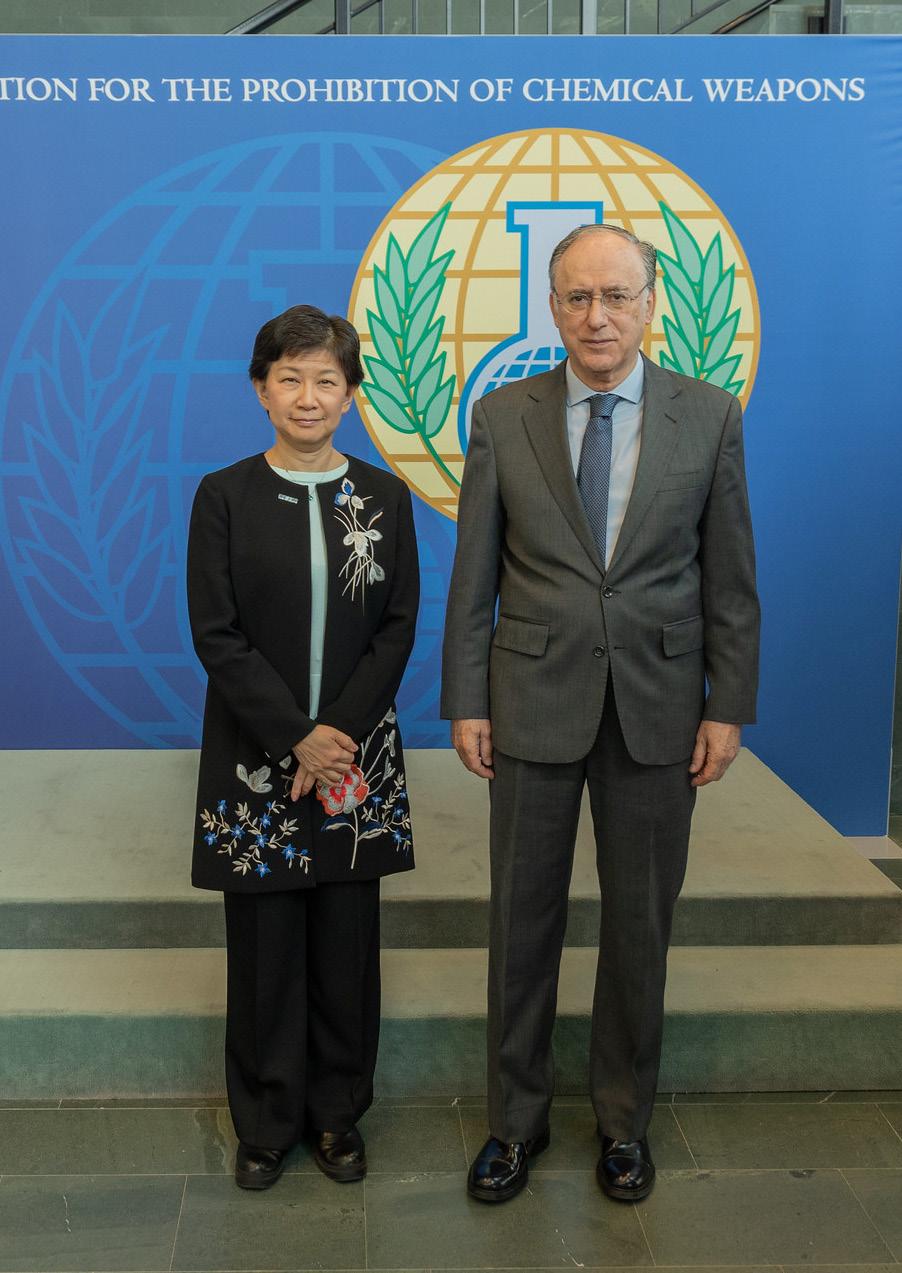 • OPCW Director-General and Ms Izumi Nakamitsu, Under-Secretary-General and High Representative for Disarmament Affairs, United Nations, at the OPCW. Credit: OPCW
• OPCW Director-General and Ms Izumi Nakamitsu, Under-Secretary-General and High Representative for Disarmament Affairs, United Nations, at the OPCW. Credit: OPCW
LINKING CBRN AND SALW NON-PROLIFERATION: LOOKING AHEAD AT POTENTIAL CONJOINED RISKS
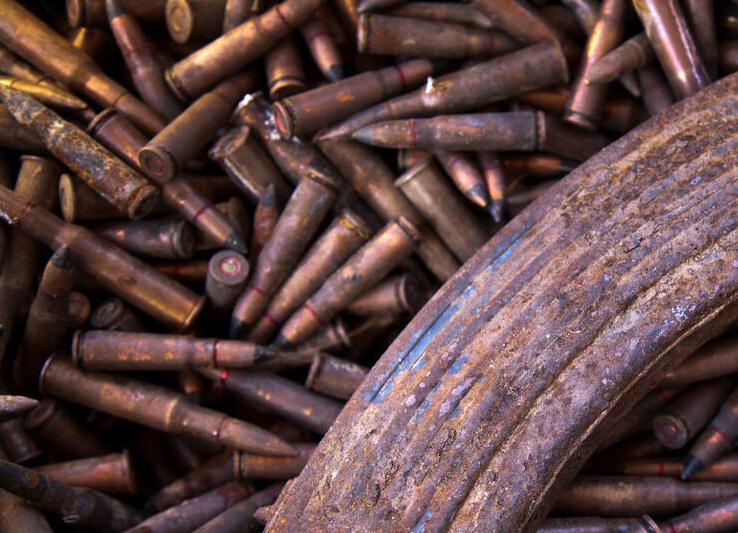
ABSTRACT
The rigorous efforts from multiple key stakeholders have developed an operational basis for the important mandate contained in United Nations Security Council resolution 1540 (2004). However, gaps in implementation of effective and robust chemical, biological, radiological and nuclear (CBRN) non-proliferation methodologies exist among nation-states which denote a lower security priority to CBRN non-proliferating agendas, whether for national interest reasons or financial development constraints. This gap is exploited by non-State actors, and conjoined criminal organizations that seek to profit from the nation’s status quo. As a result of this security aspect, this journal article seeks to create a linkage characterized by a duality approach to policy construction of lagging nation-states vis-à-vis their respective CBRN non-proliferation policies and higher valued conjoined policies, whether small arms and light weapons proliferation, drug trafficking, or any other security related feature sharing overlapping control characteristics that would incentivize a closing, or reducing, of the security gap, thereby reducing overall CBRN proliferation risks.
72
Small arms ammunitions being prepared for destruction in Mali; Credit: UN Photo/Marco Dormino

ACKNOWLEDGMENT OF THE PAST AND PRESENT WHILST LOOKING AHEAD
With the onset of the two-decade mark for the agenda of global non-proliferation of nuclear, chemical and biological weapons, as well as their means of delivery, encapsulated by the momentum behind United Nations Security Council resolution 1540 (2004) (UNSCR 1540), the present article seeks to address a
prospect and challenge that has the potential to metastasize into a concerned risk for State actors, as well as concerned stakeholders, in the foreseeable future. However, before identifying a prospective future risk to UNSCR 1540 implementation, we must first acknowledge a brief historical overview of the lessons learned vis-à-vis the non-proliferation of weapons of mass destruction (WMDs) and their delivery systems to non-State actors,

Erik Farkaš holds an LLB, LLM in public international law, as well as GDL and LPC qualifications (i.e., pre-solicitor qualifications). He is currently operating as a private consultant and frequently writes research papers on matters of interest.
as the recognized highest risk player in the arena of WMD proliferation.
The initial development of WMD non-proliferation was viewed by stakeholders as a long-term project accepting the inherent risks of proliferation that the development of technology could entail.1 The conjoined inferences of technology’s growth in leaps and bounds, and the accelerated development of technology
1 Tom Wuchte, “A Strategy for the 1540 Committee”, 1540 Compass, Winter, Vol. 1, Issue 1, (2012), pg. 4.
ARTICLE 73 THE
AUTHOR: Erik Farkaš
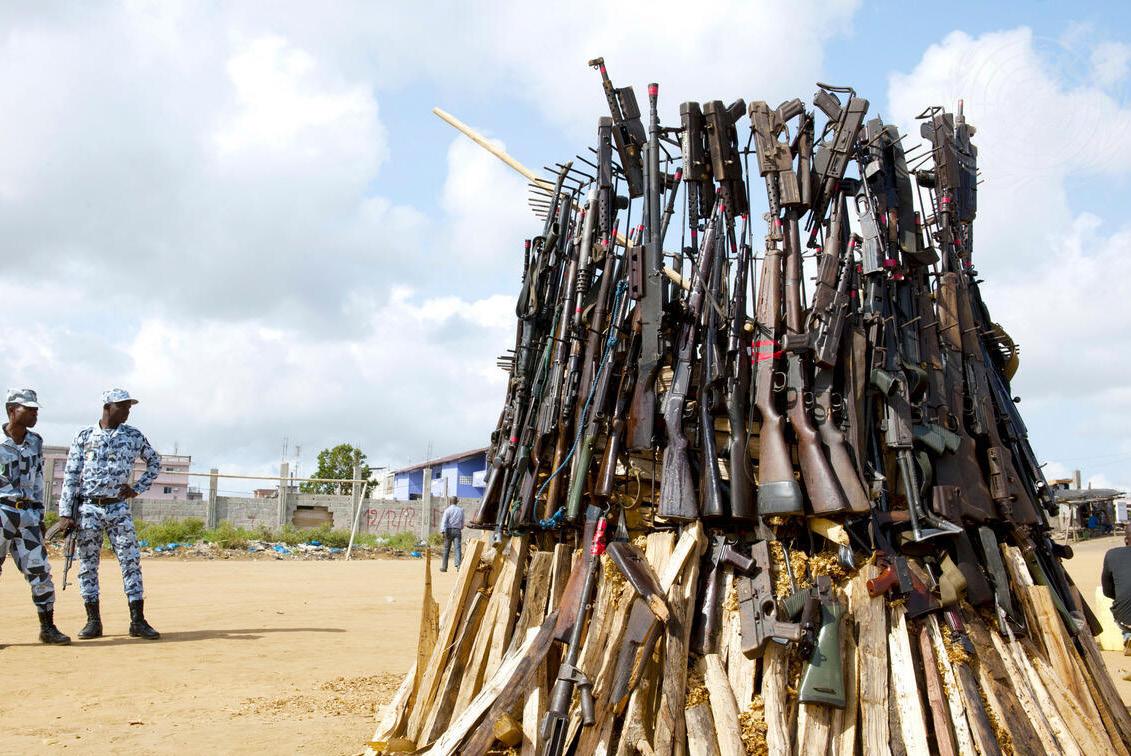
via military-oriented projects are two sides of the same coin of concern.2 A coin that once again has begun to resound around the growing impetus of nation-states to protect their national interests. 3 In order to implement the agenda of non-proliferation embodied in UNSCR 1540 and prevent and mitigate the potential cashing of the coin of concern
resulting in a zero-sum result, State actors, international organizations (IOs), regional and sub-regional actors, supranational organizations, stakeholders, and, in time, private companies4 and civil society operated on parallel lines to achieve the long-term goals embodied in UNSCR 1540. In order to achieve this, respectively within general and spe-
cialized mandates, there arose an enhancement of border controls,5 border systems (i.e., physical and digital infrastructure), legal systems (national, regional and international instruments), trade systems, 6 dual-use safeguards, financial systems, information-exchange and cooperation pipelines, sensitive technology control systems, sanction regimes
2 Comprehensive Review of UNSCR 1540 (2004) Implementation, (1 Dec. 2022), (S/2022/899), para. 117.
3 United Nations General Assembly Resolution – Agenda Item 103(d) (7 Dec. 2020), (A/RES/75/43), pg. 2.
4 Ian J. Stewart, “Partnerships with the Private Sector to prevent Proliferation”, 1540 Compass, Fall, Vol. 1, Issue 4 (2013), pg. 41.
5 Karl Lallerstedt, 1540 Compass Discussion Forum, 1540 Compass, Spring, Vol. 1, Issue 3 (2013), pg. 4.
6 Renaud Chatelus, “Challenges and Engagement for the World Customs Community”, 1540 Compass, Winter, Issue 5 (2014), pg. 21.
Issue 1 | 20 YEARS OF RESOLUTION 1540 74
The National Commission of Small Arms and Light Weapons of Côte d'Ivoire holds a ceremony to destroy small arms and light weapons; Credit: UN Photo/Basile Zoma
and more, under the overall auspices of developing a CBRN security culture7 within State mechanisms to reflect the responsibility and obligation of States as actors of highest authority for non-proliferation concern and implementation.
It is within these contextual settings that this article will seek to elucidate on a single focal avenue which, in the opinion of the author, represents the highest potential for risk culmination within the non-proliferation mandate established by UNSCR 1540. That linkage is the inherent connection between trafficking in small arms and light weapons (SALW), as defined by COM (2019) 293,8 and the potential for non-State actors to launch CBRN-related attacks. The main reason behind the impetus of acknowledging, establishing, and mitigating this identified link within the realm of CBRN non-proliferation is simple: no CBRN attack, ever, has been launched without the preliminary satisfaction and
acquisition of the sufficient degree of weaponry wielded by non-State actors pursuing their own goals (whatever these may be). The sole exception are CBRN infrastructure attacks operating within the digital realm, but this shall not be examined within this article, nor shall the physical failsafe systems operating to prevent such attacks be inspected.
As such this article will seek to establish and solidify the link, without degenerating the vital importance of either specialized mandate by respective actors and stakeholders, and argue for a potential solution to the risk as a novel modus operandi for developing and integrating UNSCR 1540 policy within related projects and capacity building exercises of developed and developing nation-states.
WHAT IS MEANT BY THE ‘LINK’?
Operative paragraph 1 of UNSCR 1540 decides that all States must refrain from
providing any form of support to non-State actors seeking to acquire or develop nuclear, chemical or biological weapons and their means of delivery. The degree of support encapsulated by the phase “any form” implies, on the surface, both direct and indirect forms of support as contradictory to the non-proliferation goals of all States. The natural exception of this momentum is contained within the natural interest umbrella of a nation-state.9 Furthermore, the degree of risk inherent in CBRN weapons’ deployment is sufficiently accepted to give rise to the current culture of security and control for States that possess the military and technical functionalities enabling them to deploy such weapons. And yet, when we speak of CBRN weapons’ deployment, we speak of their risks, mainly due to the success of the embedded and developed security culture of CBRN weapons, but also because of the calculated potential scenario for a zero-sum game result
7 I. Khripunov, A. Eyzaguirre, & J. Alcorn, “A Blueprint of CBRN Security Culture”, 1540 Compass, Summer, Vol 1. Issue 2 (2012) pg. 8.
8 European Commission, “Report from the Commission to the European Parliament and the Council: Evaluation of the 2015-2019 action plan on firearms trafficking between the EU and the south-east Europe region”, Brussels, 27.6.2019, COM (2019) 293 final, pg. 2.
9 Annex of the Report of the 8th Biennial Meeting of States to Consider the Implementation of the Programme of Action to Prevent, Combat and Eradicate the Illicit Trade in Small Arms and Light Weapons in All Its Aspects, New York, 8 July 2022, (A/CONF.192/ BMS/2022/1), para. 2.
ARTICLE 75
between States that possess CBRN weapons. As a result of these interweaving factors, the overwhelming majority of nation-states have accepted that the actual use of CBRN weapon technology is unacceptable.
The same cannot be said for the deployment of small arms and light weapons, mainly because if the highest risk weaponry poses the highest catastrophic scenario, especially in the hands of non-State actors, the use of SALWs poses a “containable scenario” and can thus be incorporated into the national interest objectives of nation-states.10 The link between these two factors becomes a serious risk, as opposed to a passive (and thus controllable) risk, when non-State actors gain “the capacity” to acquire CBRN weapons. Paradoxically, non-State actors can only gain the capacity to do this if they possess SALWs.11
The further parsing between “friendly” non-State actors, and “hostile” non-State actors, albeit of specific interest to the overall implementation momentum behind UNSCR 1540 if the link is recognized, will not be examined here as this rests on the knife edge of the national interest balancing act. A parallel concern is applicable to the funding of non-State actors (as a pre-requirement to obtaining SALWs, let alone, CBRN weaponry), and, thereby, an analysis of the global financial system in consideration of the non-proliferation agenda, which will be placed beyond the scope of this article.
As such, the “link” is the fluctuation of risk tied to the “degree” of SALW proliferation, both in the licit (mainly in lieu of diversion 12 and open-ended market loopholes)13 and illicit markets (mainly in lieu of demand and supply) 14 , and the acquisition of capacity by non-State actors to acquire
CBRN deployment capacity. In the opinion of the author, recognition of this link and its incorporation into the CBRN non-proliferation mechanisms of nation-states is imperative to reducing the actual risk of CBRN proliferation. Rendering it a passive aspect dealt with only by existing mechanisms, whether national or international per mandate, will increase the risk of terrorist occurrences in non-war fronts, and, in conjunction, may exacerbate CBRN acquisition by non-State actors to the detriment of UNSCR 1540 implementation.
MITIGATING THE RISK: A DUALITY APPROACH
The link illustrates the dangerous spill-over potential of SALW trafficking into the hands of criminal and terrorist organizations,15 with a conjoined negative effect on the CBRN non-proliferation agenda. 16 Viewed from a different perspective, the UNSCR 1540 implementation
10 Office for Disarmament Affairs, “UN Disarmament Yearbook 2022”, New York, Vol. 47, (2023), pg. 35.
11 Lauren Pinson, “Addressing the linkages between Illicit Arms, Organized Crime and Armed Conflict”, UNIDIR, UNODC, (14 Sept. 2022), pg. 4.
12 Duquet N., & Goris K., “Firearms Acquisition by Terrorists in Europe: Research findings and policy recommendations of Project SAFTE”, Flemish Peace Institute, Brussels, (18 April 2018), pg. 19.
13 Petr Litavrin, “The way forward for UNSCR 1540”, 1540 Compass, Special Edition, Issue 6, pg. 23.
14 UN Secretary General Report: Small Arms & Light Weapons, (30 Sept. 2021) (S/2021/839), para. 6 & 14.
15 Security Council Meeting of 8th Sept. 2022, 3:00 p.m., Mr. Gómez Robledo Verduzco (Representative for Mexico) (S/PV.9127).
16 Ali Rached, “INTERPOL’s CBRNE Capacity & UNSCR 1540”, 1540 Compass, Winter, Issue 8 (2015) pg. 18.
Issue 1 | 20 YEARS OF RESOLUTION 1540 76
The rekindling of effective CBRN implementation can therefore best be tackled with a duality approach
goals 17 are stymied by their lack of perceived relevance by States who do not possess solitary CBRN deployment or transit capacity, and for whom the aspect of non-proliferation is a lesser prioritized risk, 18 or by States with problematic transit capacity. The risk stemming from the link cannot be more succinctly exemplified than with the contemporary19 and current affairs in Yemen.
As aptly stated in the 2016 UN Register of Conventional Arms (UNROCA), 20 the realities of conflict in the 21st century were such that efforts to control SALW trafficking were
not a high-priority issue for the international community. Even though this statement was couched within the reporting obligations of nation-states for traditional military armaments, and without the inclusion of complex capacity issues prevalent both for SALW trafficking and CBRN trafficking, it remains, nonetheless, a pervasive problem which crystalizes in a different risk appreciation for CBRN over SALW trafficking (or vice versa).21
The rekindling of effective CBRN implementation can therefore best be tackled with a duality approach: satisfy an overlapping or parallel concern of a country who has not yet adequately implemented CBRN security measures, by, for example, tackling their respective national security concerns for SALW trafficking, or drug trafficking, or any other illicit methodology providing funding to crimnal and terrorist organizations, and, in doing so, develop a more robust
and acute system for CBRN non-proliferation. An inherent risk is being forced to appeal to two agendas, but, if said agendas can be created so as to satisfy a minimum overlapping capacity for mitigation, detection, prevention and more (i.e., 60% viable operative agenda, with 100% being a true duality of purpose) of both SALW and CBRN trafficking, then the dichotomy revolving around the coin of concern can be met.
For countries with secure neighbouring countries, this may not be a pressing issue,22 but, once again, for countries that find themselves subject to neighbouring conflicts or risks thereof (whether in preliminary phases, or growing by the month), the duality approach can assist in solidifying CBRN non-proliferation, whilst satisfying a parallel pertinent risk of the concerned neighbouring country.
17 Comprehensive Review of UNSCR 1540 (2004) Implementation, (1st Dec. 2022) (S/2022/899), para. 22.
18 Michael Beck, “Implementation Challenges for Small and Developing Countries”, 1540 Compass, Fall, Vol. 1, Issue 4 (2013), pg. 11.
19 United Nations Security Council – Letter from Panel of Experts on Yemen, (26 Jan. 2016) (S/2016/73), para. 84 & 85.
20 Report on the Continuing Operation of the UN Register of Conventional Arms and its Further Development (2016) (A/71/259), para. 61.
21 Report by the 2022 Group of Governmental Experts – Report on the Continuing Operation of UNROCA (2023) (A/77/126), para. 34.
22 EU Commission, “Communication from the Commission to the EP, the Council, the European Economic and Social Committee and the Committee of the Regions: 2020-2025 EU Action Plan on Firearms Trafficking”, Brussels, (24.7.2020)(COM(2020) 608 final), pg. 5.
ARTICLE 77
BIOTERRORISM IN NATIONAL COUNTER-TERRORISM LEGISLATION: DEVELOPMENTS SINCE 2004

ABSTRACT
Since the adoption of United Nations Security Council resolution 1540 (2004) (UNSCR 1540), most of the new legislation criminalizing activities related to biological weapons has been counter-terrorism legislation. There are three different main approaches to biological weapon-related terrorist activity that can be identified: 1) the inclusion in the definition of terrorist acts; 2) separate specific provisions; and 3) inclusion in the definition of a ‘lethal device’ or ‘weapon’. Regardless of the chosen approach, it is common that not all activities referred to in UNSCR 1540 are criminalized in national counter-terrorism legislation. The most comprehensive approach is commonly seen in counter-terrorism legislation that incorporates biological weapon-related acts under the definition of terrorist acts.
78
The potential use of biological materials for malicious purposes represents a grave threat to international security; Credit: National Cancer Institute

INTRODUCTION
United Nations Security Council resolution 1540 (2004) (UNSCR 1540) is pivotal for combating weapons of mass destruction (WMD) terrorism, imposing obligations on States to adopt effective laws prohibiting non-State actors to manufacture, acquire, possess, develop, transport, transfer or use nuclear, chemical or biological weapons and their
means of delivery, particularly for terrorist purposes. This requires the adoption of national penal legislation addressing these acts. It has now been 20 years since the adoption of this resolution, during which many States have adopted legislation seeking to prohibit and prevent terrorism, including provisions related to WMDs. To date, most of the legislation criminalizing biological weapon-related

Barry de Vries is a Postdoctoral Research Fellow at the JustusLiebig University Giessen in the project CBWNet. He works extensively in the fields of arms control law, international humanitarian law, international criminal law and comparative law. This work was supported by the German Federal Ministry of Education and Research (Grant Number 01UG2202A).
activity since the adoption of UNSCR 1540 has specifically been counter-terrorism legislation. 1 This contribution analyses counter-terrorism legislation adopted in the last 20 years to determine how bioterrorist activities have been criminalized. To this end, a near comprehensive collection of counter-terrorism legislation has been analysed.
1 Barry de Vries, “Recent Developments in the National Implementation of Biological Weapons Convention: What Happened Since Resolution 1540?”, (2023)28(3) Journal of Conflict and Security Law, Vol. 28, No. 3 (Winter 2023), p. 579.
ARTICLE 79 THE AUTHOR:
Barry de Vries
When considering the legislation adopted in the last 20 years, it becomes clear that different States have chosen to take varying approaches. However, three main approaches to criminalizing bioterrorism can be identified. Namely, the inclusion of biological weapon-related activities under the definition of terrorist acts, their inclusion in a separate provision providing for their criminalization and lastly, the inclusion of biological weapons under the definition of deadly devices or weapons. Although other approaches exist, they are not
very common. This article will provide an overview of these three different approaches and identify to what extent they address all relevant activities, before providing best practices for criminalizing acts of bioterrorism in line with UNSCR 1540.
TERRORIST ACTS
The first common inclusion of bioterrorist acts is through the definition of terrorist acts. There are two different ways this has been done. The first concerns the specific prohibition of the use of a biological agent. An example of this type
of provision can be found in the definition of terrorist acts in the counter-terrorism legislation of the Seychelles, which includes:
(vi) involves releasing into the environment or any part of it or distributing or exposing the public or any part thereof to–
(…)
(c) any microbial or other biological agent or toxin;2
Nearly identical provisions can be found in, for example, the counter-terrorism legislation
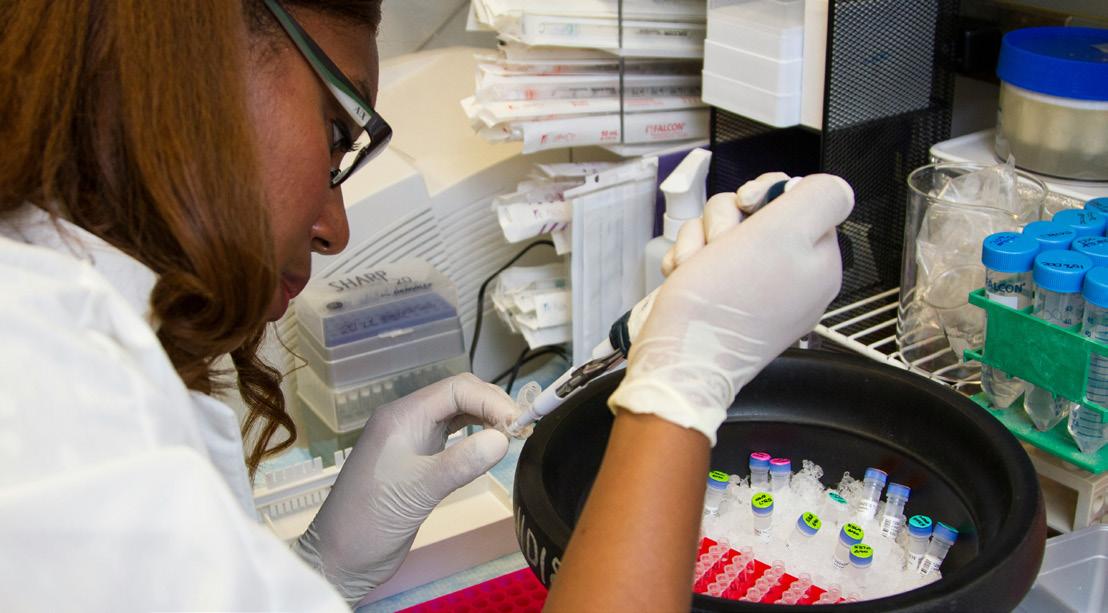
Issue 1 | 20 YEARS OF RESOLUTION 1540 80
2 Prevention of Terrorism Act 2004, Act 7 of 2004.
Scientific research represents a peaceful use of biological toxins that is not prohibited by the resolution; Credit: National Cancer Institute
of Cote d’Ivoire,3 Vanuatu4 and Zambia, 5 Different formulations, however still restricted to the use or another related act, can be found in, for example, the legislation of Botswana,6 Cameroon,7 Chad,8 and Chile. 9 This approach, however, generally does not comprehensively address proliferation of biological weapons for terrorist purposes.
The other approach is to include a more comprehensive list of biological weapon-related activities in the definition of terrorist acts. An example of this can be found in the definition of terrorist acts in the Nigerian Terrorism (Prevention) Act which includes
the following:
(c) involves or causes, as the case may be: (…)
(iv) the manufacture, possession, acquisition, transport, supply or use of weapons, explosives or of nuclear, biological or chemical weapons, as well as research into, and development of, biological and chemical weapons without lawful authority.10
SEPARATE PROVISIONS
The second common inclusion of bioterrorism is to have related acts as separate crimes in the counter-terrorism legislation. Examples of such provisions can be found in the 2018 Zambian Anti-Terrorism and Non-Proliferation Act, which prohibits proliferation. 16 Other examples include Article 10A of the Indonesian Law on Counter-Terrorism17 and Article 5(1) of Grenada’s Terrorism Act.18 These examples specifically address proliferation activities
Similar provisions can be seen in, for example, the legislation of Albania,11 Cyprus,12 Lesotho,13 Malta14 and Mauritania.15 This approach comprehensively addresses the issue of bioterrorism and criminalizes all acts referred to under UNSCR 1540.
3 Art. 3 Law No. 2015-493 of 7 July 2015 on the suppression of terrorism.
4 Section 3 Counter-Terrorism and Transnational Organised Crime Act, Act 29 of 2005.
5 Section 1 the anti-terrorism and non-proliferation act, 2018.
6 Section 2(1)(f) Counter-Terrorism Act 2014 (this also refers to transporting, however no other proliferating acts).
7 Section 2(2)(b) Law No. 2014/28 of 23 December 2014 of the suppression of Acts of Terrorism.
8 Art. 16 Law on the Suppression of Terrorism 2015.
9 Art. 2(4) Law 18.314 on terrorist behaviour and related penalties (as amended).
10 Art. 1(2)(c)(v) Terrorism (Prevention) Act, Act. No. 10 2011.
11 Art. 230 Penal Code of Albania.
12 Art. 5 The Anti-Terrorism and Victim Protection Law of 2019, Number 75(I) of 2019.
13 Art. 96 Penal Code Act 2010.
14 Art. 328A Malta Criminal Code (Amendment) Act, Act No. VI of 06 June 2005.
15 Art. 3 Mauritania Law No. 2010-035 of 21 July 2010 Repealing and Replacing Law No. 2005-047 of July 26, 2005 relating to the Fight against Terrorism.
16 Art. 21 Anti-Terrorism and Non-Proliferation Act No. 16 of 2018.
17 Law No. 5 2018 amending law number 15 of 2003 concerning the stipulation of government regulations in lieu of law number 1 of 2002 concerning the eradication of criminal acts of terrorism.
18 Terrorism Act, 2012, Act No. 16 of 2012.
ARTICLE 81
and do not include use, instead relying on separate but more general provisions to address use. Dominica, 19 Guyana, 20 Trinidad and Tobago21 are, on the other hand, examples that specifically only address use in their separate provision on biological weapons. Some States have sought to address the issue comprehensively in a specific provision of their counter-terrorism legislation, such as Burundi, 22 although this is uncommon in these types of provisions.
‘LETHAL DEVICE’ OR ‘WEAPON’
The third way bioterrorism has been addressed is through including biological weapons under the definition of ‘weapon’ or ‘lethal device’. In the case where they are included under the definition of ‘lethal device’, this is a clear imple-
19 Section 29 2018 Anti-Terrorism Act.
mentation of the International Convention for the Suppression of Terrorist Bombings, which uses the exact same verbiage. 23 It is then subsequently prohibited to use such a lethal device in a public place, a government facility or in public transport or other infrastructure facilities. This can be found in, for example, the legislation of Afghanistan24, Belize,25 Jamaica, 26 and Kiribati. 27
Other States have subsumed biological weapons under the definition of ‘weapon’ and provide for general provisions addressing the providing, stockpiling or possessing of weapons in different terrorist contexts. Such an approach can, for example, be found in the legislation of Eswatini, 28 Ghana,29 and Kenya.30 These provisions however generally do not address the issue comprehensively and do not incor-
20 Section 29 Anti-Terrorism and Terrorist Related Activities Act 2015.
21 Section 22 Anti-Terrorism Act 2005.
22 Art. 617 Law No. 1/05 of 22 April 2009 revising the Penal Code.
23 UN, Treaty Series, vol. 2149, No. 37517.
24 Art 3, 14 Law of Combat against Terrorist Offences 2008.
25 Section 2C(1)(a)(i) Money Laundering and Terrorism (Prevention) Act.
26 Section 3 Terrorism Prevention Act 2005.
porate all acts referred to in UNSCR 1540.
THE WAY FORWARD
The counter-terrorism legislation that has been adopted in the last 20 years generally does attempt to incorporate biological weapons and bioterrorism, however, in many instances, these do not address the issue comprehensively. Not all acts referred to in UNSCR 1540 are incorporated in many pieces of legislation. Counter-terrorism legislation most commonly does specifically address the use of biological weapons. In many instances, such approaches could possibly address some of the proliferation-related acts, such as acquiring and development, under preparatory acts, however this would generally not address all proliferation activities. At the
27 Section 2, 39 Measures to Combat Terrorism and Transnational Organised Crime Act 2005.
28 Art. 13 Suppression of Terrorism Bill 2008.
29 Arts. 13, 40 Anti-Terrorism Act 2008, 10 October 2008.
30 The Prevention of Terrorism Act, No. 30 of 2012.
Issue 1 | 20 YEARS OF RESOLUTION 1540 82
same time, in the case that there are specific provisions for biological weapons, these generally are restricted to proliferation activities, not explicitly addressing use. Consequently, especially in the case where there is no other legislation addressing biological weapons, which is the case in many States, the counter-terrorism legislation does not address all acts referred to in UNSCR 1540.
While there has been significant development since the
adoption of UNSCR 1540, the counter-terrorism legislation in many States is not yet in the capacity to address bioterrorism in a comprehensive manner, especially related to early prevention, and continued efforts are necessary to ensure further development and improvement. Consequently, there are still significant efforts that need to be made to ensure full implementation of the obligation to enact penal legislation under UNSCR 1540. It is therefore important that care is taken in the develop-
ment of new counter-terrorism legislation or that a comprehensive approach is pursued when amending existing legislation. There is a need for a comprehensive approach in national counter-terrorism legislation and, from State practice, this currently has best been achieved by incorporating a comprehensive list of prohibited activities under the definition of terrorist acts.

ARTICLE
Scientific research being performed for peaceful purposes; Credit: National Cancer Institute
TWO DECADES OF UNODC’S ASSISTANCE TO MEMBER STATES TO MEET UNSCR 1540 OBLIGATIONS

ABSTRACT
This article describes how the mandate of the United Nations Office on Drugs and Crime (UNODC) is relevant to the promotion and implementation of United Nations Security Council resolution 1540 (2004) (UNSCR 1540). It also touches upon the related assistance that UNODC offers to States. Since the adoption of the resolution 20 years ago, UNODC has contributed to its implementation worldwide through the provision of related legislative assistance, the development of training tools and the delivery of activities to build capacities in Member States.
84
A sign warning of risk of radiation; Credit: Kilian Karger

*
and
As we mark 20 years since the adoption of United Nations Security Council resolution 1540 (2004) (UNSCR 1540), the United Nations Office on Drugs and Crime (UNODC) continues to provide assistance to Member States which may help them fulfil some of their obligations under the resolution, building upon the synergies between the latter
and the seven international legal instruments against chemical, biological, radiological and nuclear (CBRN) terrorism discussed in the next paragraphs. According to the final report of the 2022 Comprehensive Review of the status of implementation of UNSCR 1540, slightly more than half of the measures envisaged in UNSCR 1540

Maria Lorenzo Sobrado is the Head of the CBRN Terrorism Prevention Programme at the Terrorism Prevention Branch of UNODC. The programme promotes the universalization of the international legal framework against CBRN terrorism and assists States with its effective implementation.
She serves as UNODC’s focal point for UNSCR 1540. A lawyer by training, she has a Master’s in Non-proliferation of WMDs and a Diploma in Nuclear Law.
have been implemented by UN Member States.
By providing a solid foundation for States to combat the proliferation of weapons of mass destruction (WMDs) by non-State actors, seven international legal instruments against CBRN terrorism align closely with the resolution’s objectives and may significantly reinforce
ARTICLE 85 THE
AUTHOR:
Maria Lorenzo Sobrado*
The views expressed in this article are those of the author and do not necessarily represent those of the United Nations Office on Drugs
Crime (UNODC). The author wishes to thank her colleagues from UNODC Adam Bacheller, Francesca Adrian, Artem Lazarev and Martin Reggi for their contribution to this article.
the effective implementation of UNSCR 1540 by Member States. These seven instruments are actively promoted by the CBRN Terrorism Prevention Programme of UNODC.
UNODC’S MANDATE AND RELEVANT INSTRUMENTS
UNODC’s mandate to promote adherence to and effective implementation of the international legal instruments dealing with CBRN terrorism stems from UN General Assembly resolutions. 1 These instruments deal with the criminalization of certain conduct by non-State actors involving CBRN weapons or materials. The conduct ranges from the illicit possession, handling and use of CBRN material to discharging WMDs from or against ships or aircraft, to nuclear smuggling. The seven instruments also require States to criminalize ancillary offences, such as attempts, participation, and several forms of assistance.
It should be highlighted that not all the above-mentioned instruments make terrorist motivation a necessary condition for a conduct to be criminalized under national
law. In some cases, it is an element of the offence, and in others, the possibility remains open to national legislators to include such intent as an aggravating factor.
By obliging States to criminalize certain acts involving CBRN materials, the seven instruments assist them to fulfil several of their obligations under UNSCR 1540, specifically under its operative paragraph 2. This paragraph decides that all States shall “adopt and enforce appropriate effective laws which prohibit any non-State actor to manufacture, acquire, possess, develop, transport, transfer or use nuclear, chemical or biological weapons and their means of delivery, in particular for terrorist purposes, as well as attempts to engage in any of the foregoing activities, participate in them as an accomplice, assist or finance them.”
Additionally, the Convention on the Physical Protection of Nuclear Material (CPPNM) and its 2005 Amendment ask States to protect nuclear material at certain levels specified therein. It is worth noting that operative paragraph 3 of UNSCR 1540
Seven international legal instruments against terrorism:
• 1980 Convention on the Physical Protection of Nuclear Material (CPPNM)
• 1997 International Convention for the Suppression of Terrorist Bombings
• 2005 International Convention for the Suppression of Acts of Nuclear Terrorism (ICSANT)
• 2005 Amendment to the CPPNM (A/ CPPNM)
• 2005 Protocol to the Convention for the Suppression of Unlawful Acts against the Safety of Maritime Navigation
• 2005 Protocol to the Protocol for the Suppression of Unlawful Acts against the Safety of Fixed Platforms located on the Continental Shelf
• 2010 Convention on the Suppression of Unlawful Acts relating to International Civil Aviation
1 The latest one is A/RES/78/226.
Issue 1 | 20 YEARS OF RESOLUTION 1540 86
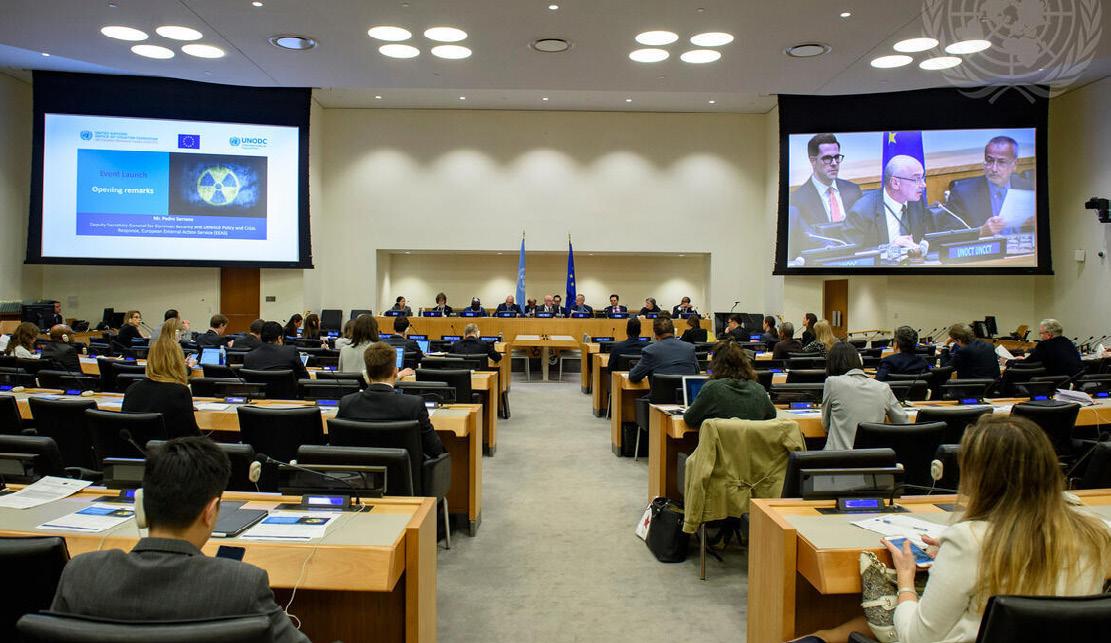
asks States, among other things, to “develop and maintain appropriate effective physical protection measures.”
It is important to emphasize that the seven instruments are included in the 1540 Matrix template, which is the primary method used by the 1540 Committee to collect information about implementation of the resolution by Member States. The matrices are prepared by the Group of Experts based on information received from national reports sent to the 1540 Committee and from other official
government information. They are then approved by the 1540 Committee. Individual matrices are used as “a reference tool for facilitating technical assistance and to enable the Committee to continue to enhance its dialogue with States on their implementation” of UNSCR 1540.2
As for the obligation enshrined in the resolution to adopt and enforce laws prohibiting non-State actors from financing the acts described, the International Convention for the Suppression of the Financing of Terrorism is
2 www.un.org/en/sc/1540/national-implementation/1540-matrices.shtml.
also an instrument of key importance for States.
UNODC’S TECHNICAL ASSISTANCE
Adhering to and effectively implementing the international legal instruments against CBRN terrorism at the national level can be challenging. UNODC’s CBRN Terrorism Prevention Programme can provide expertise through legislative and other technical assistance in that regard. The assistance is tailored to the individual needs of a beneficiary country and includes
ARTICLE 87
UNODC event on promoting universalization of International Convention for Suppression of Acts of Nuclear Terrorism; Credit: UN Photo/Loey Felipe
the following, available upon request:
• Raising awareness on the importance and benefits of adhering to and fully implementing the instruments;
• Assisting national policymakers and legislators in drafting and reviewing relevant national legislation;
• Training criminal justice and law-enforcement officials in the effective investigation, prosecution and adjudication of relevant offences covered by the instruments;
• Enhancing international cooperation in criminal matters related to CBRN terrorism.
The key role played by UNODC in furnishing assistance to Member States to prevent CBRN terrorism has been recognized by the afore-mentioned UN General Assembly resolution, as well as in a variety of relevant fora. UNODC
is a member of the UN Global Counter-Terrorism Coordination Compact’s Emerging Threats and Critical Infrastructure Protection Working Group, an observer at the Global Partnership Against the Spread of Weapons and Materials of Mass Destruction and a corresponding organization at the Inter-Agency Committee on Radiological and Nuclear Emergencies, among others.
In October 2022, the UN Office of Legal Affairs transferred to UNODC the task of receiving and disseminating notifications of designation of competent authorities and liaison points made by States Parties under article 7(4) of the International Convention for the Suppression of Acts of Nuclear Terrorism (ICSANT).
In the past four years, UNODC aided over 120 countries within the framework of two projects funded by the Government of Canada and the European Union (EU) that focus on three out of the seven instruments (ICSANT, CPPNM and A/CPPNM). These efforts contributed to the adherence of 20 new States to these in-
3 www.unodc.org/icsant/en/events/Events.html.
struments against nuclear terrorism, raised awareness of some 750 officials and trained over 170 national criminal justice officials, to mention just a few examples.3 Additionally, nearly 3,000 professionals completed UNODC’s eLearning modules on the international legal framework against CBRN terrorism4 and on ICSANT.5
Complementing the technical assistance provided by UNODC’s CBRN Terrorism Prevention Programme, additional assistance within the scope of operative paragraph 3(c) of resolution 1540 is provided through UNODC’s Border Management Branch (BMB) Passenger and Cargo Border Team programme. Within this programme’s framework, strategic trade and export control (STEC) training is delivered to participating Member State’s frontline officer units.
STEC training is considered an advanced course, building on the fundamentals of targeting and risk analysis to select the cargo shipments presenting the highest potential risk
4 www.unodc.org/icsant/en/web-stories/unodcs-elearning-module-on-the-international-legal-framework-against-chemical--biological--radiological-and-nuclear-terrorism.html.
5 www.unodc.org/icsant/en/icsant-elearning-module.html.
Issue 1 | 20 YEARS OF RESOLUTION 1540 88
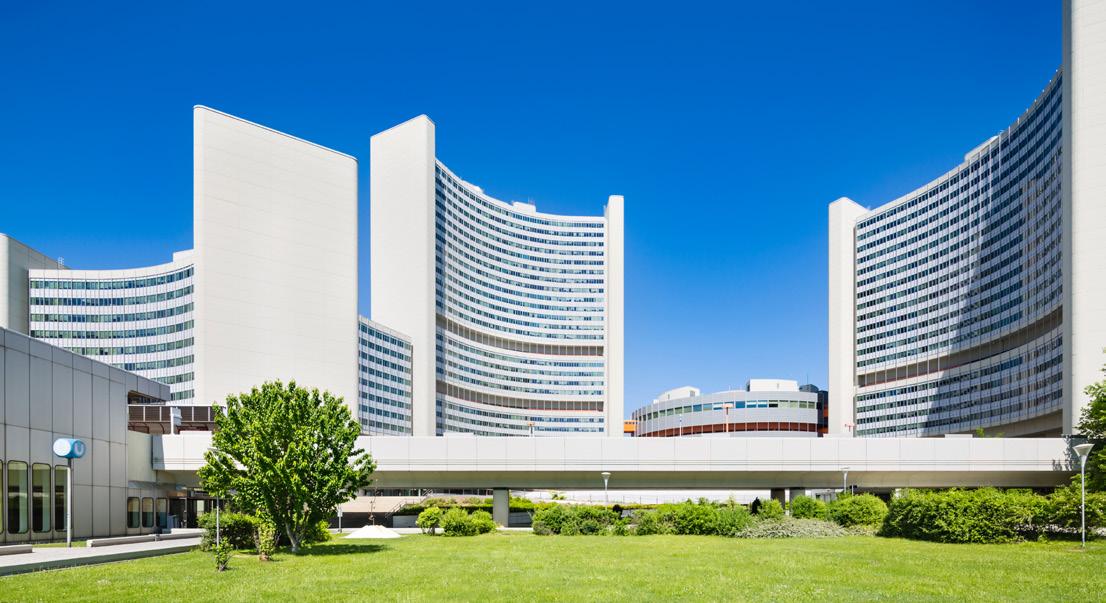
for examination, while facilitating legitimate trade. The advantage for the participating Member States is that this enhances their capabilities to meet their UNSCR 1540 responsibilities in one aspect (in other words, through effective border controls), especially when combined with other programmes such as the World Customs Organization’s Strategic Trade Control Enforcement (STCE) project.
ADDRESSING CHALLENGES
Legislative incorporation of the international legal instru-
ments may pose some difficulties for Member States due to a variety of factors, such as the complexity of the issues covered, as well as differences in scope and definitions between some conventions. Accordingly, in addition to offering legislative assistance to States, UNODC developed model legislative provisions for the implementation of the criminalization provisions of: (1) the international legal instruments against terrorism, which also include those dealing with CBRN issues; and (2) ICSANT, CPPNM and its 2005 Amendment. 6 The latter were produced in co -
6 www.unodc.org/icsant/en/model-legislation.html.
7 Para. 12.
operation with the International Atomic Energy Agency (IAEA) in 2009. Furthermore, UNODC launched a regularly updated website on ICSANT, the use of which has been recently encouraged by UN General Assembly resolution A/RES/78/226. 7 It hosts a panoply of materials related to the Convention in all six United Nations official languages, with some also translated into other non-official languages. Among other resources, the website currently contains submissions from over 50 States Parties to the Convention on the legislation they enacted to implement its criminalization
ARTICLE 89
UN Headquarters, Vienna, Austria
provisions, which may serve as reference for other States.
UNODC continues to raise awareness on the benefits and importance of Member States becoming party to the international legal instruments against CBRN terrorism, apart from being synergetic with the implementation of UNSCR 1540 that is binding on all of them. Some States nevertheless may not recognize these benefits.
For example, a country that does not have nuclear material might perceive the threat of nuclear terrorism as minimal and hence not prioritize these treaties. However, the country may be at risk, as nuclear and other radioactive material may be smuggled into its territory, or its citizens might fall victim to a nuclear terrorist attack abroad, or the perpetrator of such an attack might find refuge in its territory. Being
a party to the international legal instruments and having the relevant domestic legislation in place would enable this country to effectively prosecute offenders for smuggling nuclear material, or claim jurisdiction over the terrorist act involving its citizens and have a legal basis to prosecute perpetrators found in its territory (or, alternatively, extradite them to another country also having jurisdiction for prosecution).

Issue 1 | 20 YEARS OF RESOLUTION 1540 90
Signs warning of potential danger related to radioactive material; Credit: Dan Meyers
Another challenge many States face is the lack of experience and expertise to effectively implement the provisions of the international legal framework against CBRN terrorism. To tackle these issues and assist States with the adherence to and legislative implementation of that framework, UNODC has developed multiple tools, resources and activities that include, among others, the following:
• Self-assessment questionnaire for countries considering adherence to ICSANT;
• Manual on fictional cases related to offences under ICSANT;
• eLearning module on the Convention’s key provisions;
• eLearning module on the international legal framework against CBRN terrorism (including a section on UNSCR 1540);
• Webinar series on international legal approaches and criminal justice responses to countering CBRN terrorism; 8 S/RES/2663.
• Mock trial and table-top exercises;
• National seminars on ICSANT for judicial education and training centres.
COOPERATION WITH THE 1540 COMMITTEE, ITS GROUP OF EXPERTS AND OTHER ENTITIES
UNODC has excellent working relations with the 1540 Committee and its Group of Experts. The Office positively responds to requests for assistance, within its mandate, submitted by Member States through the 1540 Committee’s matchmaking mechanism, and has worked with several Member States on related matters. UNODC also holds regular informal meetings with the Group of Experts to coordinate efforts and further explore opportunities for cooperation.
In carrying out activities relevant to promoting the international legal framework against CBRN terrorism, UNODC also works with multiple international and regional organizations and
entities, as well as academia and non-governmental organizations.
CONCLUSION
Member States still have a chance to enhance their implementation rate of measures envisaged by UNSCR 1540 during the next comprehensive review of the status of implementation, which is due before December 2027.8 Through its longstanding and successful assistance programme, UNODC continuously devotes resources to assist Member States in adhering to and implementing the international legal instruments against CBRN terrorism, which in turn enhances national compliance relevant with obligations under UNSCR 1540. In doing so, UNODC will further strengthen and expand its partnerships with the 1540 Committee, its Group of Experts and other relevant entities, building upon synergies and striving to maximize results to better assist Member States through customized activities and tools.
ARTICLE 91
IMPLEMENTING UNSCR 1540: THE OSCE’S ROLE IN FACILITATING PEER REVIEW MEETINGS*
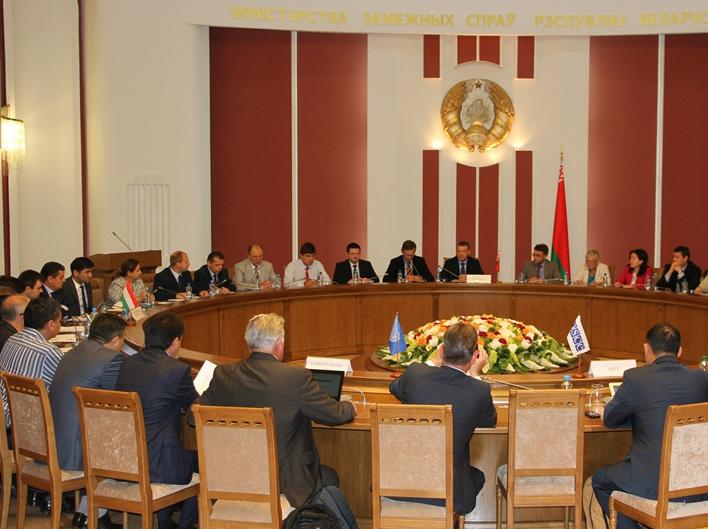
ABSTRACT
This article underscores the significance of United Nations Security Council resolution 1540 (2004) (UNSCR 1540), a pivotal UN resolution aimed at curbing the spread of weapons of mass destruction (WMDs). It highlights the supportive role played by the Organization for Security and Cooperation in Europe (OSCE) in ensuring its effective execution through productive peer review gatherings, collaborative endeavours involving numerous OSCE participating States. The article emphasizes the importance of regional collaboration and legislative improvements, particularly in areas such as export controls and biosecurity. By stressing the importance of OSCE-led peer reviews in facilitating the exchange of knowledge and best practices, the article underscores the reviews’ vital contribution to advancing global efforts in non-proliferation.
* The views expressed are those of the authors and do not necessarily reflect the official position of the OSCE.
92
Representatives of relevant ministries and other state agencies from Belarus, Kyrgyzstan and Tajikistan discuss progress on implementing provisions of UNSCR 1540, Minsk, 2 August 2016. Photo credit: MFA of Belarus/Alexandra Skoda
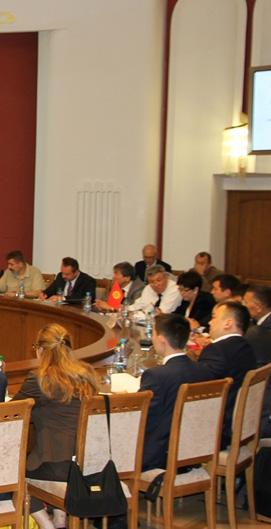
INTRODUCTION
Adriana Volenikova & Tynchtykbek Israiilov


Adriana Volenikova works for the OSCE as a Project Officer dealing with non-proliferation of WMDs. Since 2013, she has been responsible for assisting States with implementation of UNSCR 1540 and acts as a focal point in the OSCE Conflict Prevention Centre for all non-proliferation and 1540-related issues throughout the OSCE region.
Tynchtykbek Israiilov works for the OSCE Programme Office in Bishkek (POiB) as a National Border Management Officer. Since 2016, he has been responsible for POiB activities related to non-proliferation of WMDs,, small arms and light weapons, and border security and management.
On 28 April this year, the world marks the 20th anniversary of the adoption of United Nations Security Council resolution 1540 (2004) (UNSCR 1540)1. Adopted two decades ago, UNSCR 1540 represents a cornerstone in efforts by United Nations Member States to prevent the proliferation of weapons of mass destruction (WMD). The resolution estab1 Microsoft Word - 0432843E.doc (un.org)
lished binding obligations for all States aimed at preventing and deterring non-State actors from obtaining access to such weapons and related materials. Moreover, it required all UN Member States to adopt and enforce measures to prevent the acquisition and transfer of WMDs and their means of delivery by non-State actors.
In 2011, the UN Security Council passed UNSCR 1977,
which reaffirmed UNSCR 1540 and further emphasized cooperation with international, regional, and sub-regional organizations.
At the regional level, the participating States of the Organization for Security and Co-operation in Europe (OSCE) called upon all participating States to fully implement UNSCR 1540 by adopting a decision in the Forum for Security Co-op-
ARTICLE 93
THE AUTHORS:
eration (FSC)2 supporting its effective implementation. 3
The OSCE recalled States’ commitments in this regard, in particular, the OSCE Principles Governing Non-Proliferation adopted in 19944 and updated in 2013.5 In 2009, the Ministerial Council6 tasked the FSC to facilitate the fulfilment of UNSCR 1540 provisions by the OSCE participating States. 7 Furthermore, by adopting the 2009 Ministerial Council Declaration on Non-Proliferation, the participating States also pledged to facilitate implementation of the resolution by providing effective assistance to States that require it.8
In the Vilnius Ministerial Council Decision from 2011, the OSCE participating States expressed their support for maintaining the on-going activities supporting the implementation of UNSCR 1540, such as information sharing on national progress and lessons learned. In addition, the FSC was tasked to continue to identify and strengthen, as
and when appropriate, specific ways the OSCE could assist participating States, upon their requests, in the further implementation of UNSCR 1540, in close coordination with the 1540 Committee, to complement its efforts. And lastly, in 2015, the FSC adopted a Decision on “OSCE’s Role in Support of UNSCR 1540 (2004)”, which clearly outlined a role for the OSCE Secretariat Conflict Prevention Centre (CPC) in this regard.
THE ROLE OF THE OSCE
The OSCE, with its 57 participating States, has a comprehensive approach to security, which encompasses politico-military, economic and environmental, and human dimensions. This approach uniquely positions it to support the implementation of UNSCR 1540. The OSCE’s main activities in support of UNSCR 1540 are twofold: firstly, supporting national efforts in the implementation of UNSCR 1540. This includes various ca-
2 Forum for Security Co-operation | OSCE
3 Microsoft Word - fscej474.doc (osce.org)
4 NON-PROE.PDF (osce.org)
5 FSC.DEC/7/13 (osce.org)
6 Ministerial Councils | OSCE
7 MC.DEC/16/09 (osce.org)
8 MC.DOC/5/09 (osce.org)
pacity-building and awareness raising activities, as well as assistance with developing voluntary national action plans (NAP) and strengthening legislation. Secondly, the OSCE promotes regional co-operation on the implementation of UNSCR 1540. Through organizing various regional events, the OSCE aims to foster close collaboration among States to address transboundary proliferation issues.
OSCE-SUPPORTED PEER REVIEW MEETINGS
The OSCE is a platform for dialogue and cooperation on security, and its significant efforts in support of participating States include peer review meetings. These meetings are designed to foster mutual learning and support among States in their implementation of UNSCR 1540, and allow participating States to share experiences, best practices, and challenges in a constructive and cooperative environment. The process typically
Issue 1 | 20 YEARS OF RESOLUTION 1540 94
involves a reviewing State or States visiting the host country to assess its UNSCR 1540 implementation efforts, followed by recommendations and the sharing of expertise. Most importantly, these meetings are based on the principles of trust, openness and cooperation between participating States, which is crucial in the contemporary landscape of global security.
These peer reviews have proven to be highly effective. For example, a series of meetings between Central Asian States facilitated by the OSCE resulted in enhanced inter-agency cooperation and the development of NAPs for several participating States, as well as involvement of other OSCE countries such as Belarus and Mongolia. Such outcomes underscore the value of peer reviews in identifying gaps, fostering regional collaboration and building trust among States in implementing UNSCR 1540.
SETTING THE SCENE
From 16 to 18 December 2014, representatives from Kyrgyzstan and Tajikistan met in Bishkek, Kyrgyzstan to discuss the status of implementation, exchange best practices and improve their cooperation when implementing UNSCR 1540. The meeting resulted in the two countries conducting peer review visits to each respective country. Belarus was later invited to the peer review exercise, thus expanding the format from being bilateral to trilateral.
PEER REVIEW MEETING BETWEEN BELARUS, KYRGYZSTAN AND TAJIKISTAN IN MINSK
The peer review discussions in Minsk, from 2 to 5 August 2016, focused on sharing experiences in implementing UNSCR 1540, as well as legislative and regulatory measures related to non-proliferation. They also covered practical exchanges
on export control, biosecurity, and border controls, in alignment with UNSCR 1540. The trilateral peer review aimed to develop practical recommendations and draft documents to support the NAPs of Kyrgyzstan and Tajikistan, focusing on normative, legislative, practical, and technical aspects of UNSCR 1540. The meeting was the second event to be held in the OSCE region and in the world, and the first to be held in trilateral format.9
PEER REVIEW MEETING BETWEEN BELARUS, KYRGYZSTAN AND TAJIKISTAN IN DUSHANBE
From 2 to 4 August 2017, a follow-up peer review meeting was held in Dushanbe, Tajikistan. The three-day discussion was based on the recommendations from the August 2016 Minsk meeting and further focused on the national approaches to implementing the relevant operative paragraphs of UNSCR 1540.10
9 Representatives of Belarus, Kyrgyzstan and Tajikistan discuss implementing UNSCR 1540 at OSCE-supported meeting in Minsk | OSCE
10 UNODA-OSCE Project “Support of Regional Implementation of UNSCR 1540”: Peer-Review Meeting in Tajikistan - UNODA (unrcpd.org)
ARTICLE 95
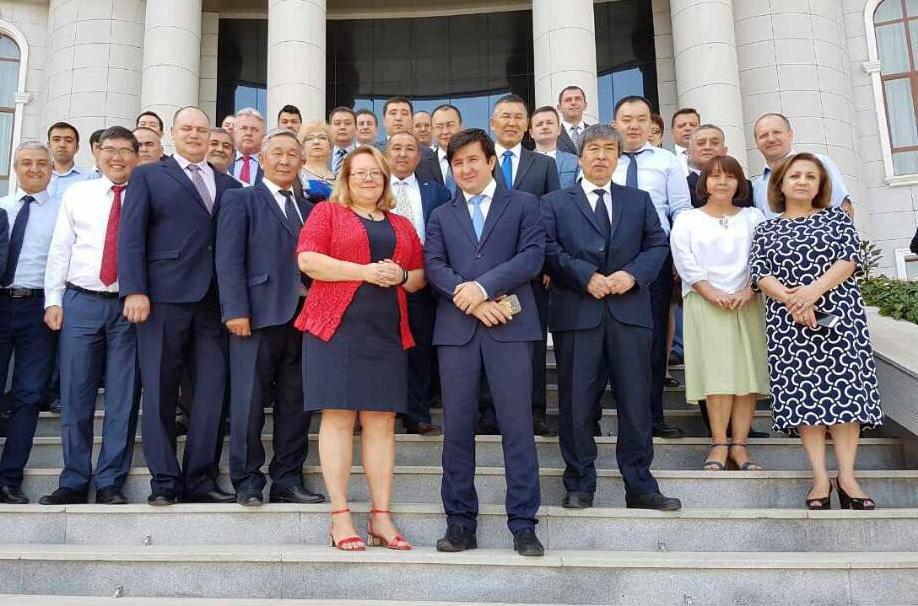
This included areas such as policymaking, legislative framework development, enforcement procedures, and effective practices outlined in the 1540 NAPs of the three States.
Furthermore, delegations extensively discussed export control issues, including national control lists and licensing systems, as well as relevant border control measures and the identifica-
tion of dual-use goods. They also looked at chemical and biological security issues, including the exchange of experiences and legal documents that could help improve national legislation and the regulatory frameworks of the participating States. Finally, participants had an opportunity to learn about practical implementation measures from Tajikistan through site visits to relevant facilities.
PEER REVIEW MEETING
IN 5+1 FORMAT: CENTRAL ASIA + BELARUS IN ISSYK-KUL
From 28 to 30 June 2018, Kyrgyzstan hosted a peer review meeting in Issyk-Kul, that included Belarus and Central Asian countries, in a six-party format for the first time.11
During the meeting, an idea to develop a “regional plan to
11 OSCE Programme Office in Bishkek supports Central Asian States and Belarus in joint efforts to strengthen implementation of UN Security Council Resolution 1540 | OSCE
Issue 1 | 20 YEARS OF RESOLUTION 1540 96
Participants of Dushanbe round of peer review meeting on UNSCR 1540, Dushanbe, 2 August 2017.
Photo credit: OSCE

promote implementation of UNSCR 1540” was discussed. It was suggested that such a regional plan would include both actual recommendations of past peer review meetings and new measures. Parties also discussed topics related to implementing the Biological Weapons Convention (BWC), the Chemical Weapons Convention (CWC) and strengthening national export control systems and improving cooperation in this field.
PEER REVIEW MEETING IN 5+1 FORMAT: CENTRAL ASIA + MONGOLIA IN ISTANBUL
The peer review meeting in Istanbul from 8 to 10 November 2022 was initiated by Kyrgyzstan and organized with the support of the OSCE.12 Following fruitful discussions, parties prepared a final document with a set of recommendations for implementing UNSCR 1540. Participants
reaffirmed the importance of a comprehensive approach to the implementation of UNSCR 1540, including through NAPs and regional cooperation on matters related to preventing the proliferation of WMDs. Additionally, the meeting discussed the results achieved on the recommendations from the Issyk-Kul round of peer review meetings in 2018.
12 OSCE-supported event enhances efforts of Central Asia and Mongolia to prevent the proliferation of weapons of mass destruction | OSCE
ARTICLE 97
Security Council hears briefing by Chair of OSCE; Credit: UN Photo/Evan Schneider
BEST PRACTICES AND LESSONS LEARNED
Key outcomes identified through the OSCE-supported peer review meetings include strengthening national legislation on export control, implementing the BWC and CWC, establishing effective control mechanisms over WMD-related materials, and enhancing both inter-agency coordination and regional cooperation. The meetings also highlighted the critical role of international cooperation and the need for continuous engagement with international partners, industry, and civil society.
In all peer review meetings, representatives of the 1540 Committee Group of Experts, as well as officials from other relevant international organizations such as the BWC Implementation Support Unit, the Organisation for the Prohibition of Chemical Weapons (OPCW), and others, were actively involved, ensuring close co -
ordination among the international organizations involved in the implementation of UNSCR 1540. This collaboration enhanced the effectiveness of implementing UNSCR 1540 and maximized joint efforts in addressing non-proliferation challenges globally.
However, challenges remain, particularly regarding resource constraints and the lack of specialized experts. The peer review process helped to identify these challenges, providing a basis for targeted assistance by the OSCE and other international actors.
CONCLUSION
Looking forward, it is essential for States to leverage the momentum generated by these meetings to enhance their implementation efforts. The international community, including the OSCE, United Nations or other actors should continue to support these endeavours, providing the necessary resources and expertise to ensure that UNSCR 1540’s objectives are fully implemented.
The OSCE’s engagement in facilitating peer review meetings is a significant part of global efforts to implement UNSCR 1540 effectively. These meetings allow participating States to share best practices, challenges, and lessons learned in the implementation process, which will undoubtedly play a crucial role in shaping the global non-proliferation landscape.
The implementation of UNSCR 1540 is a continuous process that requires sustained effort and cooperation at both the national and international levels. The OSCE-supported peer review meetings have emerged as a best practice in facilitating this process, offering a model that other regions and international organizations could replicate.
The OSCE-supported peer review meetings have emerged as a best practice [...], offering a model that other regions and international organizations could replicate
Issue 1 | 20 YEARS OF RESOLUTION 1540 98
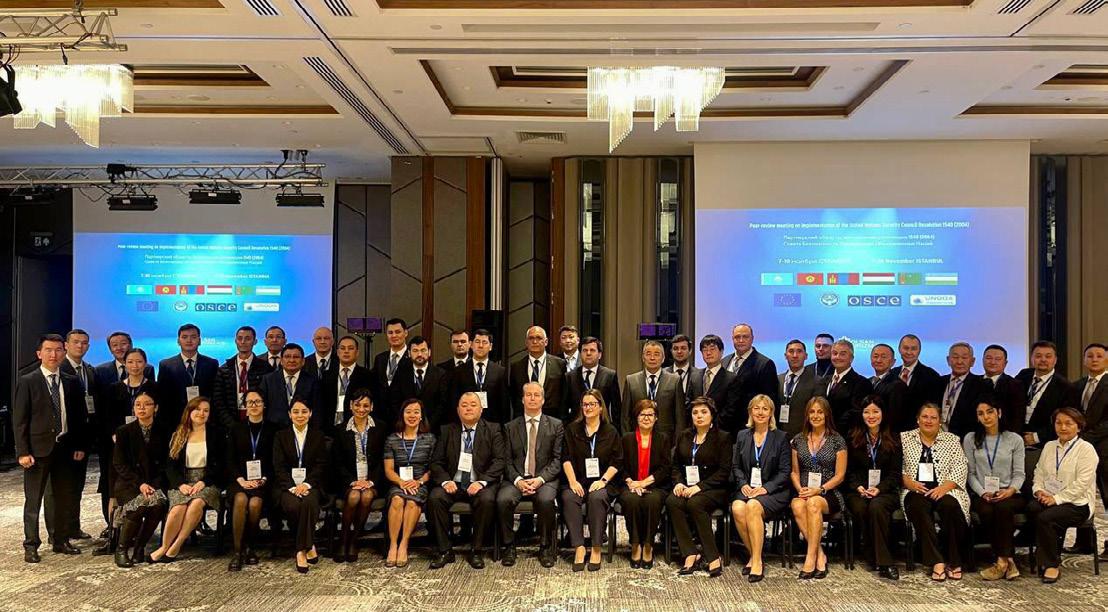
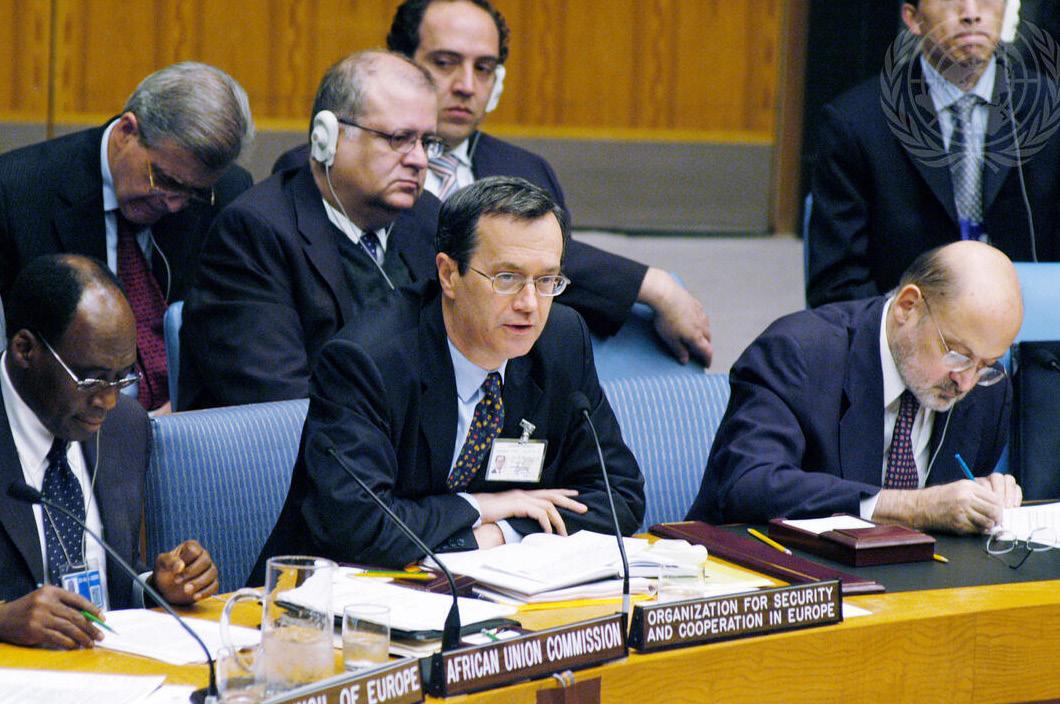
ARTICLE 99
Former Secretary-General of the OSCE at a meeting with the Security Council, urging closer cooperation between UN and regional organizations; Credit: UN Photo/Paulo Filgueiras
Participants at the peer review meeting in Istanbul, 8–10 November 2022. Photo credit: OSCE
STRENGTHENING GLOBAL CHEMICAL SECURITY: THE PIVOTAL ROLE OF THE FBI’S CHEMICAL AND BIOLOGICAL COUNTERMEASURES UNIT IN
SUPPORTING RESOLUTION 1540
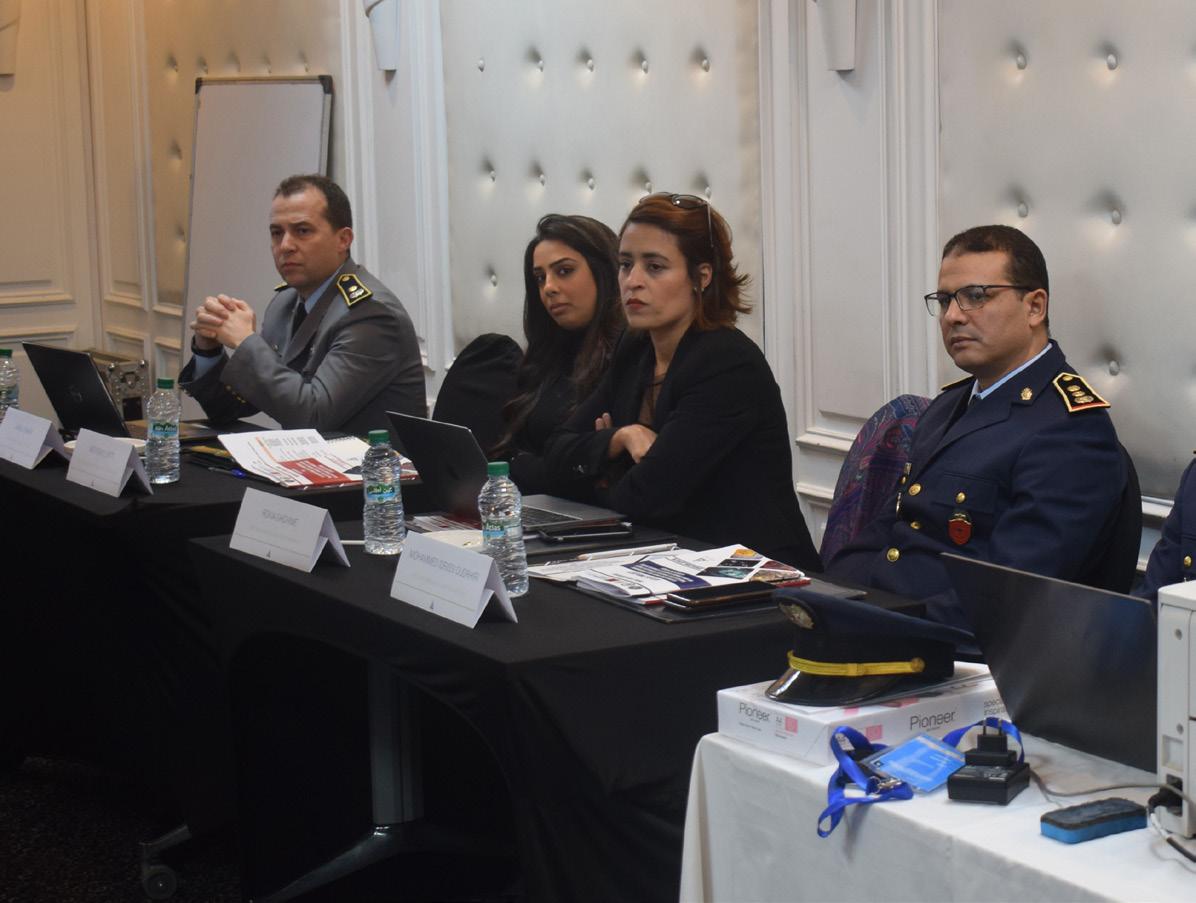
ABSTRACT
This article explores the multifaceted role of the Chemical and Biological Countermeasures Unit (CBCU) within the Weapons of Mass Destruction Directorate (WMDD) at the Federal Bureau of Investigation in supporting and advancing the goals of United Nations Security Council resolution 1540 (2004). The contribution will analyse various CBCU initiatives, including the Livewire Tabletop Exercise programme, the Global Congress on Chemical Security and Emerging Threats, and collaborations with the United Nations Interregional Crime and Justice Research Institute (UNICRI). This article highlights the impact of CBCU’s efforts on strengthening chemical security and building the capabilities of security personnel worldwide to prevent chemical weapons attacks.
100
Participants at a meeting of the ATLAS project in Morocco; Credit: MFA of Morocco
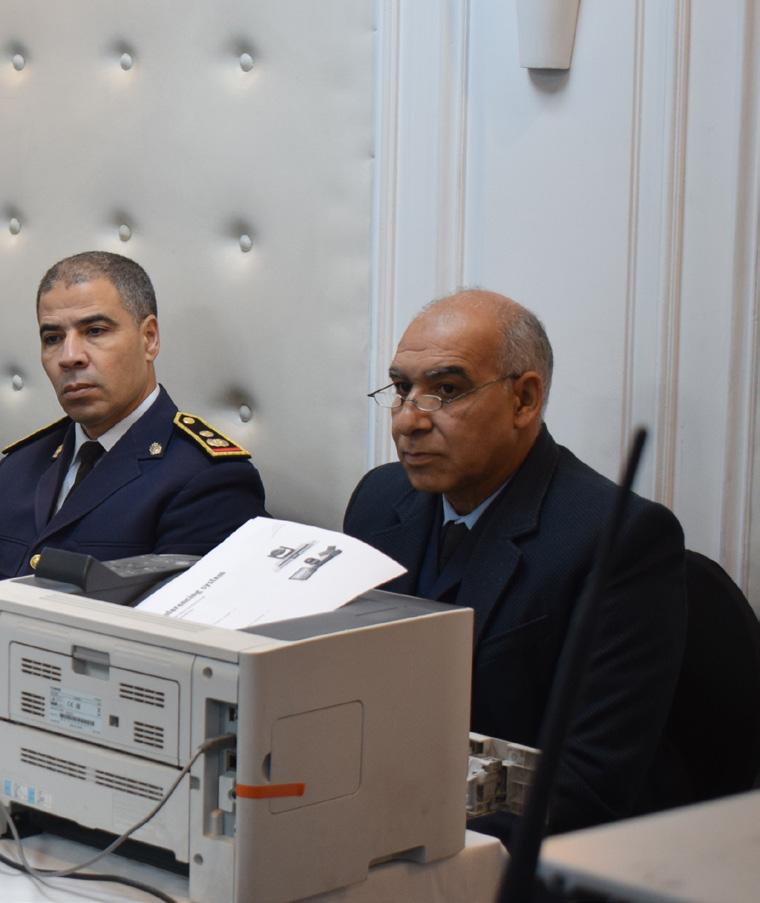
INTRODUCTION
Resolution 1540, adopted by the United Nations Security Council 20 years ago, is a crucial framework for preventing the proliferation of chemical, biological, and nuclear weapons. The Chemical and Biological Countermeasures Unit (CBCU) of the Federal Bureau of Investigation (FBI) has played a key role in supporting its implementation through various initiatives, highlighting the importance of internation -
al collaboration in enhancing chemical security. This includes training workshops, table-top exercises, and knowledge-sharing activities to strengthen the capabilities of international authorities in managing and responding to chemical security threats.
CBCU’S CONTRIBUTION TO RESOLUTION 1540
Resolution 1540 aims to prevent the proliferation of weapons of mass destruc -

Allison Kirshner is a Supervisory Special Agent in the Weapons of Mass Destruction Directorate at the FBI. As part of her role within the Chemical and Biological Countermeasures Unit, she oversees several critical programmes aimed at countering chemical threats that are implemented both in the US and internationally.
tion (WMDs), their means of delivery, and related materials to non-State actors. The following are the ways CBCU plays a crucial role in supporting the implementation of resolution 1540 through various initiatives and collaborations.
LIVEWIRE TABLETOP EXERCISE PROGRAMME
The Livewire Tabletop Exercise (Livewire TTX) programme is the cornerstone of CBCU’s
ARTICLE 101 THE AUTHOR:
Allison Kirshner
efforts to help high-risk chemical facilities assess the preparedness of the personnel they employ. It plays a crucial role in assessing preparedness by simulating realistic scenarios and evaluating the response of personnel and the local first responder community.
The Livewire TTX provides a safe and controlled environment to identify potential gaps or weaknesses in response plans and communication protocols. During the Livewire TTX, participants are presented with hypothetical scenarios related to chemical security incidents. These scenarios may involve the release or threat of chemical agents, sabotage attempts, or other potential risks. Participants then work together to analyse the situation, discuss response strategies, and make decisions according to their roles and responsibilities.
Through this interactive exercise, the Livewire TTX helps to identify areas of improvement and seeks to enhance the overall preparedness and effectiveness of the participants in responding to chemical security incidents. By working together during the exercises, participants can
enhance their understanding of each other’s roles and responsibilities, improve communication, and develop effective coordination mechanisms. By sharing lessons learned and successful strategies, participants can adopt approaches to enhance their response capabilities.
GLOBAL CONGRESS ON CHEMICAL SECURITY AND EMERGING THREATS
CBCU contributes to implementing resolution 1540 through its involvement in the Global Congress. CBCU and its co-implementing partners, INTERPOL, the Cybersecurity and Infrastructure Security Agency (CISA), and the Defense Threat Reduction Agency (DTRA), organize panel discussions and presentations on chemical security. These discussions facilitate knowledge sharing and strengthen international cooperation in addressing emerging threats in chemical security. The Global Congress brings together government agencies, industry representatives, experts, and international organizations to foster dialogue, exchange emerging threat information, and promote cooperation in chemical security.
The Global Congress acts as a forum for participants to share their experiences, success stories, and lessons learned in chemical security. By exchanging knowledge, attendees can gain insight into effective strategies, innovative technologies, and approaches to enhance chemical security. Global Congress members can establish connections, build partnerships, and explore avenues for joint initiatives to address common challenges. It plays an important role in identifying emerging threats, including new technologies and evolving terrorist tactics. By discussing and analysing emerging threats, members can stay updated on the latest trends and developments, enabling them to adapt and respond effectively.
COLLABORATION WITH UNICRI
CBCU collaborates with the United Nations Interregional Crime and Justice Research Institute (UNICRI) to conduct trainings focused on intelligence-led operations and investigations to disrupt potential chemical weapons attacks, building the capabilities of security personnel in Morocco and Tunisia. A train-the-trainers course was held, covering
Issue 1 | 20 YEARS OF RESOLUTION 1540 102
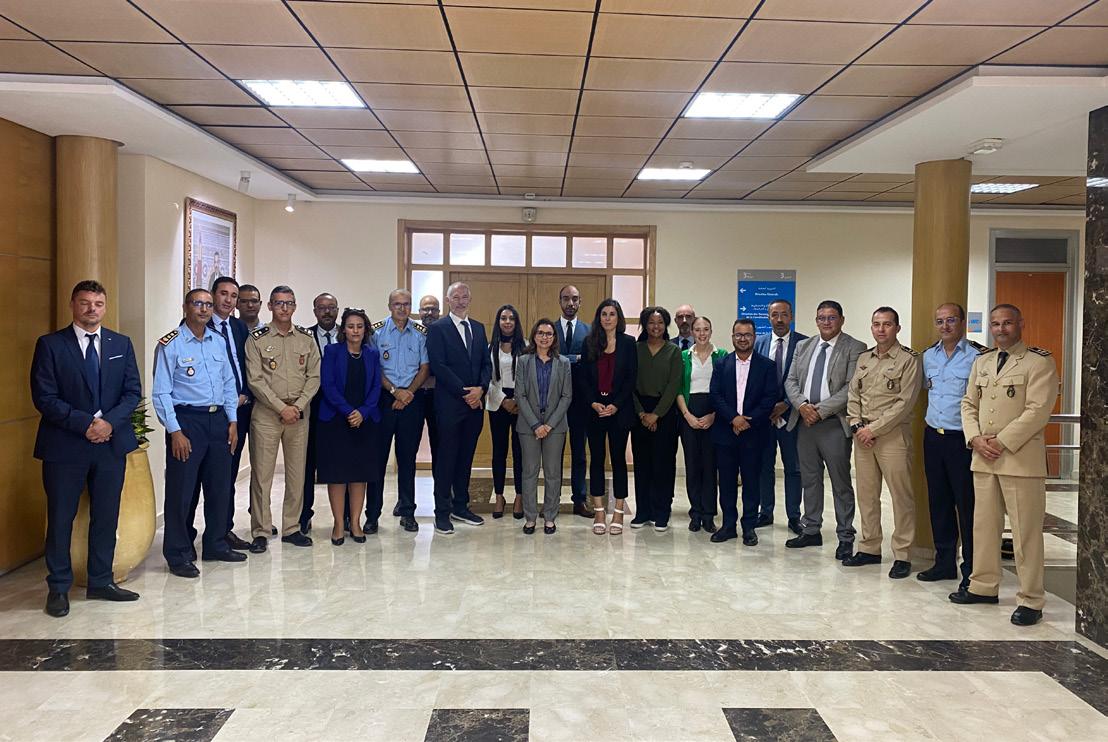
topics such as financial intelligence, acquisition of chemical warfare agents, and strategies employed by non-State actors in selecting targets. Following the course, the Moroccan team successfully conducted a comprehensive national training event, organized and delivered by the trained Moroccan experts. The event included modules and exercises on national and international legal frameworks, the chemical terrorist threat, cybersecurity, border control, and response to a chemical event. The collaboration emphasized inter-agency cooperation and a unified
response to terrorist threats. Enhanced inter-agency collaboration was observed, with participants gaining awareness and engagement with the National Authority for Financial Intelligence.
CHALLENGES AND FUTURE DIRECTIONS
Implementing initiatives to support resolution 1540 faces various challenges. Some of the challenges include limited resources, lack of technical expertise, and coordination among different stakeholders. Many countries, particu -
larly developing nations, need more support in implementing comprehensive chemical security measures. Lack of resources can hinder the establishment of effective regulatory frameworks, training programmes, and the acquisition of necessary equipment. CBCU collaborates with domestic and international partners to leverage their expertise, resources, and funding. By forging partnerships, CBCU can leverage resources and knowledge to support countries with limited capabilities.
ARTICLE 103
A meeting of the ATLAS project in Morocco; Credit: MFA of Morocco

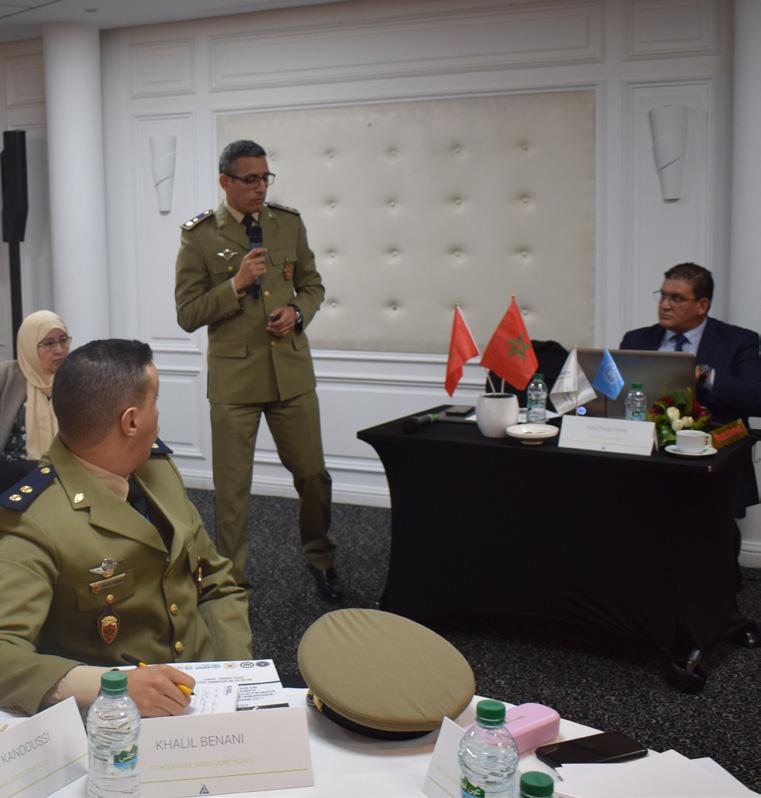
To address the rapidly evolving threat landscape, CBCU actively monitors and analyses emerging trends, technologies, and threats in the chemical security domain. By staying informed, CBCU can provide timely guidance and assistance to domestic and international partners to address emerging challenges.
Collaboration between governments and industry stakehold-
ers is essential in strengthening chemical security. Public-private partnerships facilitate the sharing of industry expertise and resources to enhance chemical security measures. Knowledge-sharing and training programmes are vital for building and maintaining chemical security capacities. CBCU has expanded its training programmes to reach more countries, particularly those with limited resources,
to enhance their chemical security management and response capabilities. Equally, embracing emerging technologies, such as artificial intelligence, machine learning, and data analytics, can significantly enhance chemical security measures. CBCU has explored partnerships with research institutions through its Academic Advisory Group (AAG) to develop advanced tools for risk assessment, detection, and response.
THE IMPACT OF CBCU ON CHEMICAL SECURITY
Ensuring chemical security and preventing the misuse of chemicals for nefarious purposes is a critical global concern. One of the tangible impacts of CBCU’s work includes its collaboration with chemical retailers. This collaboration has resulted in positive outcomes, particularly in outreach programmes to retail stores that sell precursor chemicals that can be used to make improvised explosives. As a result of CBCU’s outreach initiative, businesses proactively reach out to the FBI whenever they encounter suspicious purchases. This proactive approach plays a crucial role in preventing illicit trafficking, mitigating the risk
Issue 1 | 20 YEARS OF RESOLUTION 1540 104
A presentation during a meeting of the ATLAS project in Morocco; Credit: MFA of Morocco
of terrorist attacks involving chemical weapons, and safeguarding the global chemical supply chain.
The Chemical & Equipment Outreach (CEO) programme is an exhilarating multi-agency initiative that brings together chemical equipment manufacturers, distributors, retailers, and online resellers. Its mission is to uncover and gather intelligence on the sale of materials that could potentially be used to create chemical weapons and toxic industrial chemicals. CEO acts as a dynamic platform for collaboration between the FBI and the private sector, fostering the exchange of knowledge and expertise to tackle the ever-present chemical weapons threat. This ground-breaking programme also serves as a pioneering model for international law enforcement partnerships, paving the way for similar engagements worldwide.
The FBI’s explosive precursor chemical (EPC) programmes include the Chemical Industry Outreach Workshop (CIOW), which aims to educate industry, academia, and local law enforcement about the potential misuse of locally sourced products for explosive purposes. The one-day
workshop provides in-depth training on identifying and addressing threats associated with EPCs. The CIOW engages upper-level management within the chemical industry, promoting a top-down approach to addressing the risks posed by EPCs. Participants gain insights into the FBI’s role in prevention and the importance of cooperation between industry and law enforcement. The workshop also features live demonstrations with locally sourced EPCs, highlighting the dangers and encouraging industry participants to report any suspicious activity to the FBI.
The FBI’s EPC Online Retail Tripwire programme focuses on mitigating the threat posed by the online sale of precursor chemicals used in the production of explosives. Recent trends have indicated an increase in individuals purchasing EPCs through online marketplaces and retailer websites. To confront this escalating threat, the FBI collaborates with EPC retailers to develop proactive tripwires for reporting suspicious purchases of EPCs on their platforms. By using advanced data analysis and algorithms, the programme identifies groups of chemicals that can
be weaponized. This information enables the FBI to generate critical leads and launch investigations into potential threats. The programme has already yielded significant results, with suspicious purchases identified and reported, thereby significantly reducing the risk associated with bomb-making materials.
CONCLUSION
The vital role of CBCU in supporting resolution 1540 and the broader global efforts to strengthen chemical security cannot be understated. Continued commitment to combat chemical threats and international cooperation will be crucial in achieving these goals. CBCU’s initiatives enhance chemical security and prevent proliferation by strengthening preparedness, improving coordination among stakeholders, and addressing chemical industry and law enforcement vulnerabilities. By organizing global conferences and collaborating with international partners, CBCU plays a vital role in supporting the implementation of measures outlined in resolution 1540 and ensuring a safer and more secure world.
ARTICLE 105

UPCOMING

May 2024
Vienna, Austria (Europe/International)
20/ 24
International Conference on Nuclear Security: Shaping the Future
Organizer: IAEA
Held once every four years, the conference provides a global forum for ministers, policymakers, senior officials and nuclear security experts to share information and best practices.
27/ 30
Sofia, Bulgaria (Europe/International)
Global Geiger Conference
Organizer: INTERPOL
The Global Geiger Conference is the most important information sharing event of INTERPOL in the field of nuclear security. It provides an opportunity for law-enforcement and other experts from targeted regions to meet and discuss good practices and challenges related to the information sharing in the field of the prevention, detection, response, and investigation of crimes involving radioactive materials. Delegations from around 35 countries are invited to the event from the following regions: Black Sea and Caucasus | Central Asia | Southeast Asia | Southern Africa. International and partner organizations are also attending the conference as observers.
Manila, Philippines (Asia)
21/ 23
Gaborone, Botswana (Africa)
National Consultative Workshop on Strengthening Export and Border Controls in Botswana in Compliance with UNSCR 1540
Co-organizers: UNODA and Stimson Center
Aims to enhance understanding among the national regulatory and law enforcement authorities on the resolution’s provisions relating to border and export controls of dualuse items and to determine action required to strengthen these measures.
28/ 29 12/ 13
1st 1540 Peer Review Roundtable on Export Controls
Organizer: UNODA
The first in a series of two peer review sessions for the Philippines, Singapore, Palau and Japan (Observer) on the implementation of UNSCR 1540 with a focus on export controls.
June 2024
Quito, Ecuador (Latin America and Caribbean)
1540 NAP Workshop
Organizer: UNLIREC
Focuses on the development of a voluntary national action plan for the implementation of UNSCR 1540.
106
2024 July 2024 11/ 12 05/ 09 TBC 24/ 25
25/ 28 26/ 27
Lilongwe, Malawi (Africa)
Workshop to Review and Advance the Implementation of CBRN Safety, Security and Nonproliferation Instruments in Malawi
Co-organizers: UNODA, BWC-ISU, UNICRI and the CBRN Centers of Excellence Initiative
Aims to raise awareness among a broad range of national stakeholders on the CBRN security and non-proliferation instruments and review the implementation of national plans developed within the context of UNSCR 1540 and the CBRN Centres of Excellence Initiative.
Beijing, China (Asia)
Training Course for 1540 Points of Contact in the Asia-Pacific Region
Organizer: UNODA
The fourth PoC regional training in China to enhance understanding of the resolution and the tools available to support its implementation, as well as to empower and strengthen the network of 1540 Points of Contact throughout Asian and Pacific States.
Singapore (Asia)
ASEAN Regional Forum
Co-chairs: Republic of Singapore and the European Union
Focuses on “Detection, Response and Deterrence of Chemical, Biological and Radiological (CBR) Incidents” to provide an opportunity to discuss common challenges in preventing, detecting, and responding to CBR incidents and emerging risks.
Bali, Indonesia (Asia)
Workshop on Promoting National Awareness of UNSCR 1540 (2004) in the Republic of Indonesia
Organizer: UNODA
Raises awareness on UNSCR 1540 by providing an overview of the resolution with a focus on its relevance to national security and international peace.
August
Antananarivo, Madagascar (Africa)
National Consultative Meeting on Strengthening Export and Border Controls in Madagascar to Prevent Illicit Trafficking of Dual-Use Items
Organizer: UNODA
Aims to support Madagascar in determining action required to strengthen its border and export control system in line with UNSCR 1540 and initiate a process for developing and adopting a national control list.
Astana, Kazakhstan (Central Asia)
Wiesbaden Regional Industry Outreach
Co-organizers: UNODA and BAFA (Germany)
UNSCR 1540 regional industry outreach conference (Wiesbaden Process) for Central Asian States.
107
SAVE DATE THE

1540 Open Briefing – OCTOBER 2024
As discussed during the 101st Meeting of the 1540 Committee convened on 22 March 2024, the Committee plans to schedule an open briefing in October 2024 for Member States and international, regional and subregional organizations, inter alia.
Training Course for 1540
Points of Contact in the Africa Region – NOVEMBER 2024
Addis Ababa, Ethiopia (Africa) | Organizer: UNODA
Aims to enhance the capacity of PoC on UNSCR 1540 and its implementation to discharge their roles at the national level, to facilitate the exchange of experiences and to promote cooperation at the regional level.
Global ‘Erlangen Initiative’ Conference – NOVEMBER 2024
Germany (Europe/International) | Co-organizers: UNODA and BAFA (Germany)
An academia outreach platform on engagement in multilateral export controls and effective approaches to implementing United Nations Security Council resolution 1540.
108
NOTIFICATIONS
GLOBAL PARTNERSHIP

NONPROLIFERATION AND STRATEGIC TRADE KNOWLEDGE HUB
Effective implementation of UNSCR 1540 benefits from stakeholders having access to up-to-date and quality resources and best practices.
To support this need, the Global Partnership Nonproliferation and Strategic Trade Knowledge Hub serves as a comprehensive, up-to-date, publicly available, and easily searchable library that enables users to be connected to resources on non-proliferation and strategic trade topics, covering the nuclear, chemical, biological, and means of delivery spectrum, as well as export controls and compliance.
The Hub contains a comprehensive collection of UNSCR 1540-related resources and best practices, including relevant international, regional, and national legislation and enforcement resources, best practices, technical databases, research reports, codes of conduct, guides, newsletters, courses, and handbooks.
The Global Partnership Nonproliferation and Strategic Trade Knowledge Hub was developed and is maintained and updated by the Strategic Trade Research Institute (STRI) and is supported by the United Kingdom’s Counter-proliferation and Arms Control Center (CPACC), with technical and IT support provided by United States Pacific Northwest National Laboratory (PNNL).
INTERPOL LAUNCHED BIOTRACKER
INTERPOL National Central Bureaus are invited to join this initiative as an innovative analytical and investigative tool to enhance law enforcement capabilities to prevent non-State actors from acquiring, developing and using biological agents, toxins and weapons.
On 4 January 2024, INTERPOL created its 10th Criminal Analysis File: BioTracker. By joining this initiative, INTERPOL member countries will benefit from an innovative tool to detect, deter, prevent and combat the illicit trafficking of biological weapons and will take a step forward in line with operative paragraph 3(c) of UNSCR 1540. Indeed, by collecting and analysing information on biological threats and incidents, INTERPOL is able to transform data into actionable information. In this context, countries joining the initiative will benefit from early-warning notifications, a data visualization interface, and strategic and operational analytical reports. BioTracker will, thus, enable law enforcement agencies to identify biological threats, crime trends and criminal networks, including the intent and capabilities of non-State actors to acquire, develop and use biological agents, toxins and weapons.
109






 ACTING DIRECTOR, UNICRI
Leif Villadsen
ACTING DIRECTOR, UNICRI
Leif Villadsen


























 Under the leadership of Dr Nsouli, and funded by the Service for Foreign Policy Instruments of the European Commission, ARZ 2023 (pictured) was a field exercise co-organized by UNICRI and the On-Site Assistance Expert for the Middle East Regional Secretariat; Credit: EU/ Joe Saliba
Under the leadership of Dr Nsouli, and funded by the Service for Foreign Policy Instruments of the European Commission, ARZ 2023 (pictured) was a field exercise co-organized by UNICRI and the On-Site Assistance Expert for the Middle East Regional Secretariat; Credit: EU/ Joe Saliba











 An uncrewed aerial vehicle (drone) in flight; Credit: Mitch Nielsen
An uncrewed aerial vehicle (drone) in flight; Credit: Mitch Nielsen


















 • OPCW Director-General and Ms Izumi Nakamitsu, Under-Secretary-General and High Representative for Disarmament Affairs, United Nations, at the OPCW. Credit: OPCW
• OPCW Director-General and Ms Izumi Nakamitsu, Under-Secretary-General and High Representative for Disarmament Affairs, United Nations, at the OPCW. Credit: OPCW
































